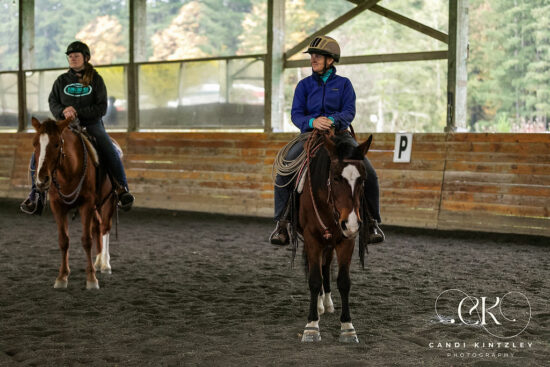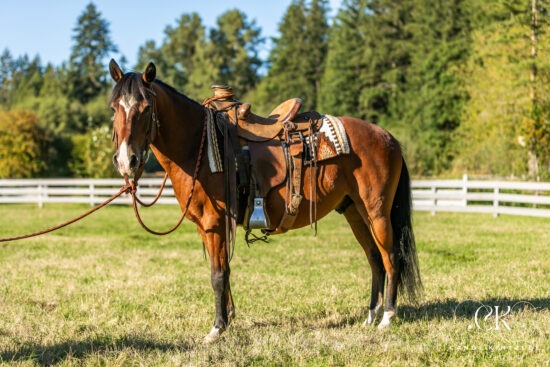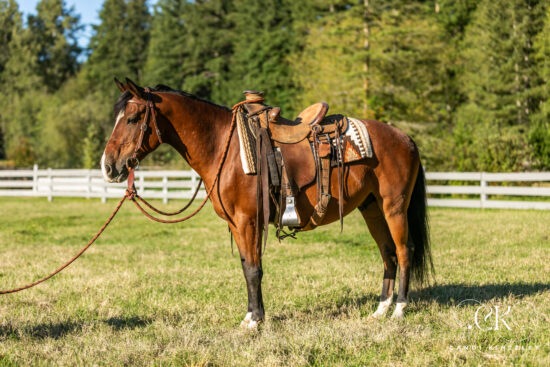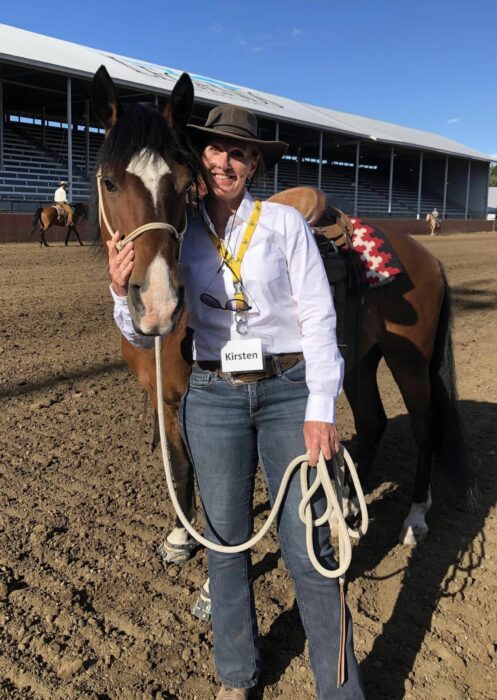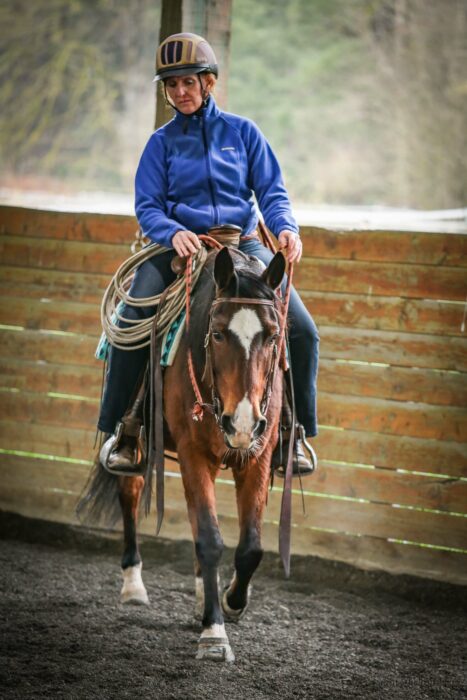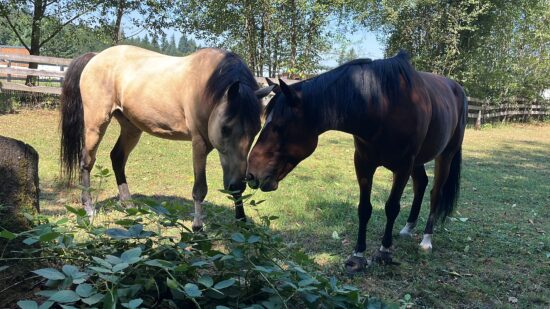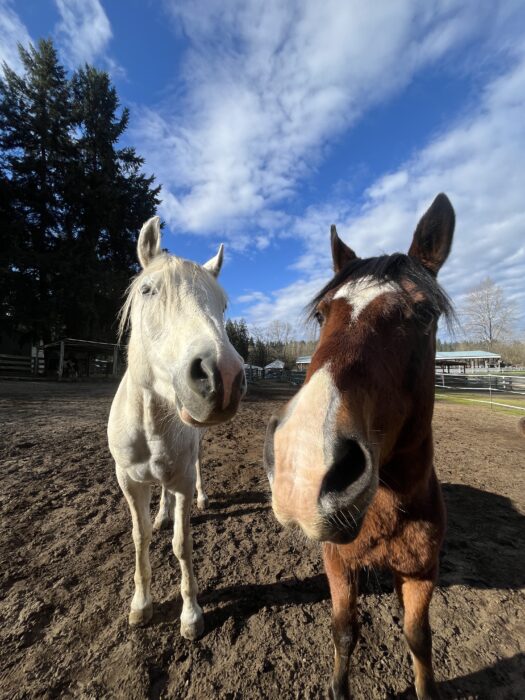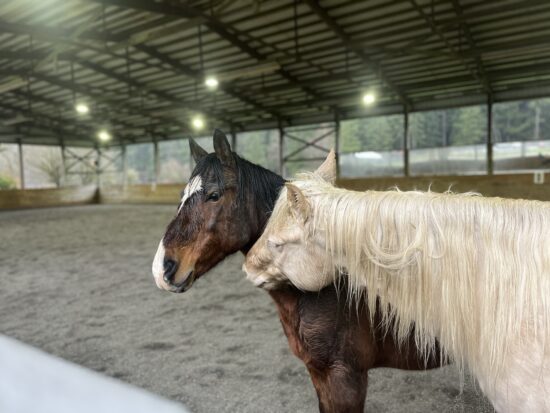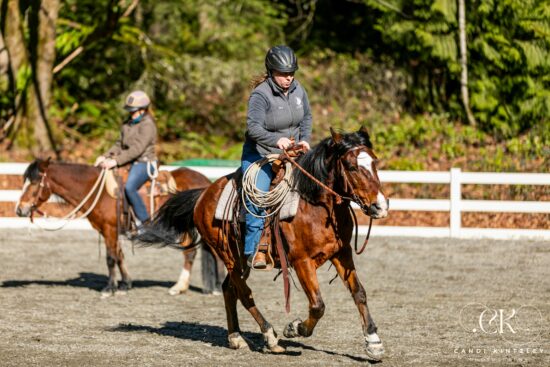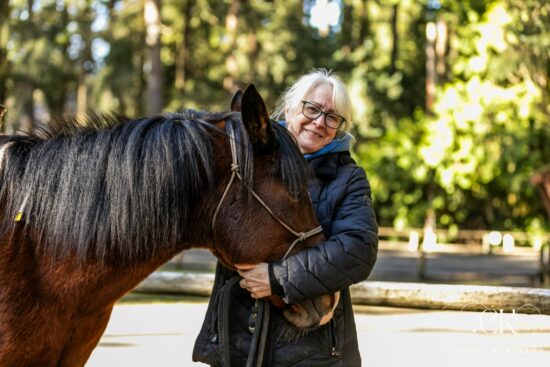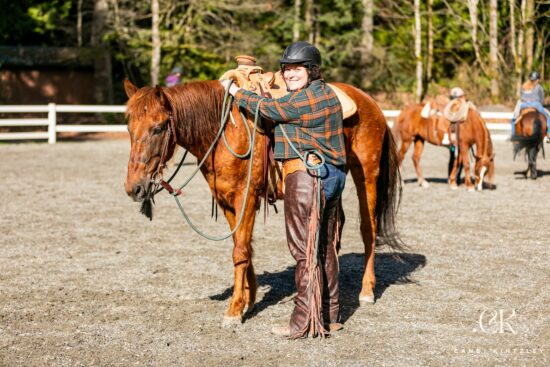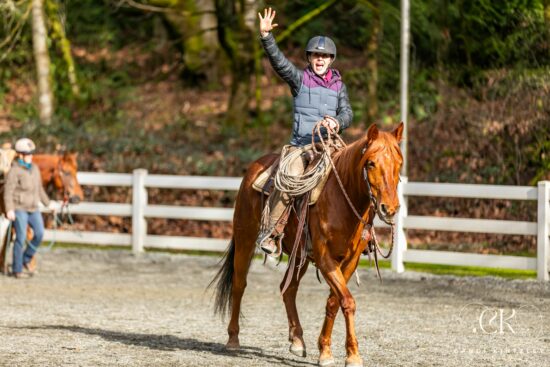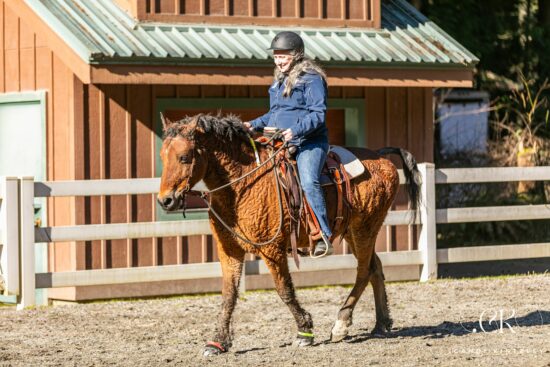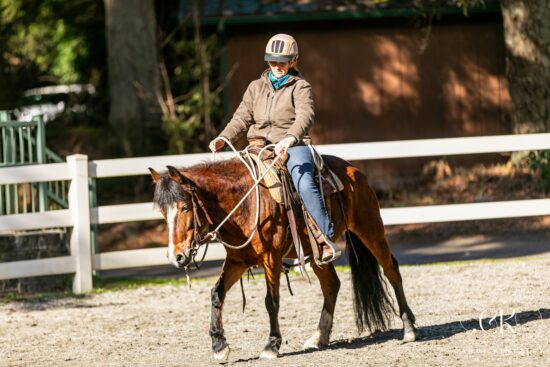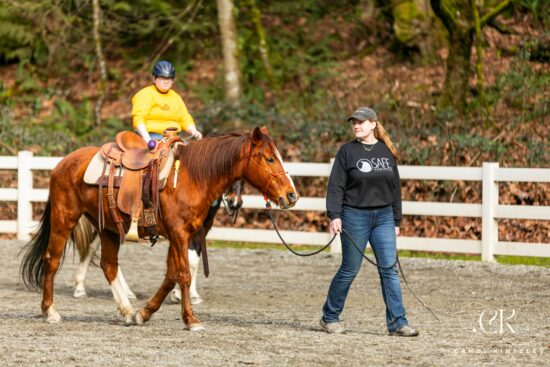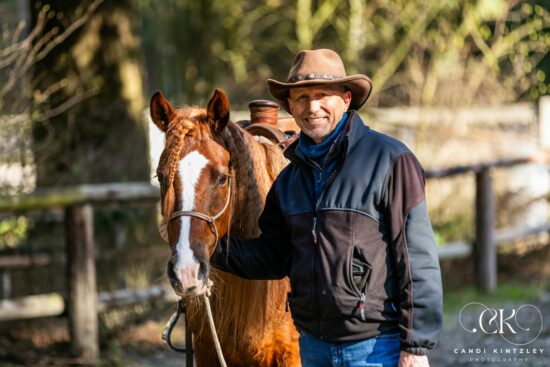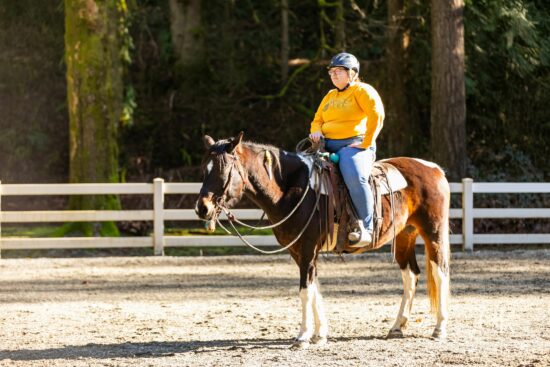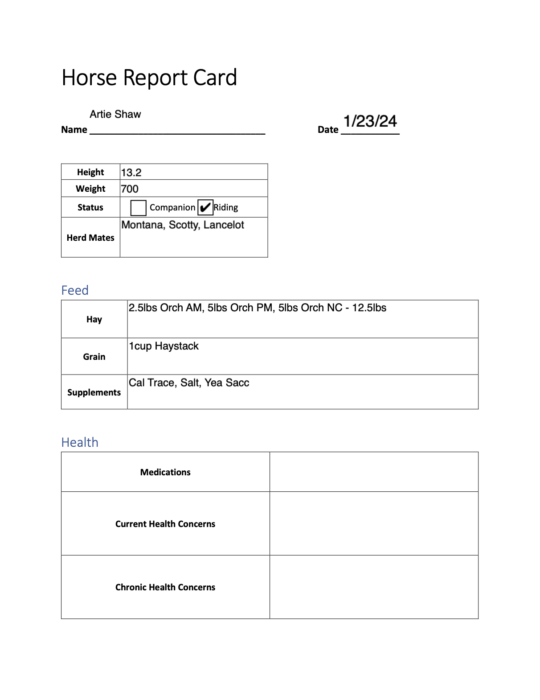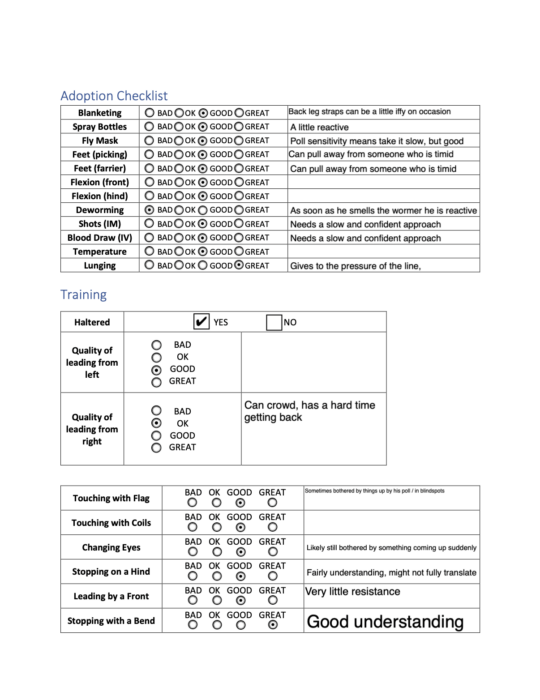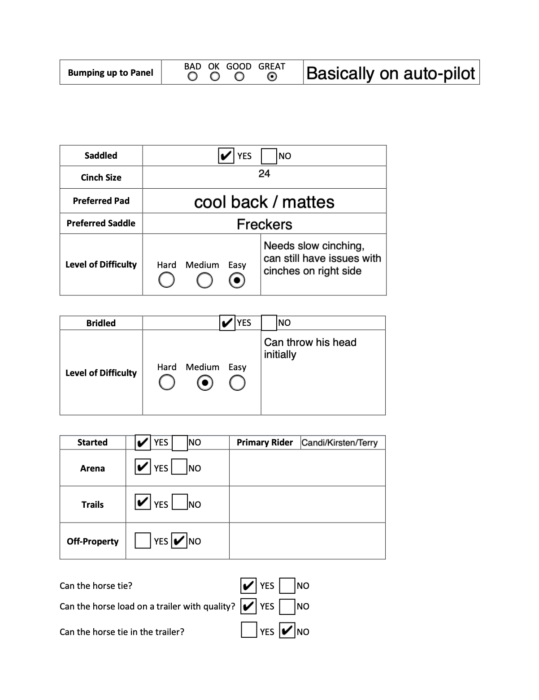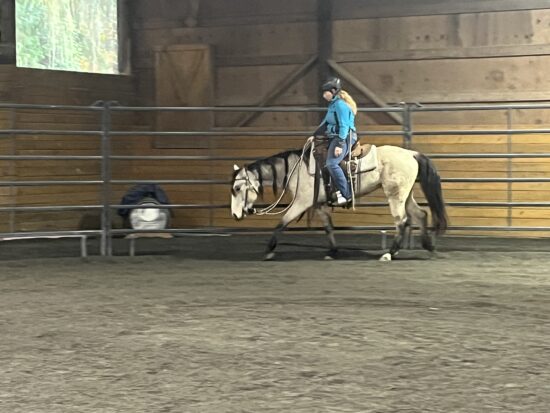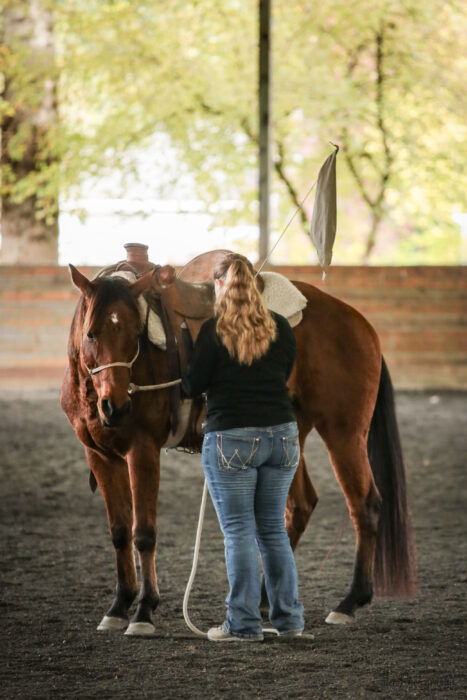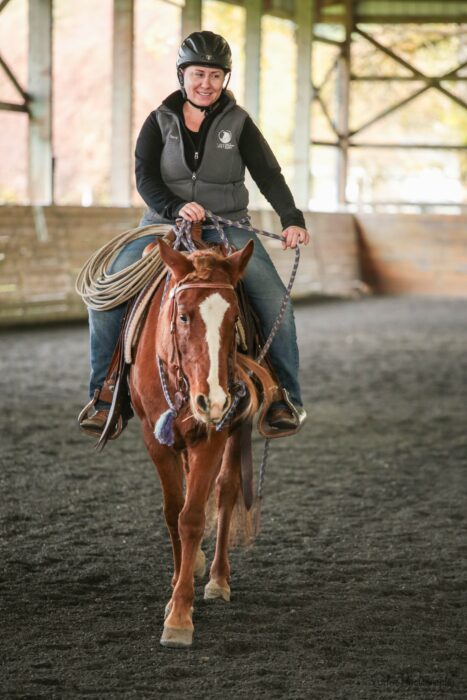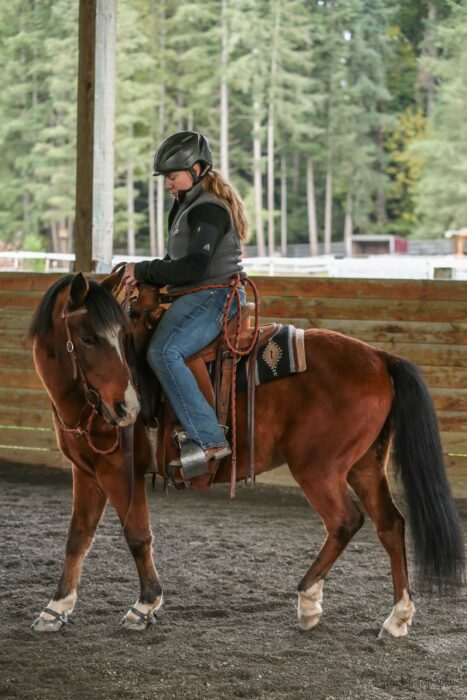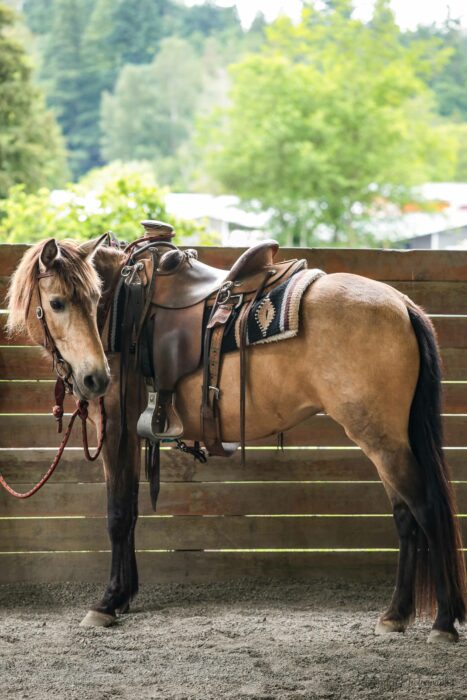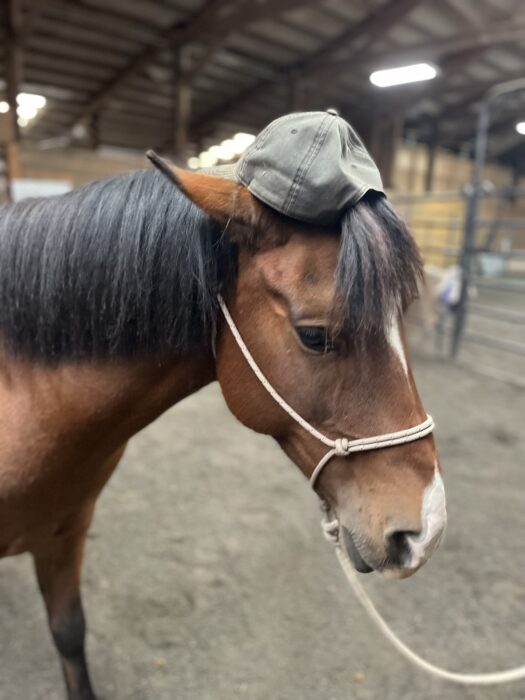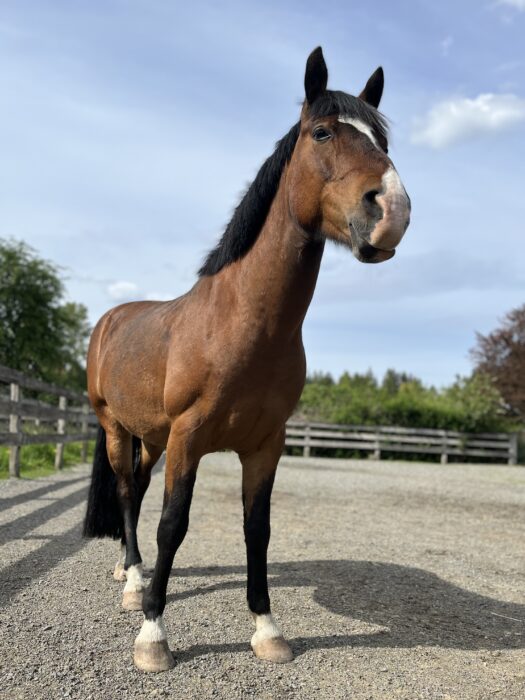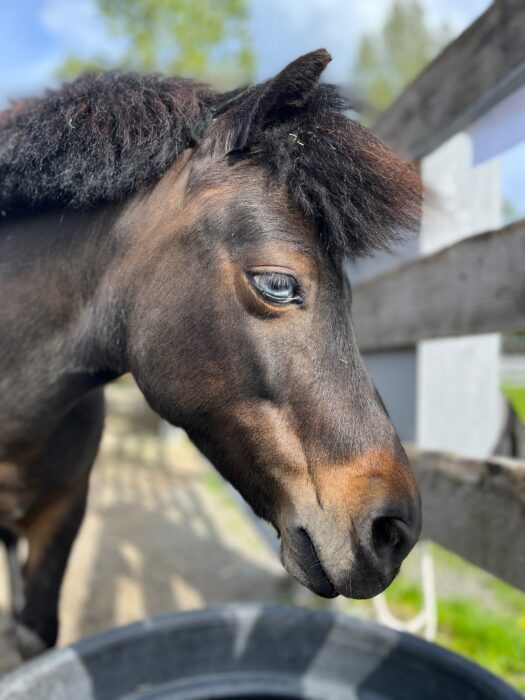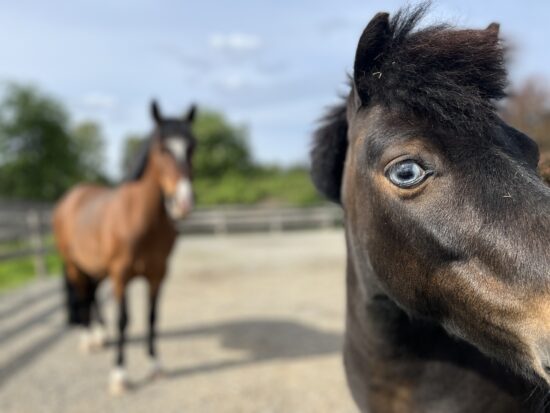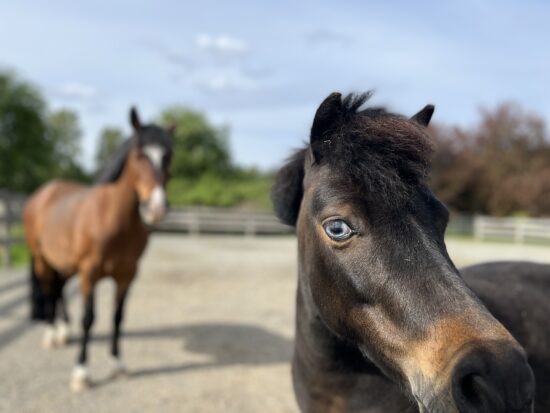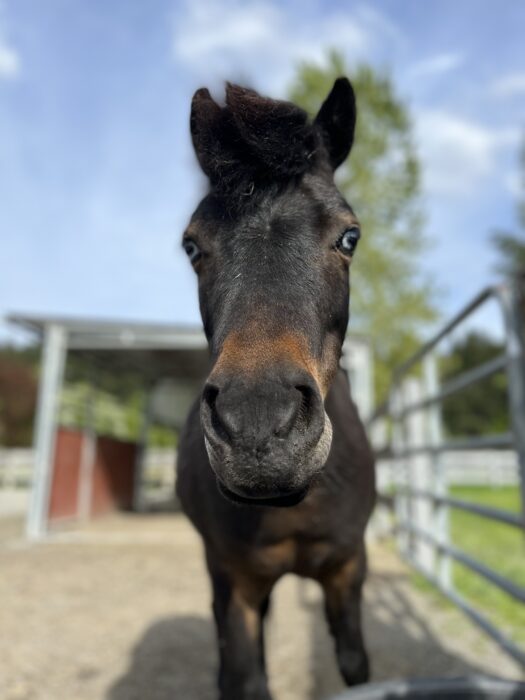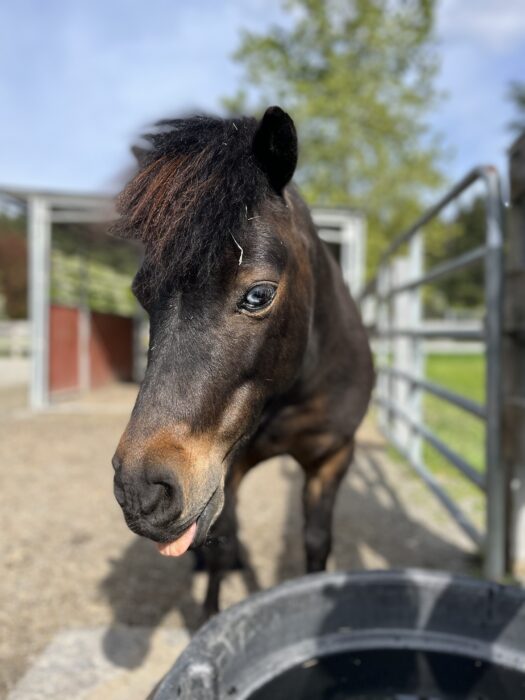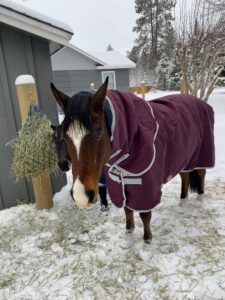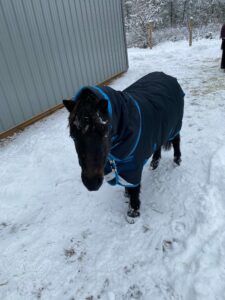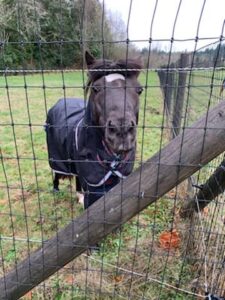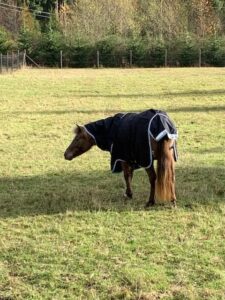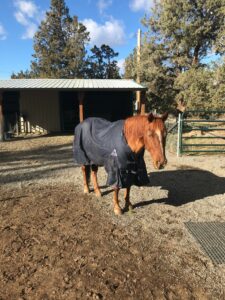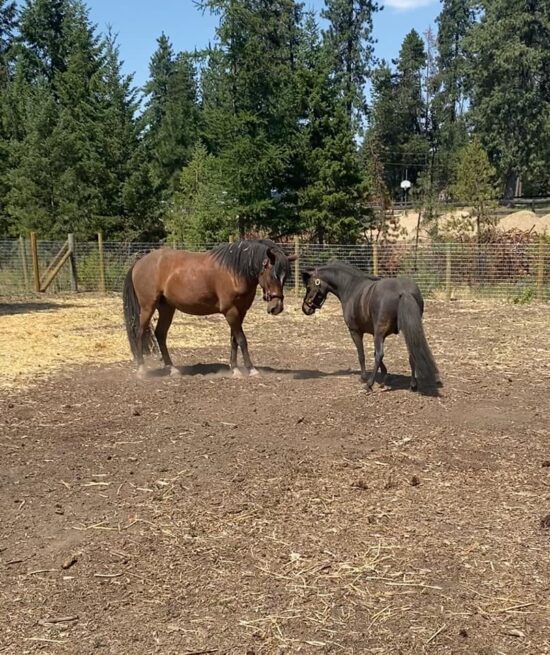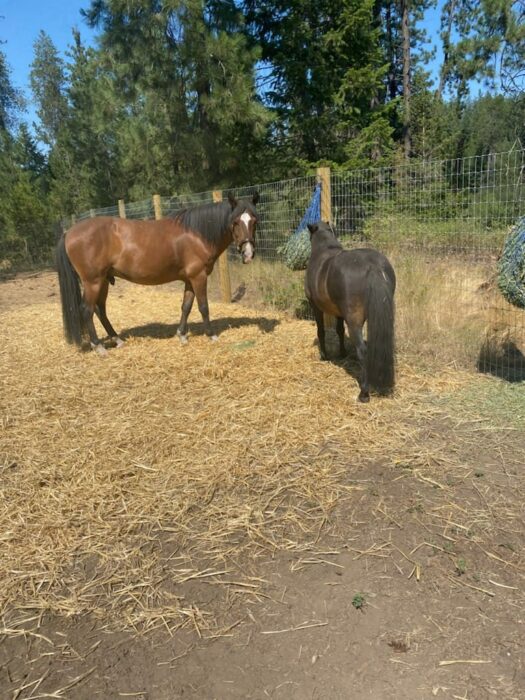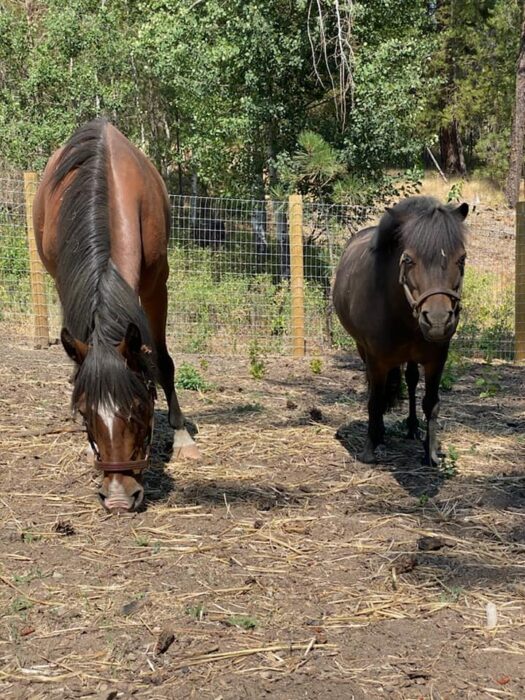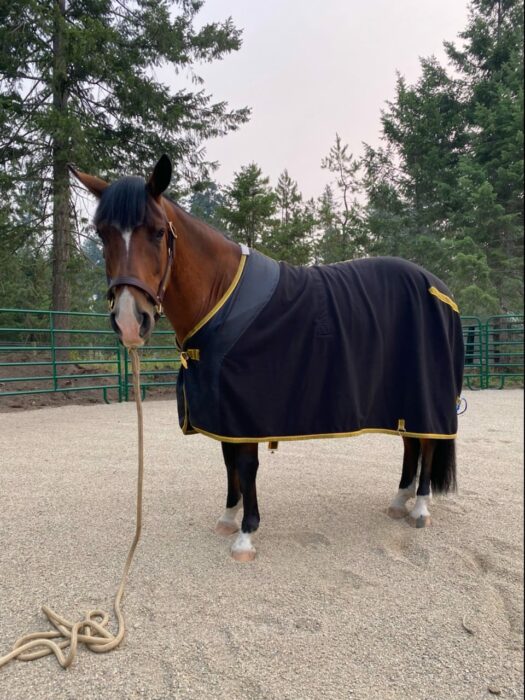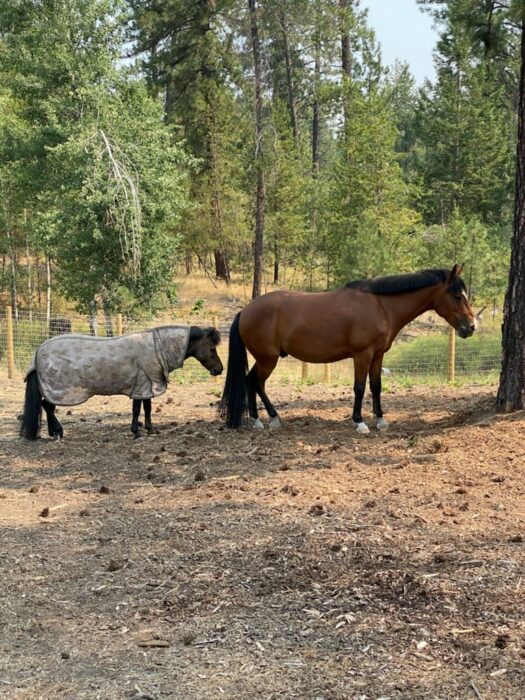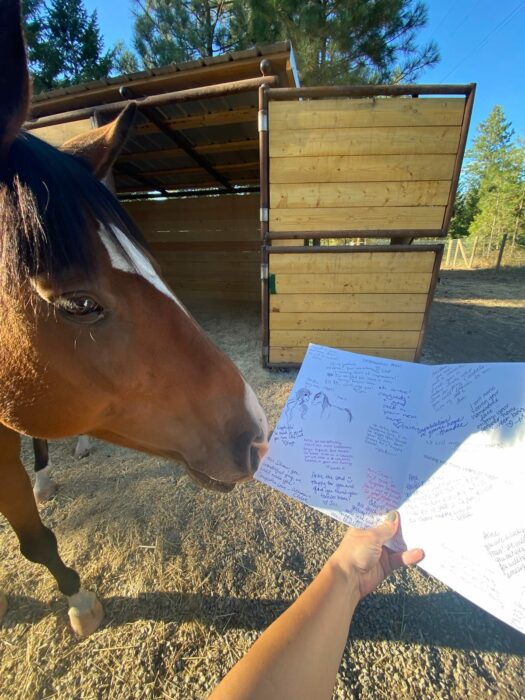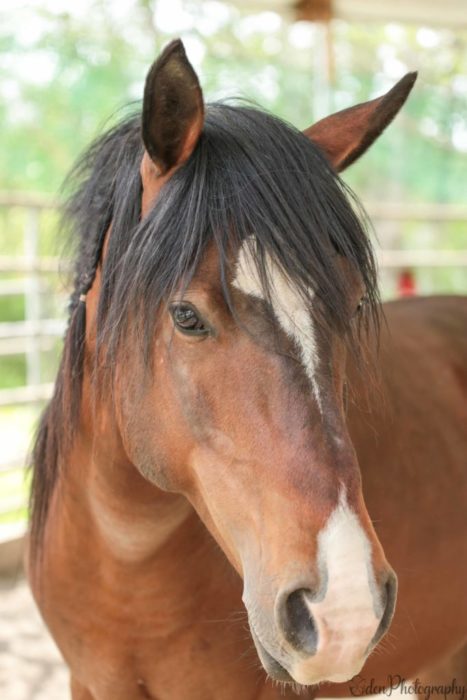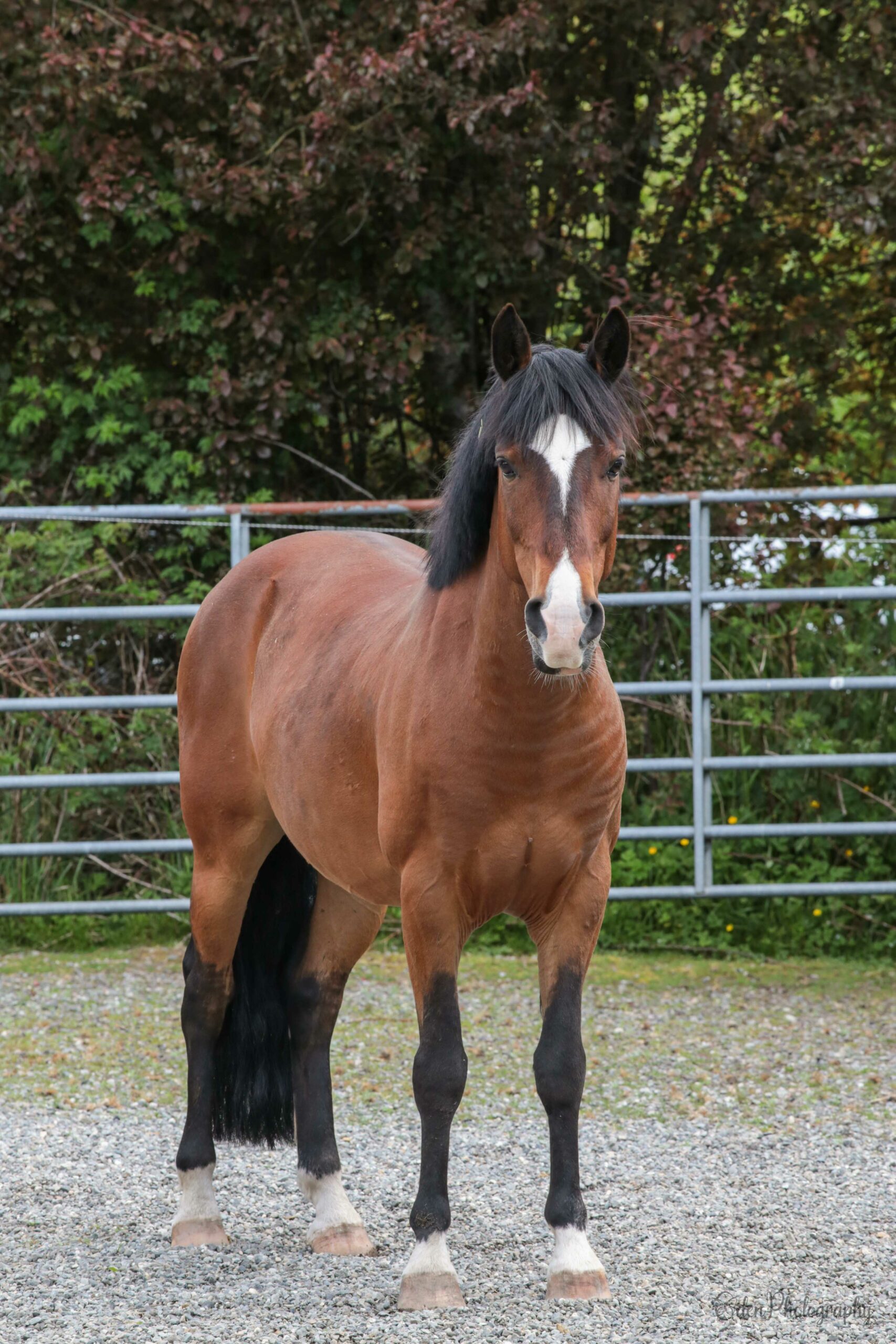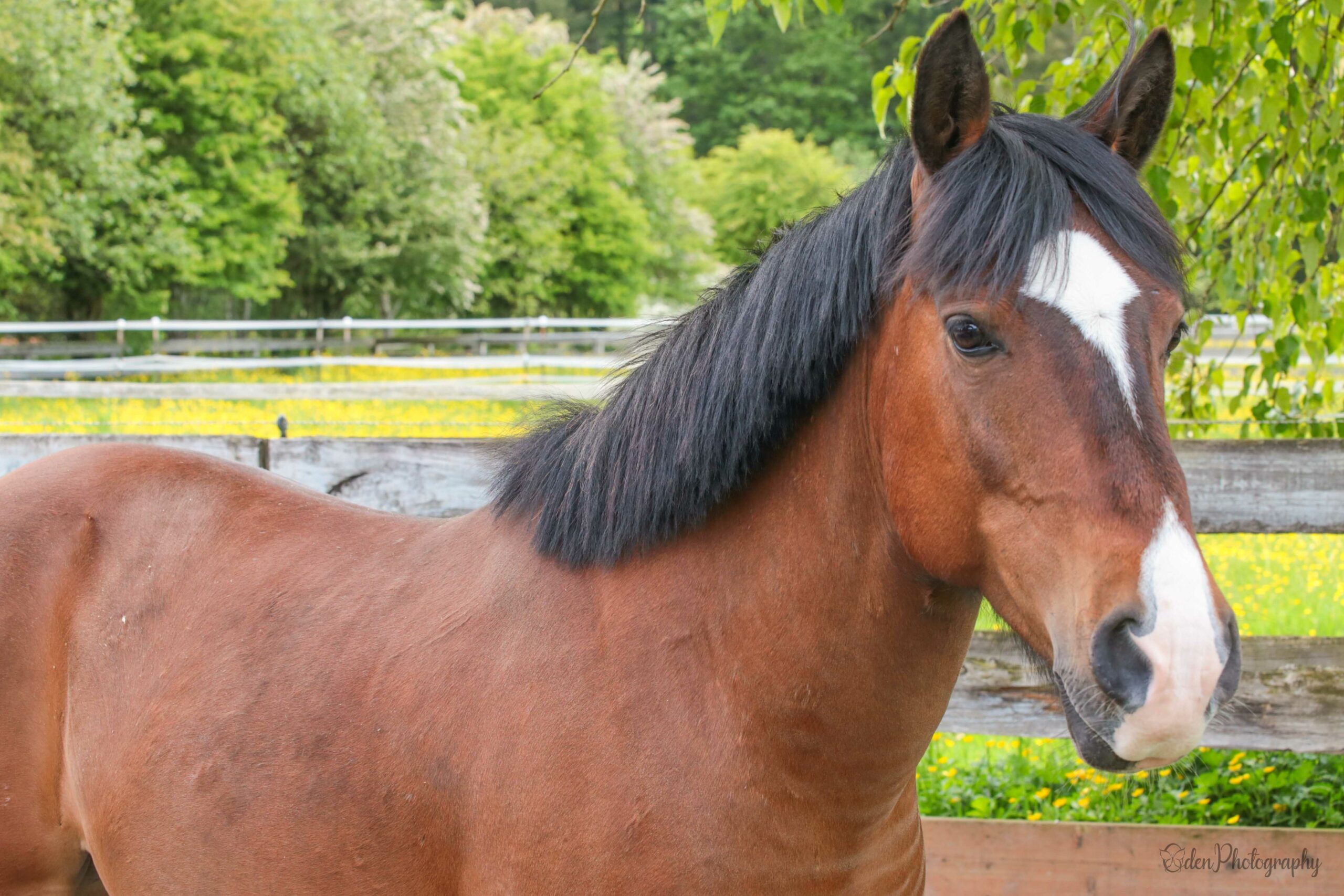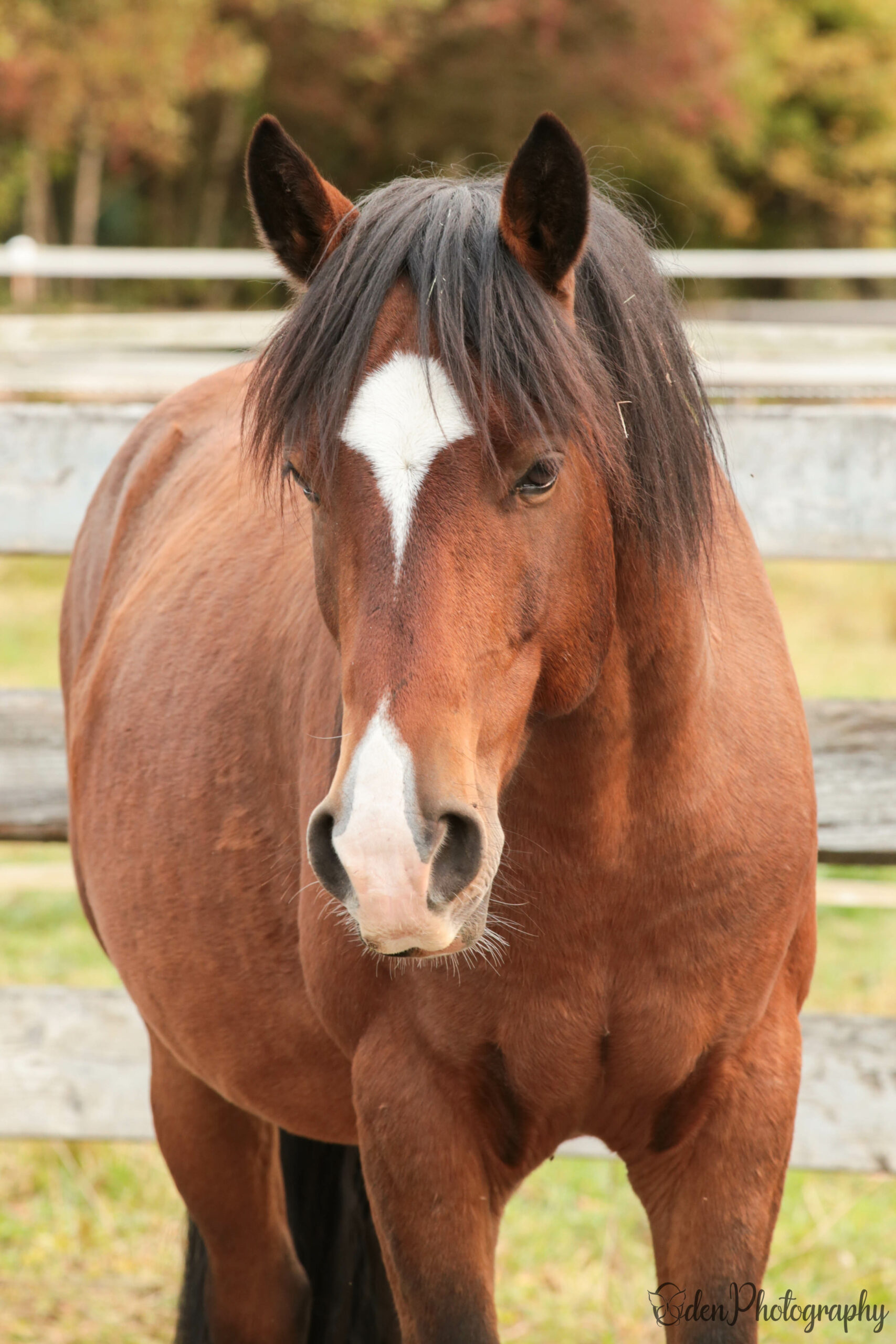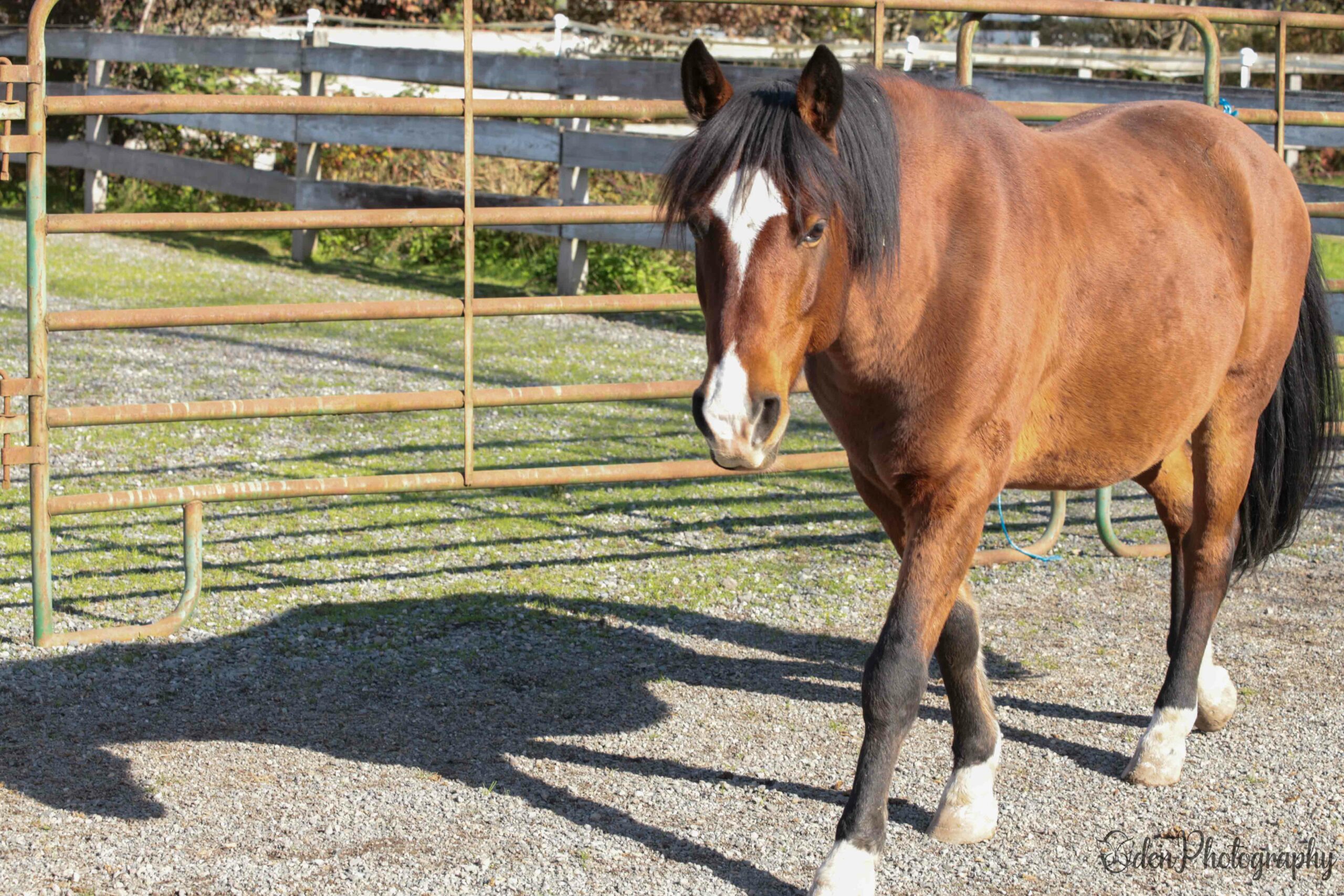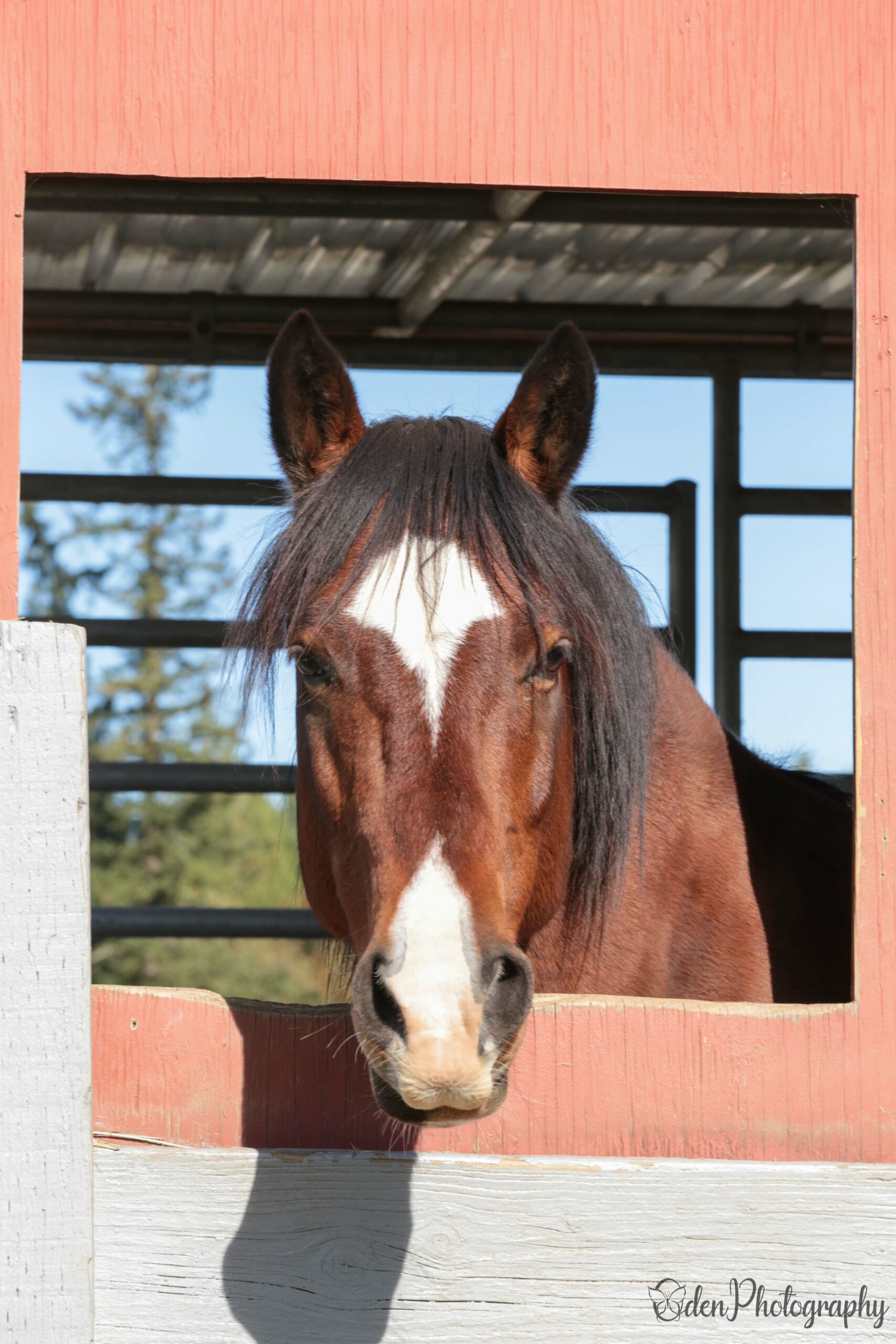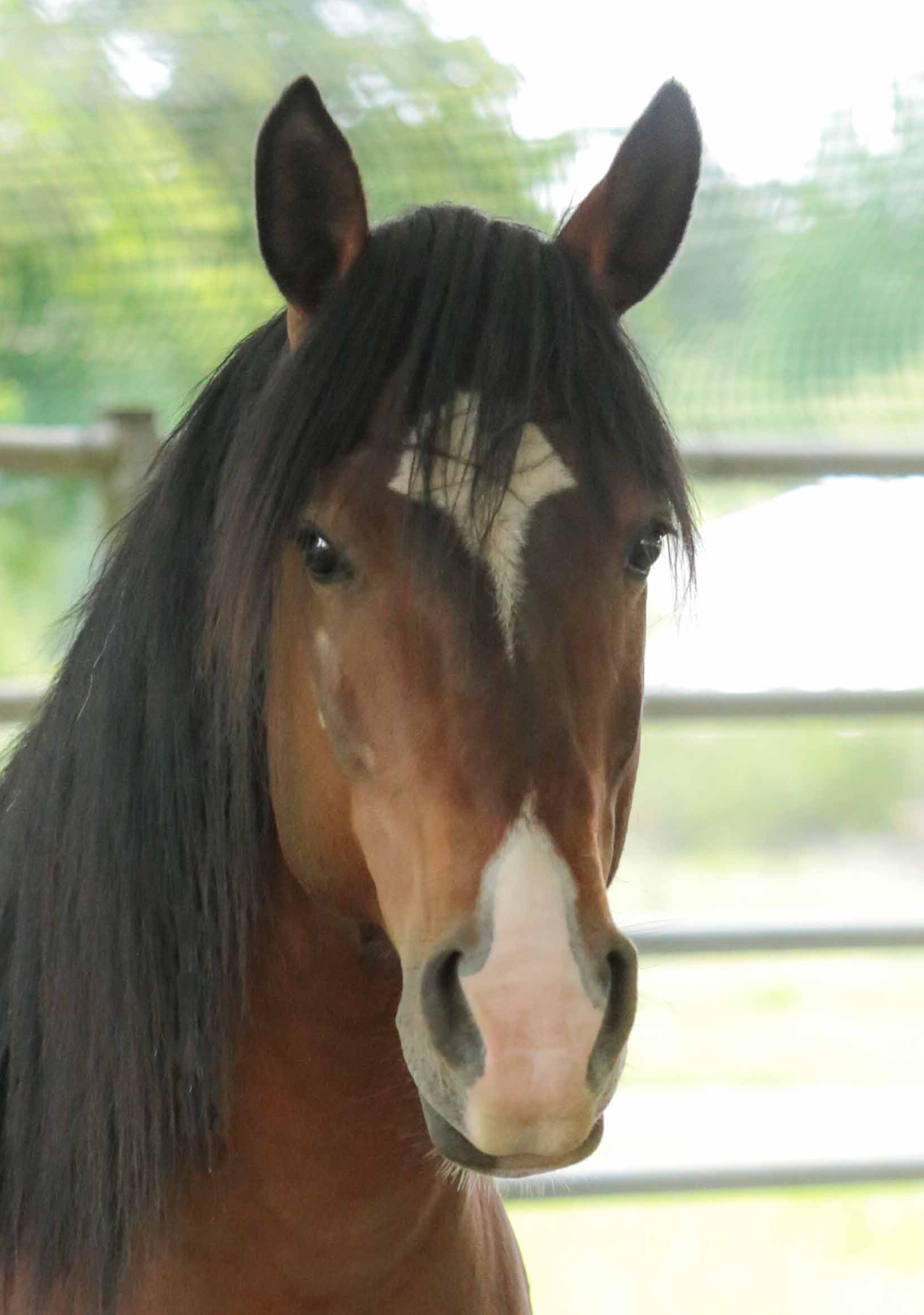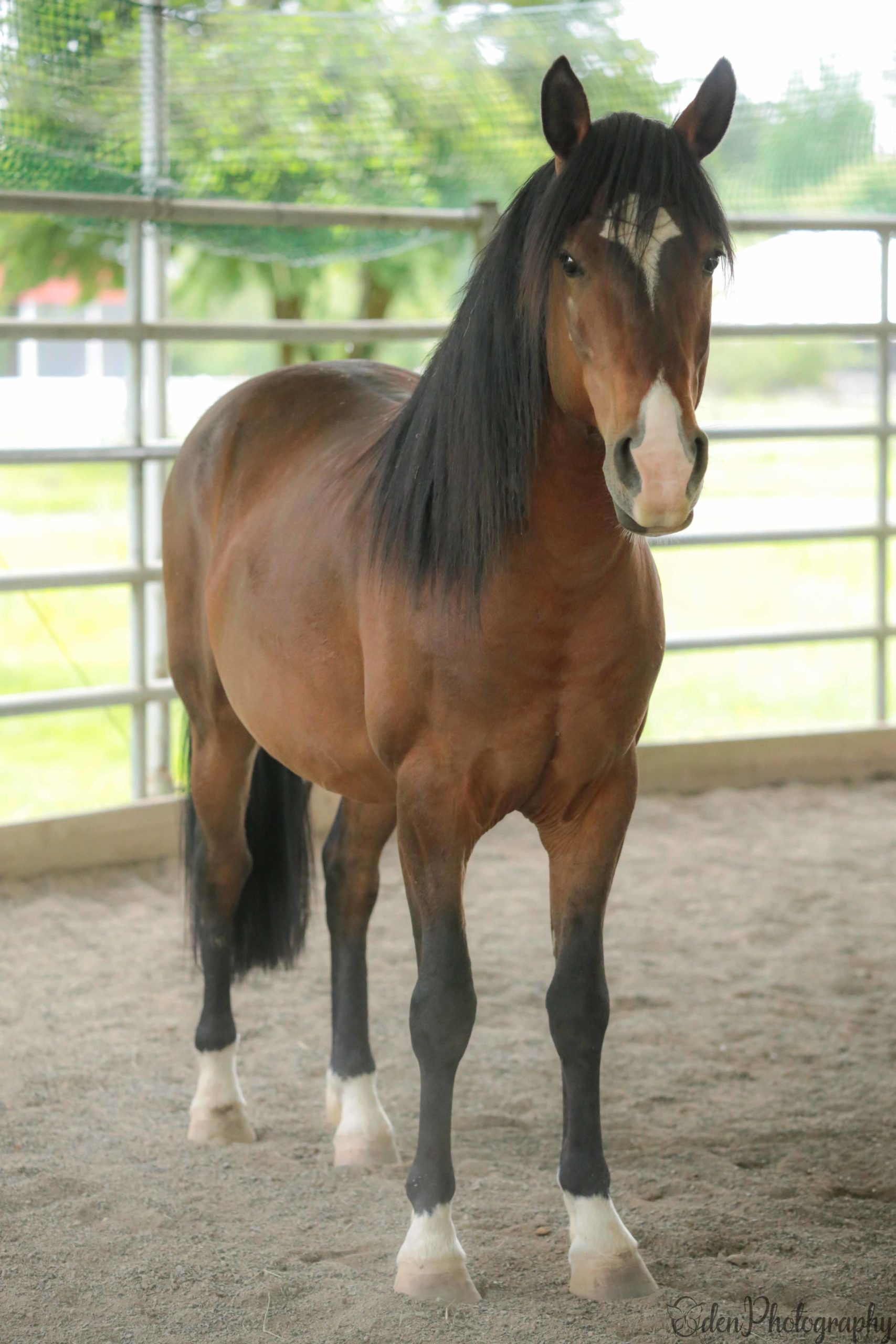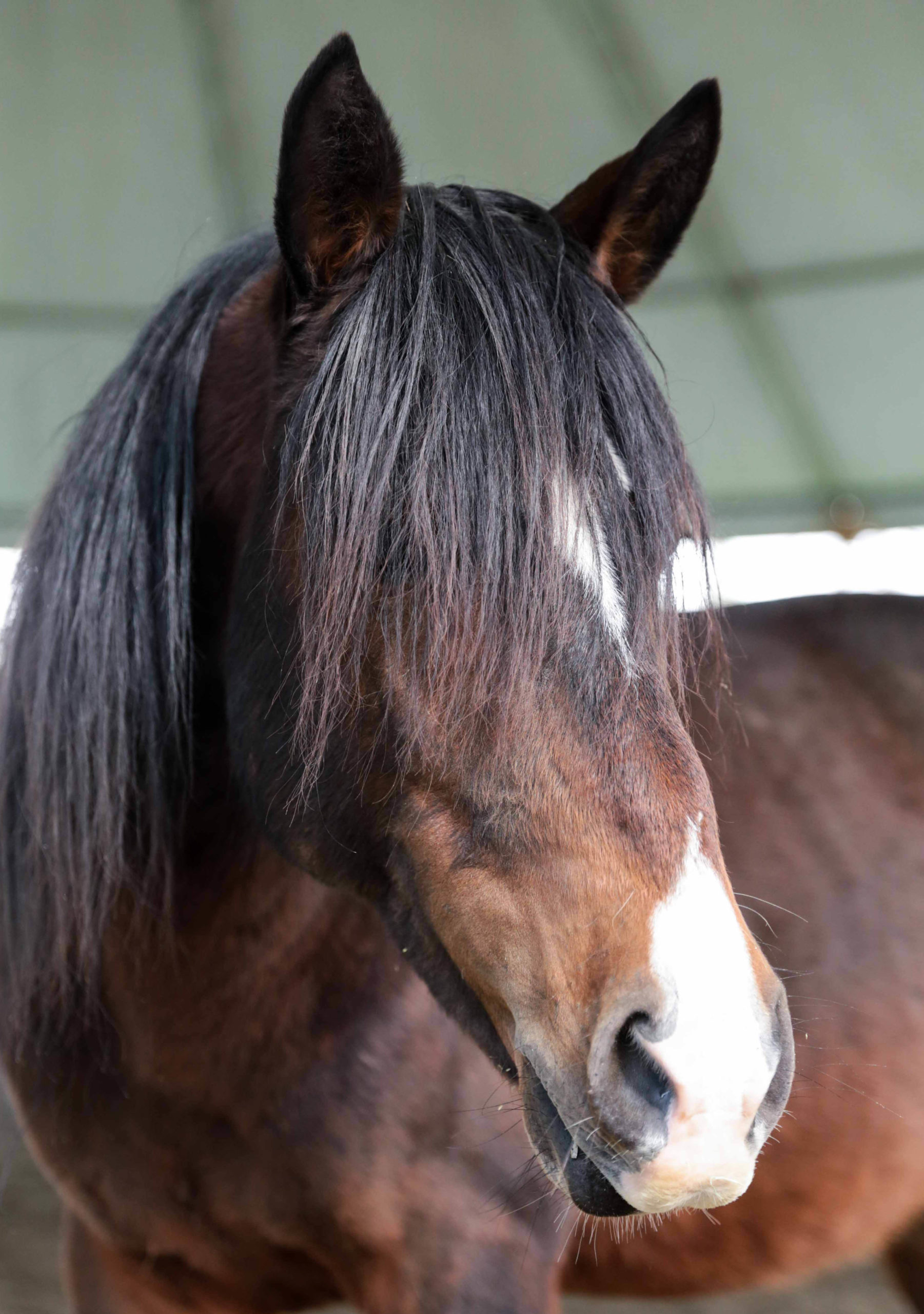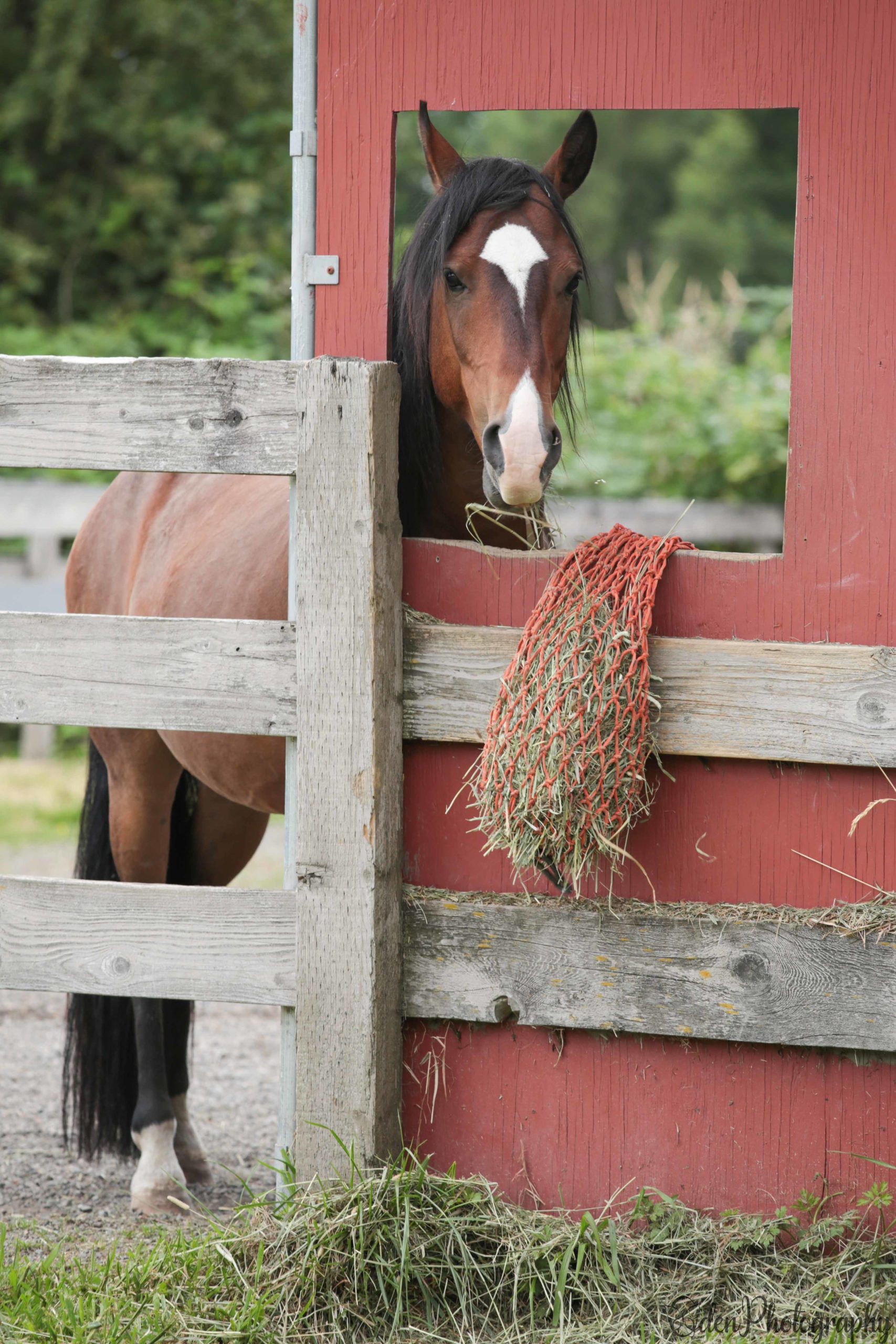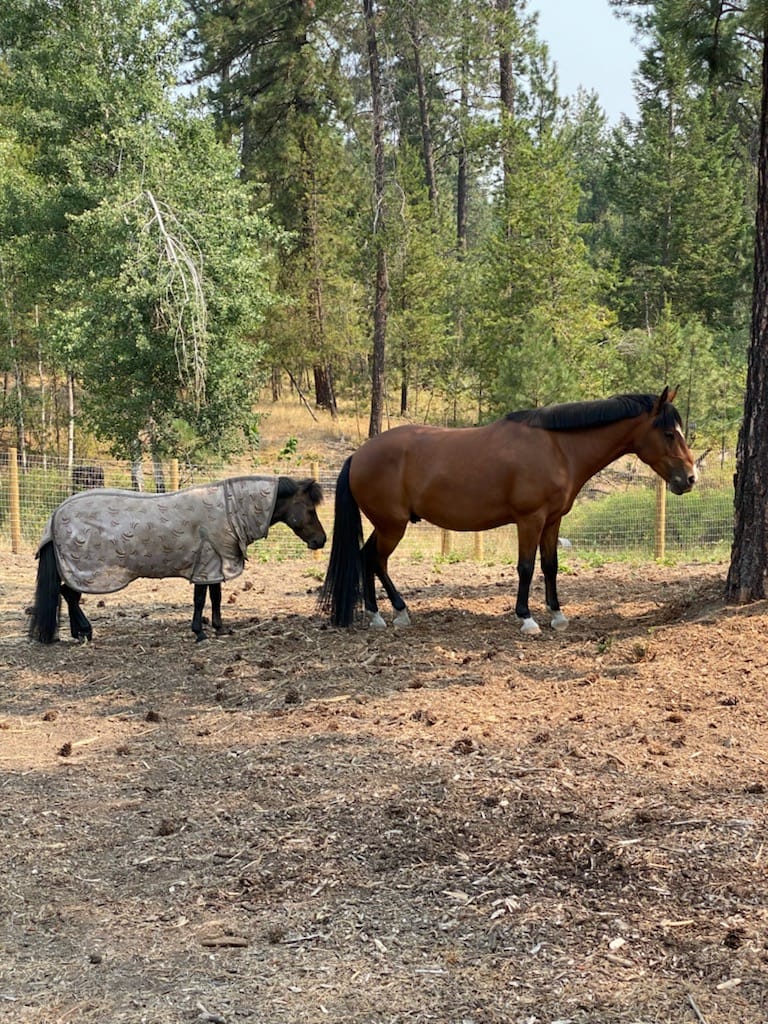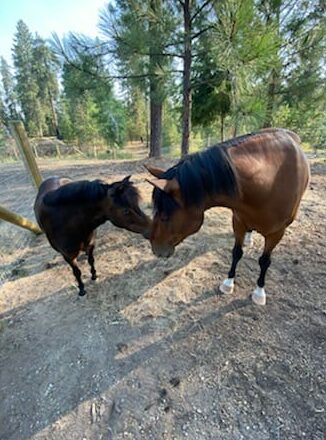Artie
2013 Yakima Reservation gelding
Suitability: For Intermediate Rider
Color: bay
Markings: star, snip, four socks
Height: 13.3 hh
Weight: 900 lbs
Adoption Fee: $3500
Artie Shaw is one of 24 wild Yakima Reservations horses seized in December 2019 by King County Sheriff’s Office, in cooperation with Regional Animal Services of King County and SAFE. After his rescue, Artie was gelded and spent quality time with the SAFE Horsemanship volunteers, who taught him how to live the relaxed gelding life. He’s rather short in stature but he makes up for it with a big presence and a big personality. Artie was adopted as a companion horse in the summer of 2021, but due to sudden life changes, his owner needed SAFE’s assistance in rehoming him, and he returned to SAFE.
Artie has been started under saddle, and is going well, walk trot canter. He has participated in several Joel Conner clinics, and has been on the trails a few times as both a leader and a follower. It’s hard to believe that this once wild stallion is now getting gentle as a riding horse, but it’s the truth! Artie is currently available for adoption to an intermediate rider who can continue his great education.
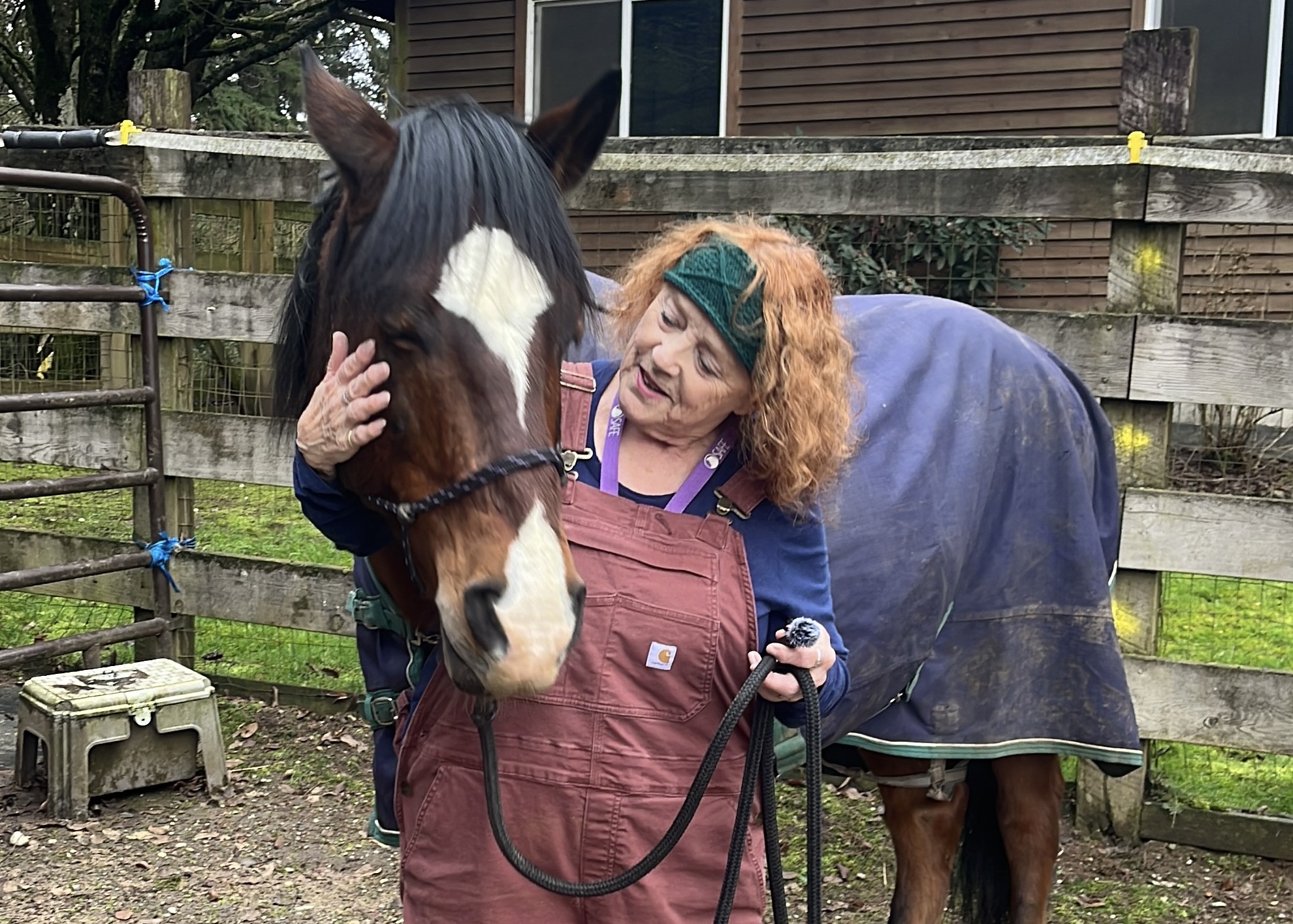
Ginni’s Favorite: Artie
Artie has been one of Ginni’s favorites for years, and here she talks about some of the reasons why.
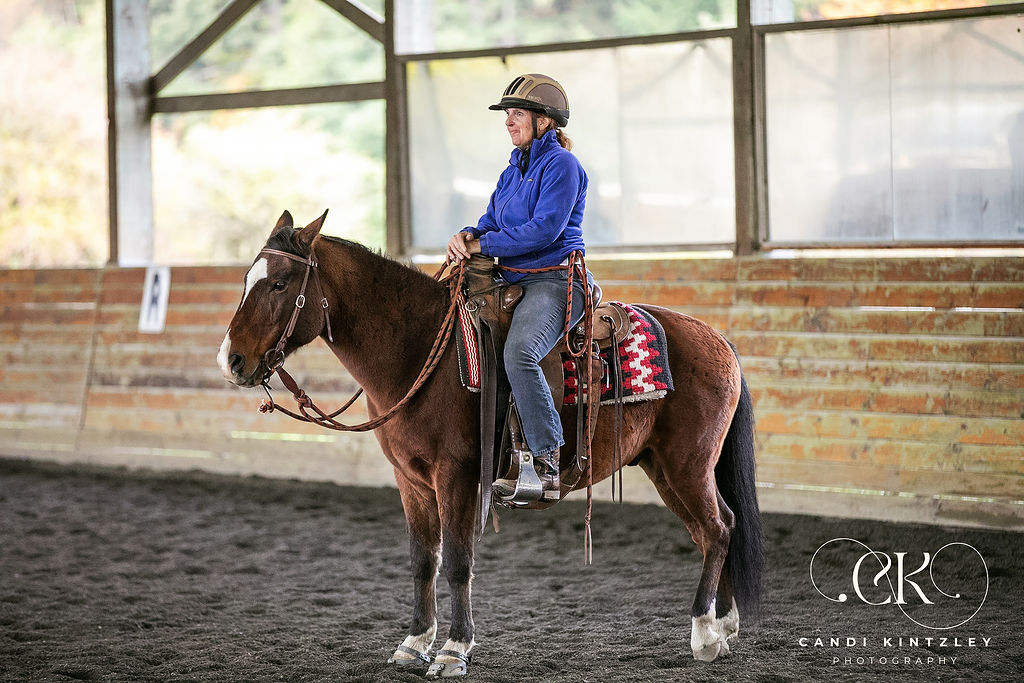
October Joel Conner Clinic Report: Artie
The October Clinic with Joel was Artie’s 3rd Riding Clinic for us and Artie has settled into the routine. He has not only learned the ropes of the clinic but has also relaxed greatly while waiting for others during the 3 hour session. From saddling to warm up to participating, he continues to have an incredibly level demeanor that you can rely on. It is a joy to be able to focus on learning while he calmly does what is asked.
Since the last clinic, Artie has found a greater ability in backing up smoothly and is oftentimes able to “put it in reverse” when seat and stirrup pressure indicates. Hindquarters and front quarters continue to improve as Artie is responding to leg pressure in these departments as well. It is a joy to see life in his trot as he also begins to respond to the ask of a soft feel.
For whomever is lucky enough to adopt Artie, I’m hopeful that they continue to enjoy this levelheaded guy and his education. Until then, we will continue to think big and work forward on his amazing potential!
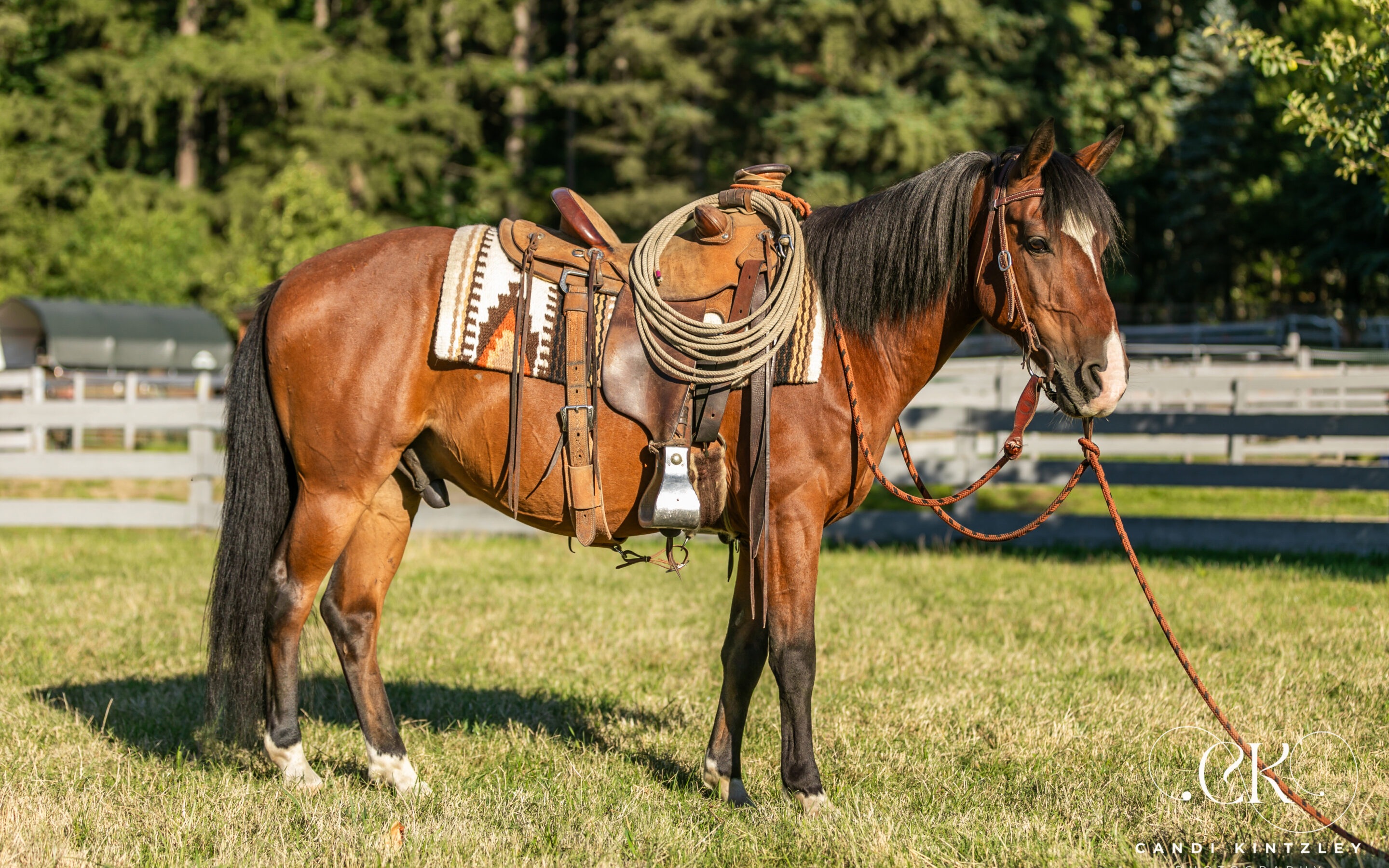
A is for Artie
A is for Artie, and also for Asking ourselves how this Awesome guy hasn’t been snatched up yet? This 11 year old Yakima Reservation Horse stands at an Admirable 13.3, but don’t let his status as a short king have you writing him off — he is a stout and hearty dude! Artie remains calm cool collected in the face of new situations and environments, and we think this Adventurous guy would make for a great trail partner. Amicable Artie gets along great with other horses of all temperaments, and is an absolute pleasure to handle on the ground.
We can’t wait for Artie to find his human Amigo!
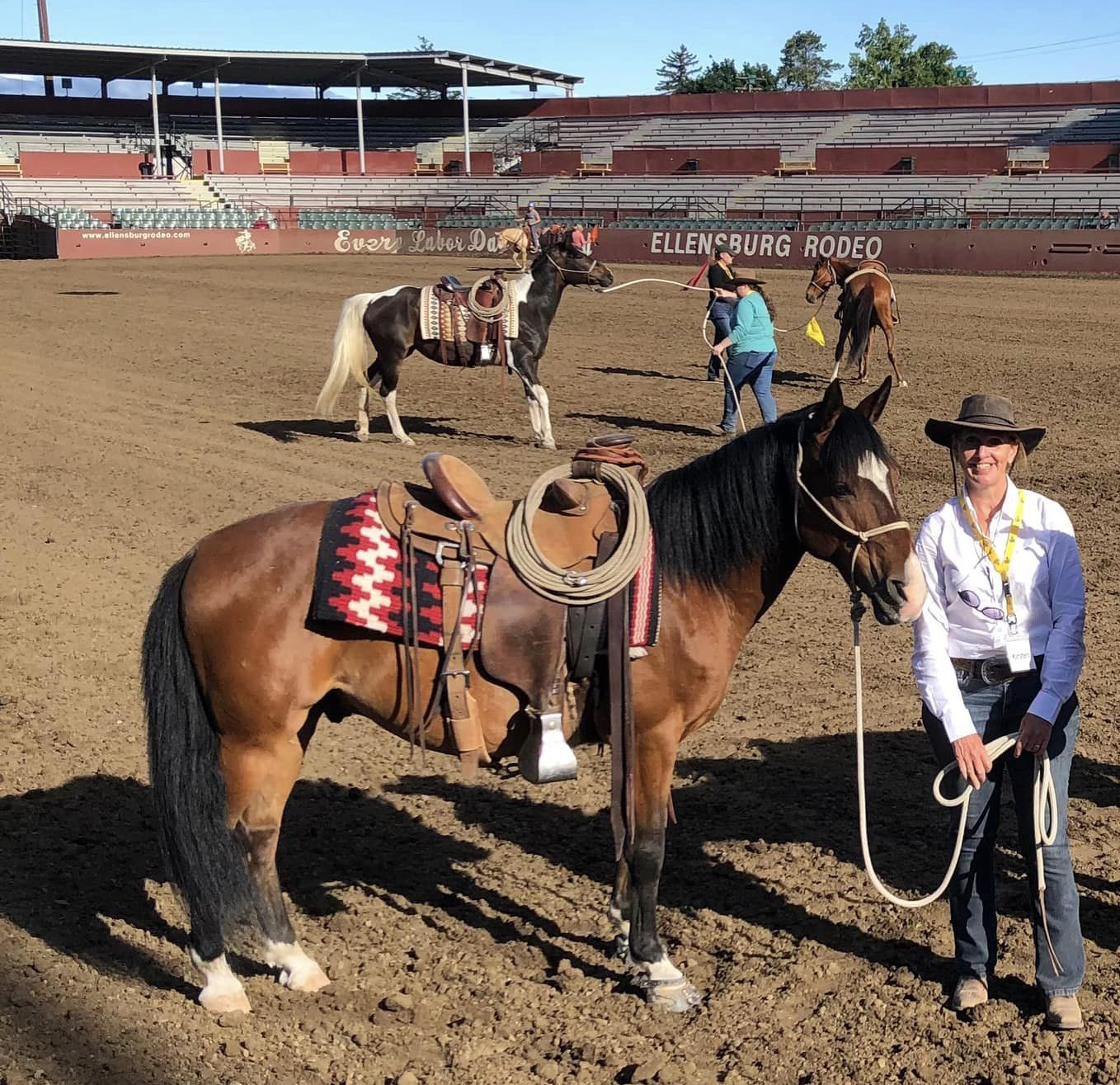
Buck Brannaman Clinic Report: Artie
Kirsten AL has been working with and riding Artie for the last several months, and back in June took him to the Buck Brannaman clinic in Ellensburg. Here’s what she has to say about the experience:
“This guy! Artie recently participated in the Buck Brannaman Foundations Clinic in Ellensburg, WA and he did not fail to impress. Calm. Cool. Collected. What a champ! From loading at SAFE, to walking around a huge arena filled with wind, clapping flags, metal bleachers and noisy stomping to tons of new horse friends – he kept his mind on the business at hand and paid close attention to the instructions given.
When arriving at E’burg, Artie was selected to “room” next to a pawing, whinnying mare and wasn’t phased a bit. Then onto getting saddled and into the arena for a first peek, we went. In hoping to explain Artie’s capabilities, it is important to note that this is my first time taking a horse to Buck’s clinic and Artie didn’t pick up on my jittery nerves. Artie’s demeanor helped me to focus and enabled me to be a better student. It felt like he was saying, ‘I’ve got you”!
During the skills portion of our work together, he confidently moved through united circle, hindquarters, stepping up to the wall, all forms of backing and even riding up to a trot with a soft feel. Artie has an incredible heart of compassion, care and connection. His stability in a new situation is beyond noteworthy and I’m hopeful that his forever family will cherish this guy!”
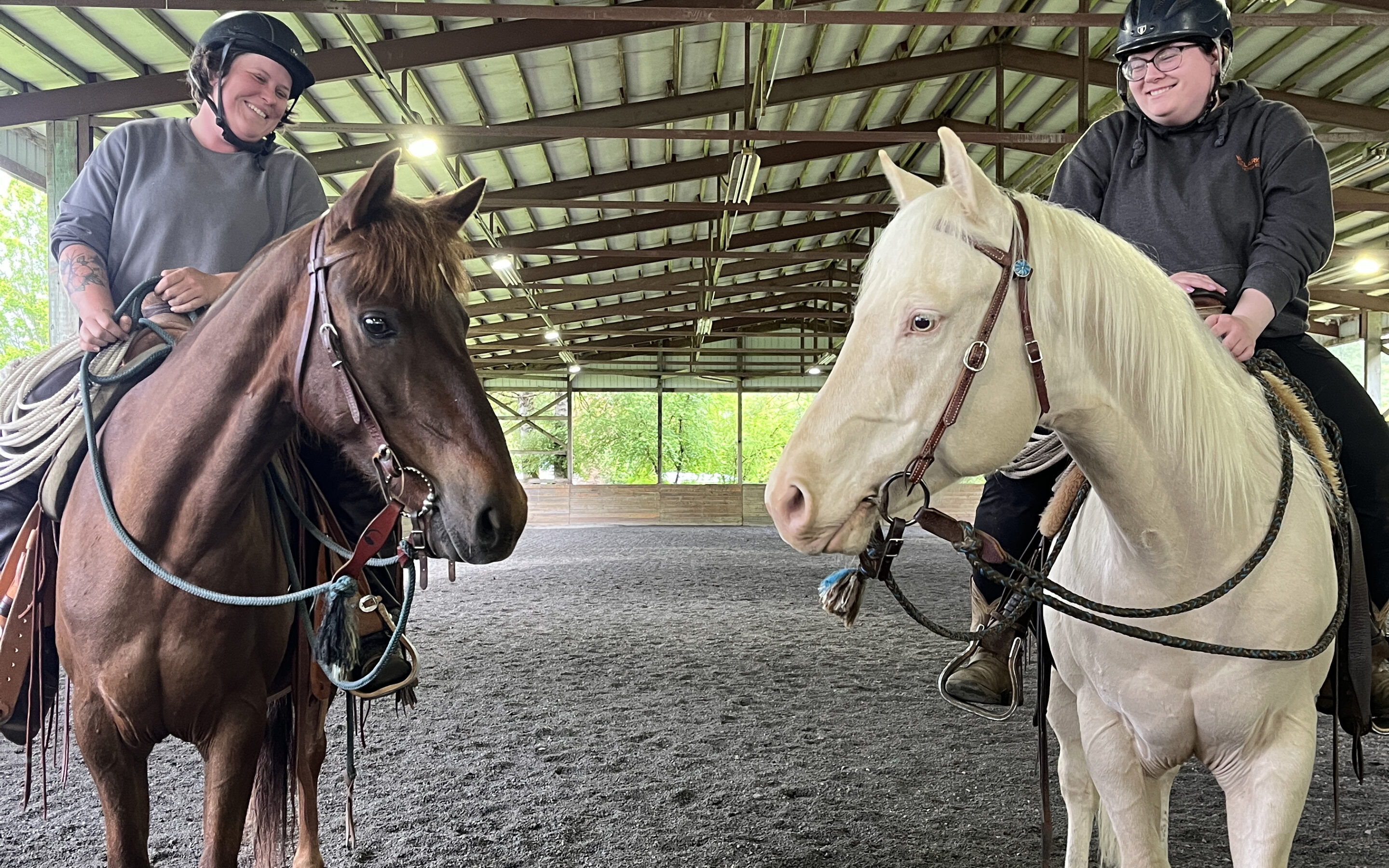
SAFE at Buck
Buck Brannaman is headed to Washington for the next two weekends, and the SAFE horses will be joining him at his clinics in Spanaway and Ellensburg. This is a great opportunity for the horses to get experience off-property while furthering their education with a phenomenal horseman.
Come see:
Esme, 2015 Yakima Reservation mare, at Spanaway and Ellensburg
Jupiter, 2017 AQHA gelding, at Spanaway and Ellensburg
Edward, 2014 Yakima Reservation gelding, at Spanaway and Ellensburg
Veronica, 2015 Yakima Reservation mare, at Spanaway
Moshi, 2016 pony mare, at Spanaway
Barb, 2019 Yakima Reservation mare, at Ellensburg
Artie, 2013 Yakima Reservation gelding, at Ellensburg
Tiva, 2011 Yakima Reservation mare, at Ellensburg
Auditors welcome, $30/day
Spanaway dates are June 21–23 at the Tacoma Unit, Horsemanship 1 from 9–12 & Horsemanship 1.5 from 1:30–4:30
Ellensburg dates are June 28–30 at the Rodeo Grounds of the Kittitas Event Center, Foundations from 9–12 & Horsemanship 1 from 1:30–4:30
You can find out more information on Buck’s site: https://brannaman.com/bb-clinic-si.html
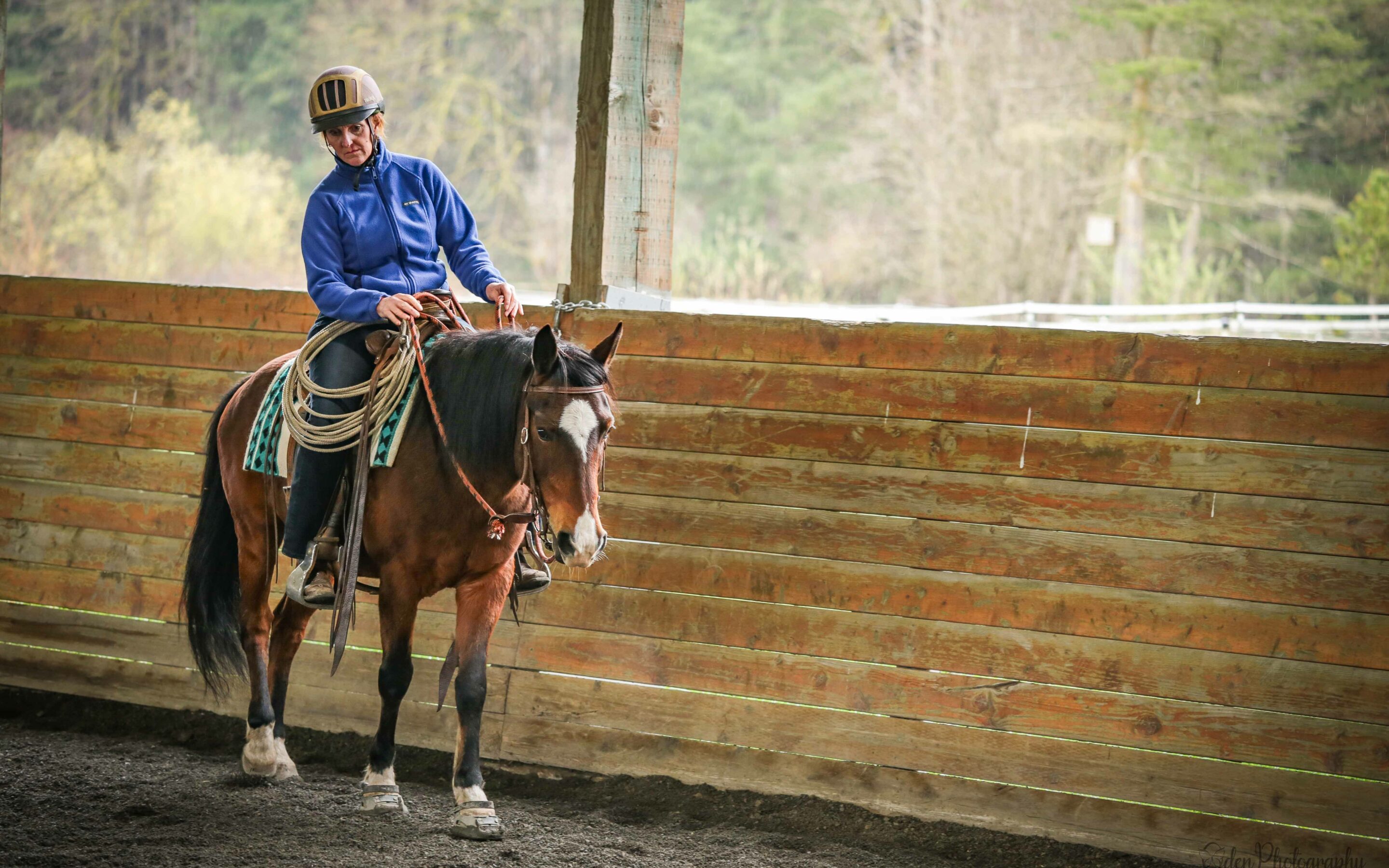
March Joel Conner Clinic Report: Artie
Kirsten L has been riding Artie for several months, and brought him in to the March Joel Conner clinic. Here is her report on the experience:
“Mr. Artie Shaw is quite the gentleman! This was my first riding clinic with Joel and Artie was incredibly patient with my learning curve. Levelheaded. Confident with new horses. Unflappable when asked to walk, trot, lope, and didn’t spook once. We’ve found a sweet spot when bridling to help him with his history of poll shyness – he likes slow movements, lots of gentle rubs and routine! He stands well when saddling and is excellent when putting the boots on his front feet and equally as great at lifting his back feet. Like a true gentleman, Artie has much to give a future adopter including taking great care of his rider and a willingness to provide a stable start for a new owner!”
Terry has the following addition about Kirsten and Artie during the clinic:
“I was thoroughly impressed with Kirsten and Artie’s performance in the clinic. Despite it being Artie’s first-time riding through the full three-day, three-hour classes, he seemed to maintain his energy levels throughout. Kirsten even worked with him at the lope towards the end of the last day. This is a significant achievement for the little pony, considering he initially struggled with enthusiasm, showing more “whoa” than “go” at the start of his riding career.
However, one issue arose during the class when Artie began shaking his head, showing reluctance to stand still, and even exhibiting a little hop with his front end. I decided to mount him to assess the situation. After a brief examination, it became clear that he was unhappy with the bit having extra contact in both reins. It was reassuring to see that his discomfort did not escalate into anything dangerous.
Kirsten demonstrated her skill by adjusting her contact and providing more significant releases in the reins and her body language to communicate to Artie that she was no longer asking him to do something. Offering a horse peace even within movement is a crucial lesson for riders and handlers alike. It communicates to the horse that as long as they stay connected and doing what was asked, continual cuing is not needed.
I often liken this to driving with a turn signal left on after changing lanes. The constant clicking becomes grating, much like Artie’s discomfort with excessive contact in the bridle beyond what is necessary. Observing Artie’s responses to different riders and his boundaries regarding what he is willing to tolerate provides valuable insights.
Overall, it was a great learning experience for Kirsten, and it was heartening for us to witness Artie’s adaptability and his clear communication of his needs.”
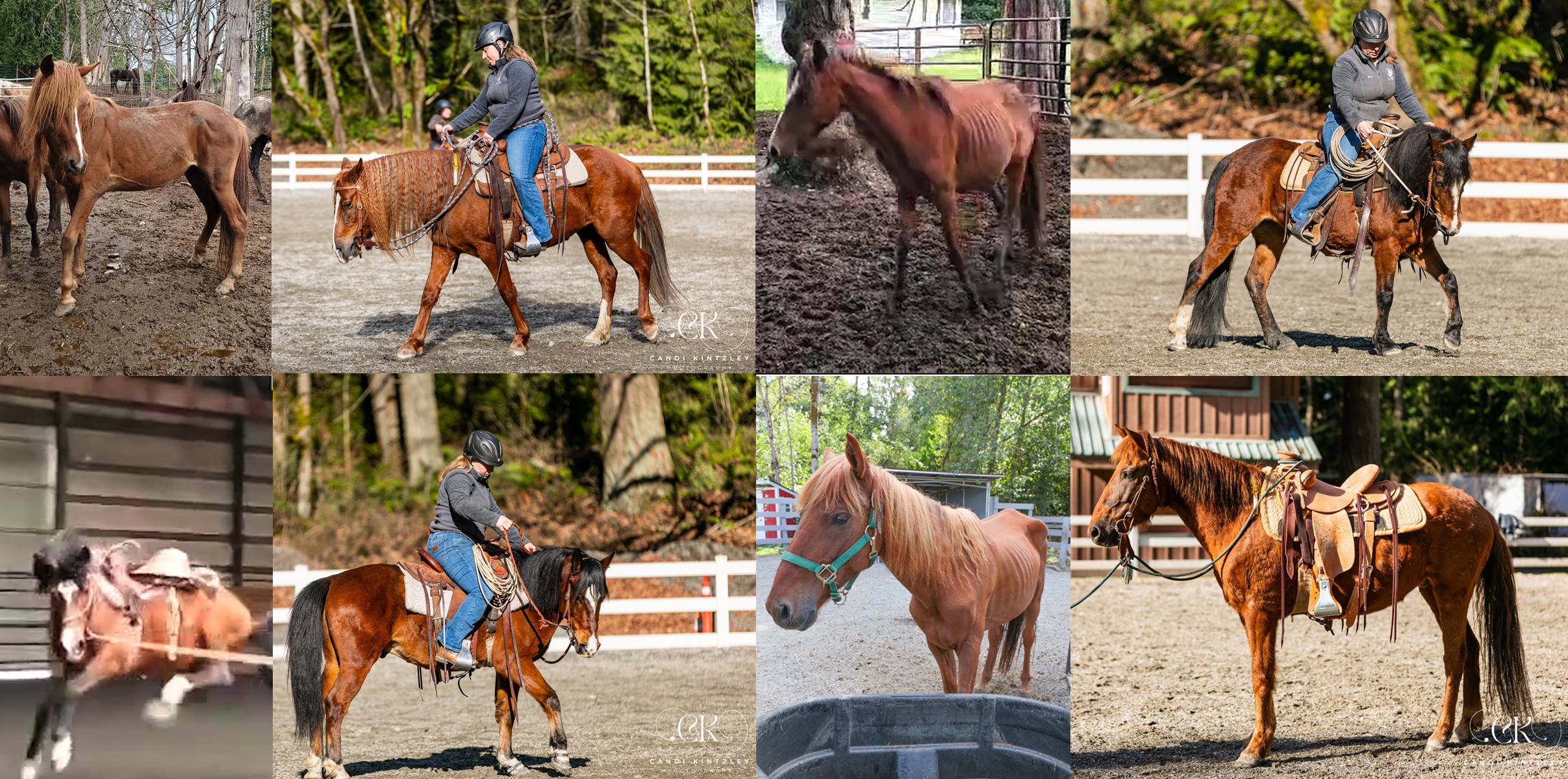
Transformations
Gradual change can be difficult to see, especially when what you have in front of you is almost impossibly different than what once was. Below is a quick before and after of a few SAFE horses, and their nearly unbelievable transformations over the years at SAFE.
Veronica came to SAFE in 2019 as part of the Fall City 40. Back then, she was essentially feral, thin as a rail and with her long luscious mane twisted into a snarl. Her wariness and sense of self-preservation was strong and long-lasting, and it was difficult to imagine that she would ever be truly gentle, let alone ‘make it’ as a riding horse. And yet, here we are in 2024, where Veronica has been under saddle for going on two years now. That sensitivity still exists within her and likely always will to some degree, but through the support of a strong rider, Veronica has been able to make her way out of the arena and even off the property. Her transformation has been immense and incredible.
Artie was also part of the Fall City 40 seizure. A stallion at the time of his rescue, he lived in the covered round pen during his early days at SAFE while work was done to gentle him, as there was a good chance he would have broken free from the confines of a regular paddock. Artie was also one with a high degree of self-preservation, accustomed to having to look over his shoulder in order to protect his band of mares. Even after a tremendous amount of prep work, his first saddling was explosive, and had us rethinking if it was worth it for him, or for us, to continue the journey of making him a riding horse. But now, several years later, Artie is nearly unrecognizable as the gentle, intermediate riding horse he has become.
Edward was surrendered back in 2021, with severe respiratory issues that left him in need of substantial medical attention. With such poor lung function, whatever calories should have been going to his nourishment were instead being used to keep him breathing, leaving him very thin in addition to being unhealthy. He was a nervous guy, in turns pushy and flighty, and aside from the hurdle of restoring him to good health, there was a great deal that he needed as far as training was concerned. But these days, Edward is almost completely unrecognizable in more way than one, and in search for his forever home.
Pepper was another Fall City 40 mare, also tremendously emaciated and practically wild. While her demeanor was perhaps more mellow than some others mentioned here, it still takes a lot to take a horse from a bag of wild bones and help them grow into a healthy, domestic creature. These days, Pepper is one of the safest SAFE horses, and a living reminder of what change looks like.
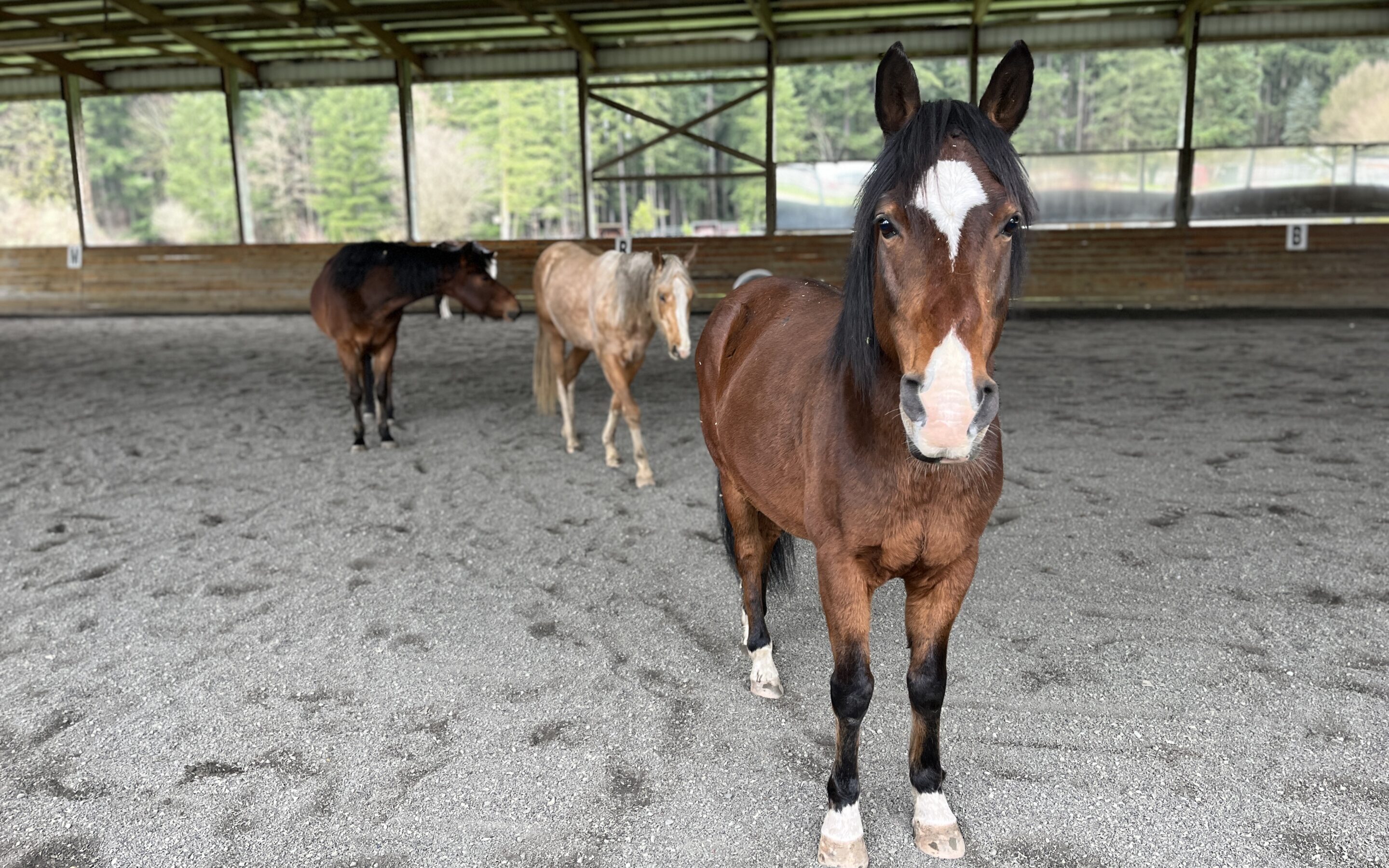
Artie Shaw, Friend to Many
If SAFE had class superlatives, Artie would definitely win ‘friends with everyone.’ He is the horse that most other horses (at least if they’re geldings) first meet, and for good reason. Artie’s mellow demeanor around other horses helps introduce even the most unseasoned herd members to the idea of drama-free interaction. A lot of ex-studs come to Artie, all with varying degrees of politeness, and Artie greets each one in stride. He will kick up his heels a bit, and enjoys engaging in gelding mouth games once in a while, but for the most part is just a rock steady energy that is a real boon for horses who are just learning the ropes on how to interact with other horses.
He may not weigh a ton, but Artie is worth more than his weight in gold as a friend, especially a first friend, to other horses!
- Artie and Arrow
- Artie and Scotty
- Artie and Jupiter
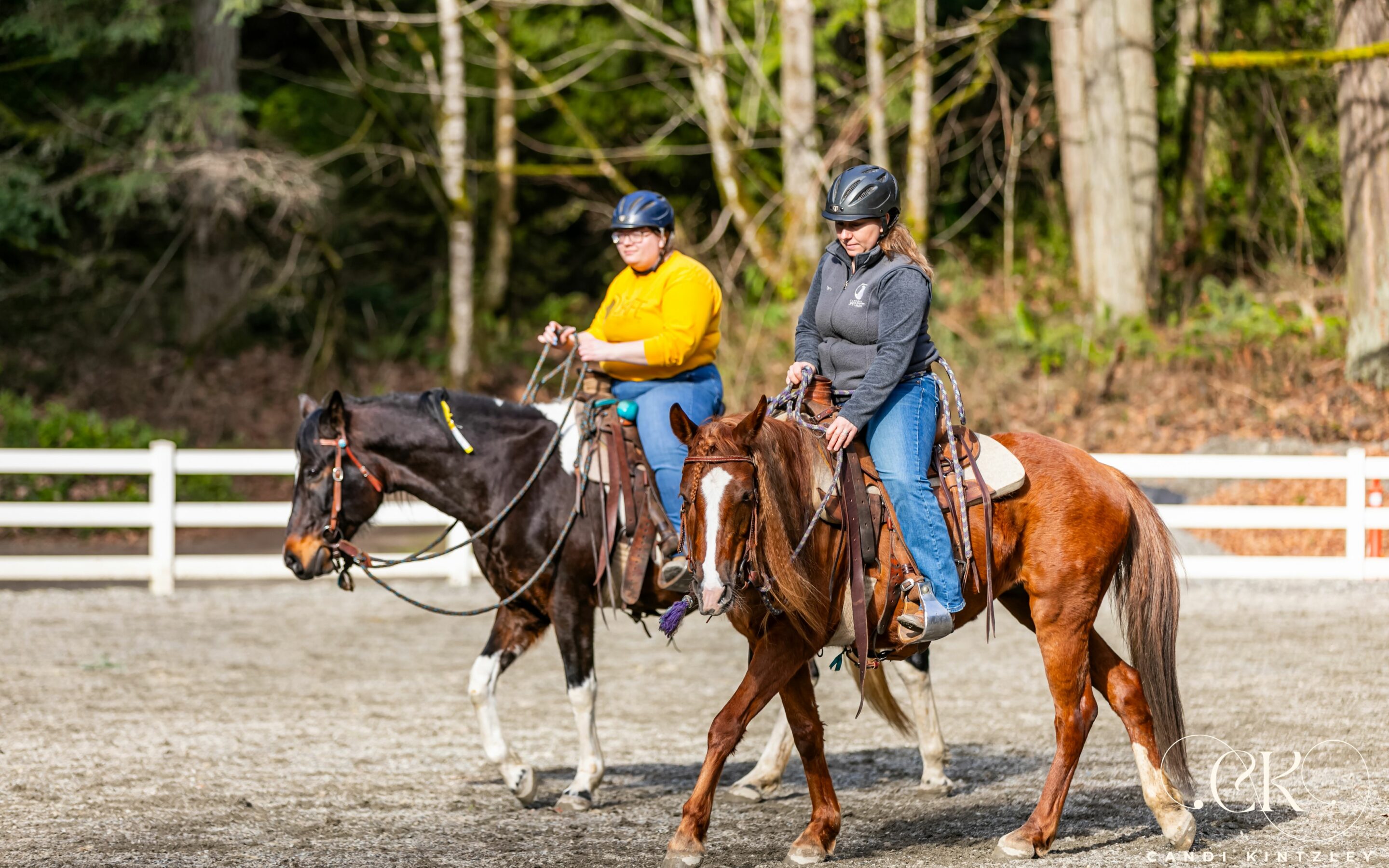
Field Trip to Bridle Trails
Winter Washington weather (say that five times fast) does not often conjure visions of sunshine and blue skies. But every so often, the metaphorical stars align to grace us with a January or February day that feels more akin to early summer.
Such was the luck we had for our first off-property excursion of 2024, a trip down the road to Bridle Trails state park. We loaded eight horses into the trailers: Alums Owen and Fancy accompanied current SAFE horses Artie, Veronica, Pepper, Tiva, Violet, and Edward. For the majority of the horses in attendance, it was the first time they had been away from SAFE since their arrivals, though you might not have guessed it by how coolly they greeted their new surroundings.
We unloaded horses and tack, and brought everything and one to one of the park’s arenas. There, we helped the horses settle into the new space through a combination of exploratory walk-and-sniffs (turns out, white vinyl fencing is snort-worthy) and groundwork. The time it took for each horse to settle varied some, though no one was particularly unsettled to begin with. Soon, everyone was cinched up, and we followed the sun into an adjacent arena.
All the horses currently going under saddle (meaning everyone aside from Tiva) had at least one, if not two or three, rides that sunny Saturday afternoon. Faced with strangers walking alongside the arena, some shepherding very interested dogs or children, as well as a stop-and-start parade of mounted riders heading out to the adjacent trails, our modest herd did tremendously well. They were able to find support in their humans when it was required, but for the most part handled the new environment and wide open arena space with level-headed grace. The countless hours that had led up to this point for each of them helped to make the entire outing hugely successful, and check some major boxes for our horses.
After several hours under saddle, basking in the sunshine and the glow of a very productive afternoon, we untacked the horses and grabbed our snack bags, retiring to a shady spot to allow for a physical and mental cooldown slash lunch break. The horses shook out their coats while they sniffed at our sandwiches, taking sips from the water buckets we’d brought as we all rehydrated for the short drive home. One stud muffin each was in order, the equivalent of your dad stopping for ice cream at the end of a road trip. Then, we loaded our tack and our horses, and headed back for SAFE in time for afternoon hay.
Though it takes some work logistically, we plan to take the horses off-site multiple other times this year, be it to clinics or for more casual adventures like our trip to Bridle Trails. We could not be more proud of the SAFE horses, and extend our thanks and gratitude to the humans who helped them, and continue to help them, in all stages of their journeys.
Check out a little glimpse of our day below:
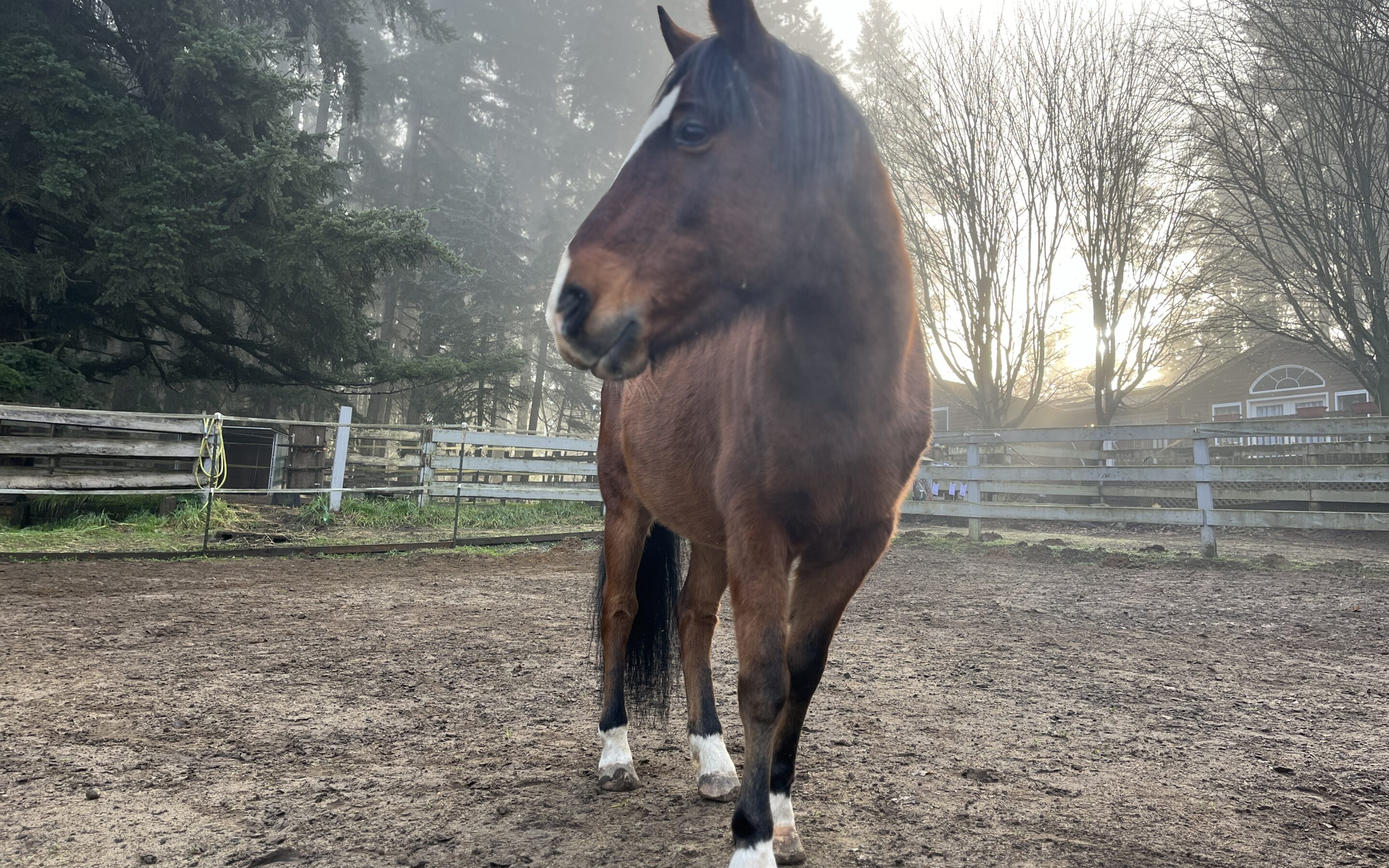
Q1 Report Card: Artie
Notes:
- Artie tends towards the dull side, but has a lot of try. He will work hard knowing a break is coming.
- Poll shyness — can be reactive to things in that area, especially if they are sudden. Has come a LONG way with this.
- Can be reactive to flag by his poll or in his blind spots — new environmental factors can bother him (see can bag)
- If you prove your leadership skills to him, that translates to his trust of you in many other capacities
- Stopping on a hind, good. But fully turning loose to it, not as good. Might not carry over out of context.
- Right is his more difficult side — has more trouble with things on that eye
- Ties, but still has a bit of a pullback spot in there. Having something come up on the side of him will incite panic. Hasn’t yet tied in a trailer or shut the divider in for this reason.
- Has been handed over to others to ride, monitoring for the common issues that might arise with a more intermediate rider.
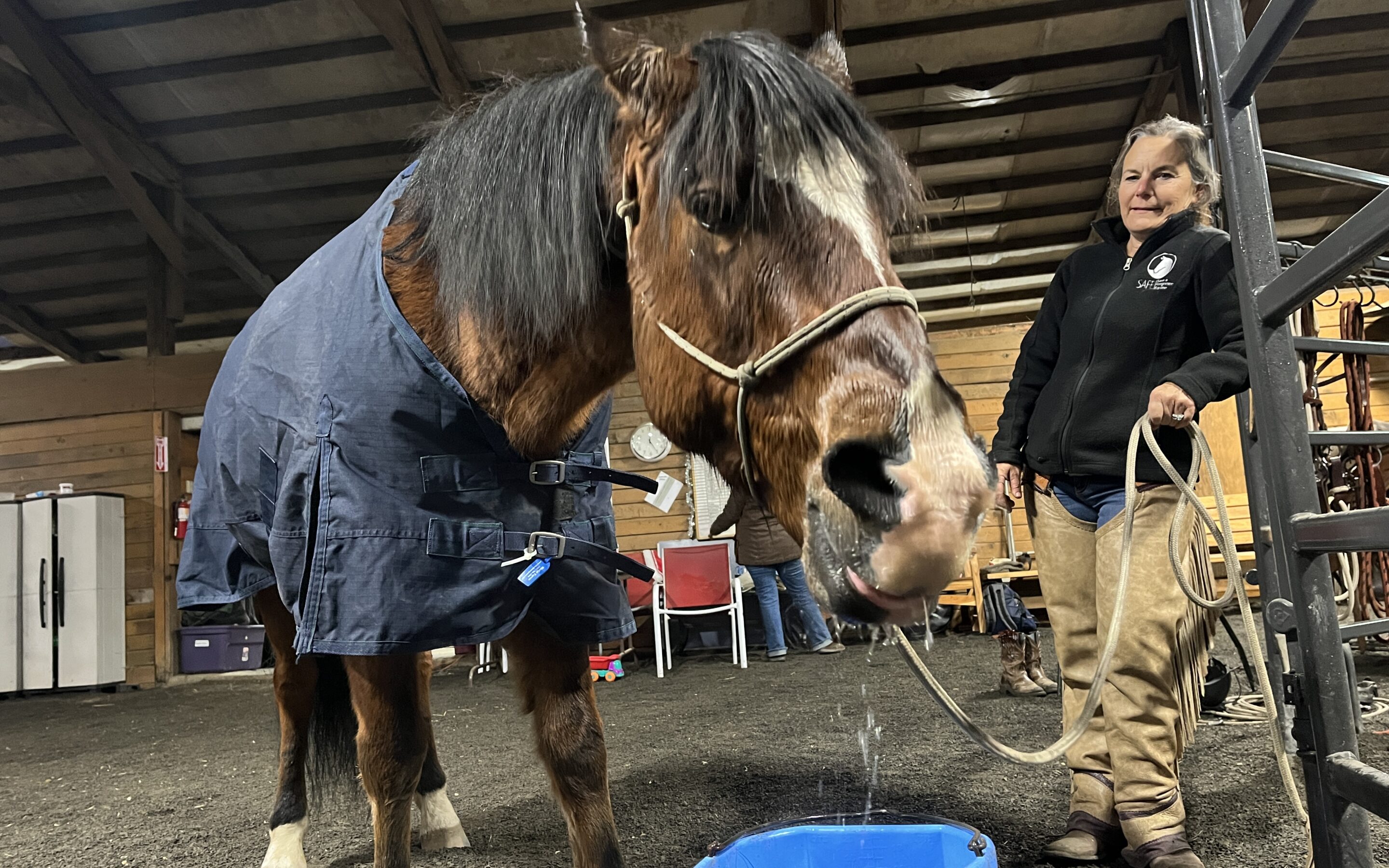
Artie Loves Sweet Water
What drink comes to mind when you are asked to conjure up the most refreshing, thirst-quenching beverage? Is it a gallon bucket of water with a handful of senior and a little bit of salt? No? Well you must not be a horse then!
We give ‘sweet water’ to our horses in a variety of situations. When the temperatures drop, often does the horses’ desire to drink water. A warm sweet water, however, is not something they readily refuse. On the opposite side of the spectrum, when the heat comes, we want to keep the horses well-hydrated. This situation also calls for a sweet water. Colicky horse? Sweet water, hold the salt! Particularly hard work session? Sweet water!!
The senior mostly dissolves in the bucket, making for what is technically just an incredibly soupy mash. But there are typically some bits and pieces of solid that remain, or a nice slurry that sinks to the bottom. The horses who are wise to the nature of sweet water will often go bobbing for senior, aka sticking the majority of their heads into the bucket in order to get those good bits down at the bottom.
Artie is no stranger to sweet waters, and knows just how to maximize his enjoyment of the good stuff. After a workout one day, we let Artie imbibe, and captured the following video of him demonstrating how best to taste the complex flavor profiles of senior enhanced water, and also how to clear out one’s nostrils after going diving for senior bits. Check it out!
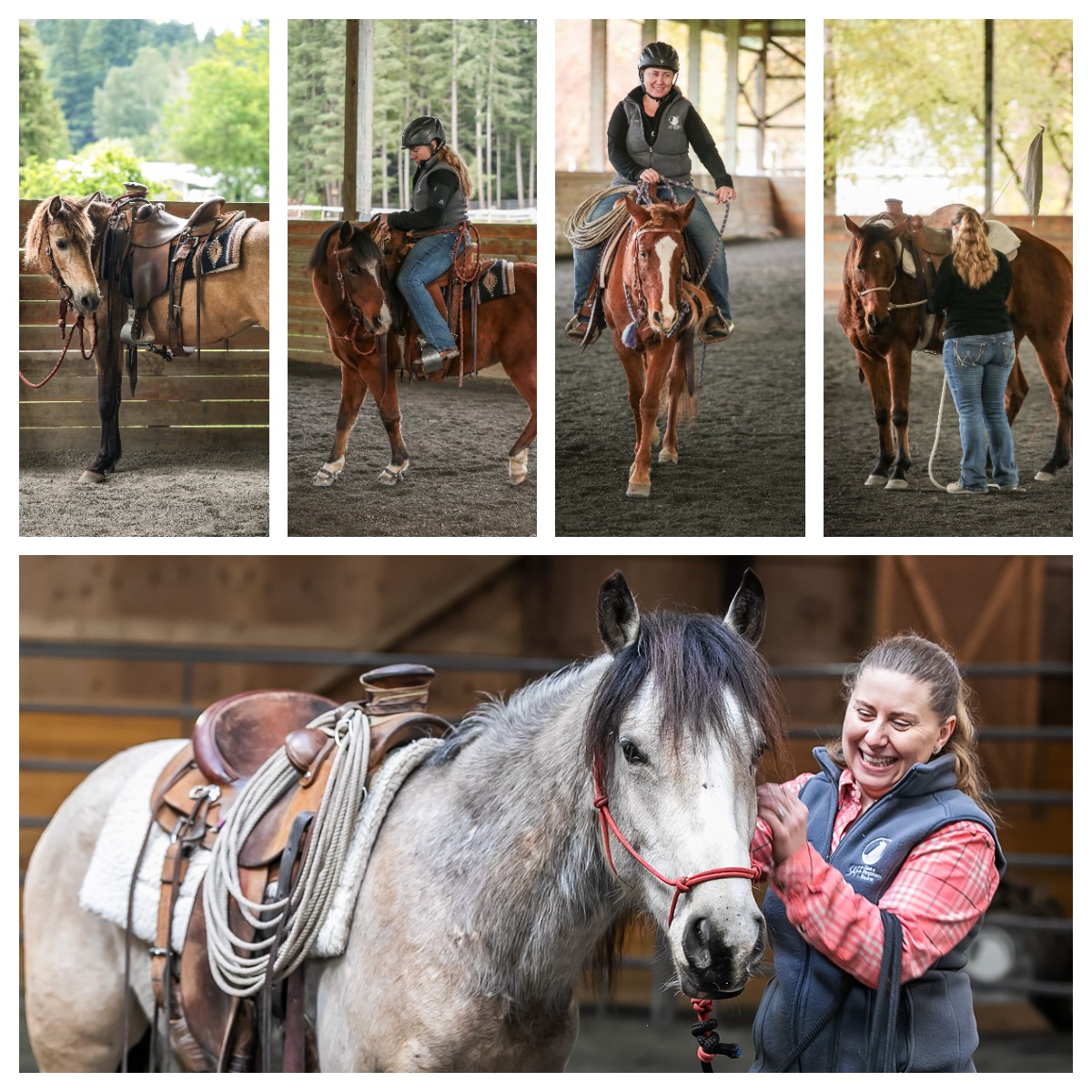
November Clinic Report: Frosting, Wren, Veronica, Artie, Esme
We finished off 2023’s training program horsemanship clinics on a high note. The incredible dedicated volunteers were like a well-oiled machine over the intensive five days. Wednesday and Thursday, we got our hands on 21 SAFE horses! From the barely haltered to those loping out on loose reins in the arena and some starting leg-yields and counter canter.
I had the pleasure of working 5 horses during the 3‑day clinic. I joyfully started every morning with a smile on my face and sweet nuzzles from our dear Frosting. This year she has been growing and for much of the summer was sadly in a very “ugly duckling” phase. I felt that she lacked the growth and physical maturity to really get on the “payroll”. I would pull her out a few times a month, dust off the groundwork and do a short ride. Each time she picked right off where I left her and felt good about letting her have time to grow.
This weekend she felt great! While I still think she needs time to fill out and muscle up into a riding horse, she felt ready to play with the big kids in class. We worked for about half of the class on building and keeping life, balance and freedom in her movement. She was a willing partner with a good expression and a ton more focus than we had earlier this year. I finished with her in the round pen with quick ride each day. The work we did in class helped these rides immensely. She had a good amount of life and checked off all the boxes quickly. She is going to be a nice pleasure horse for someone. She is a very willing, a kind hearted and well-behaved young mare.
For the second half of the morning ground work class, I took our recently started Wren. This special mare is hands down one of the nicer horses to come in this year and going to become a great riding partner. She has a ton of try and after working on freeing up her feet, she is becoming confident and relaxed. I can see the horse she will become and let me tell you, I like her! She will be sensitive and have a good amount of life as well as being a brave and willing partner.
I was very impressed with her changes throughout all 5 days of work. The last day Joel really helped her get her legs underneath herself and showed her how balanced and relaxed she could feel when she engaged her hind. He is remarkable with the horses and it was impressive to watch her transformation. After class I took her each day to the round pen for a short ride. We got some great changes and I could feel her each ride pick right up where we left off the day before. If she keeps this trajectory, she will likely become one of my favorite horses to ride at SAFE. It is said that the last horse you started is always your best and better than the ones before. I am grateful for all the horse that have taught me over the years. It is nice to see all the lessons they gave me, now helping Wren.
In the riding portion of class, I took in Veronica, Artie and Esme. I am literally jumping up and down with excitement for all three of these horses. Each one of them have come so far in the last year of riding.
Starting in June 2022 when Joel visited he would put a few rides on Veronica. I still remember feeling trepidatious when he handed me the reins in the fall and said she’s yours now. A lot of responsibility was transferred to me that day and with-it the stress to not mess her up! This week, I started calling her my war horse. SHE WAS SO BRAVE!! Anyone who has watched and followed her during her tenure at SAFE will agree, we were never 100% sure we could help gentle her, let alone if she was going to make it as a riding horse. She was up there as one of the hardest mares to come out of the Fall City Forty herd. There were many days that I thought she was going to come running through the panels and hurt herself. Her instinct to run away from anything and everyone was very strong. Today, she is one of the easiest horses for our volunteers to catch and lead. And in this clinic, her first riding experience with 14 other horses in the arena, she was a STAR.
The first day the wind and rain decided to not play nice. We had gusts of wind making roof insulation flap above our heads and leaves on the ground suddenly without warning flying towards us with. It would have been very acceptable for her to be nervous or jump, heck I even looked at the craziness around us and shook my head. She was a rock! I felt safe and confident that she was carrying me and that she trusted me, not only to keep her out of danger, but that we were a team. I love all of our horses, but I can say honestly, I really like the horse Veronica has become. I know that part of our success is the hours of relationship and trust we have built. I hope in the months to come to help her explore more of the riding world and introduce her to her future family. Joel said that he liked the freedom in her movement which is a great compliment for the tight and flighty mare we started last year.
Artie is done being called a slow poke! This clinic he showed us all that he has a GO button now! What a flashy pony he is becoming. We jumped into the riding class about half way through and he seamlessly fit right into the group. He was very punctual in his responses and his gaits started to open up. I asked Joel to help walk me through supporting him in backing circles to the right. This has been a sticky area and I wanted to make sure I was helping him correctly. Joel helped me work him through it by freed his feet up backing straight and timing up a release when he could hold the right flexion. Artie still has some rough spots like this where the wild man we took in shows up. I am very mindful how quickly things could go wrong if he didn’t have a confident rider. He can still get wide eyed at new things and takes an experienced rider to support him. But I know he is worth the effort! Just a year under saddle and feeling like he is path from here is bright. It is wonderful to see this once difficult stud turn into a gentleman gelding. He is making steady progress and really is a hoot to ride.
Lastly, I brought Esme out to work the last day of the clinic. She had two days off and as expected was a bit tight in the beginning but after some good ground work settled into the ride. After a year of riding, Esme is still very tight mare. She is like a little ball of energy and it has been a struggle to get her to fully relax and unwind. She has a very curious and has a genuine kindness about her but when in a bind she still feels trapped and become anxious. Out of all the horses I am working right now, she is the tightest. We get along but if something externally grabs her attention, she is not quick to relax. The biggest help has been on working on her feeling free to move which helps her letting down. When she relaxes, you can see her strides lengthen and her movement less balled up.
She isn’t the most troubled or difficult horse but I do have to manage the rides and support her to unwind. There is zero filling in for the rider and she would not give a young or novice rider any confidence. I was pleased that during our ride she was following my line nicely and finished comfortably at the end of the ride with a lovely walk, trot, lope and stop on a loose rein feeling of me. I trust that with the tools we have now she is going to make it. She will just take a bit longer to become the relaxed ride most adopters need. Hopefully with some good work put in this winter, others at SAFE can start riding her and she can maintain relaxation.
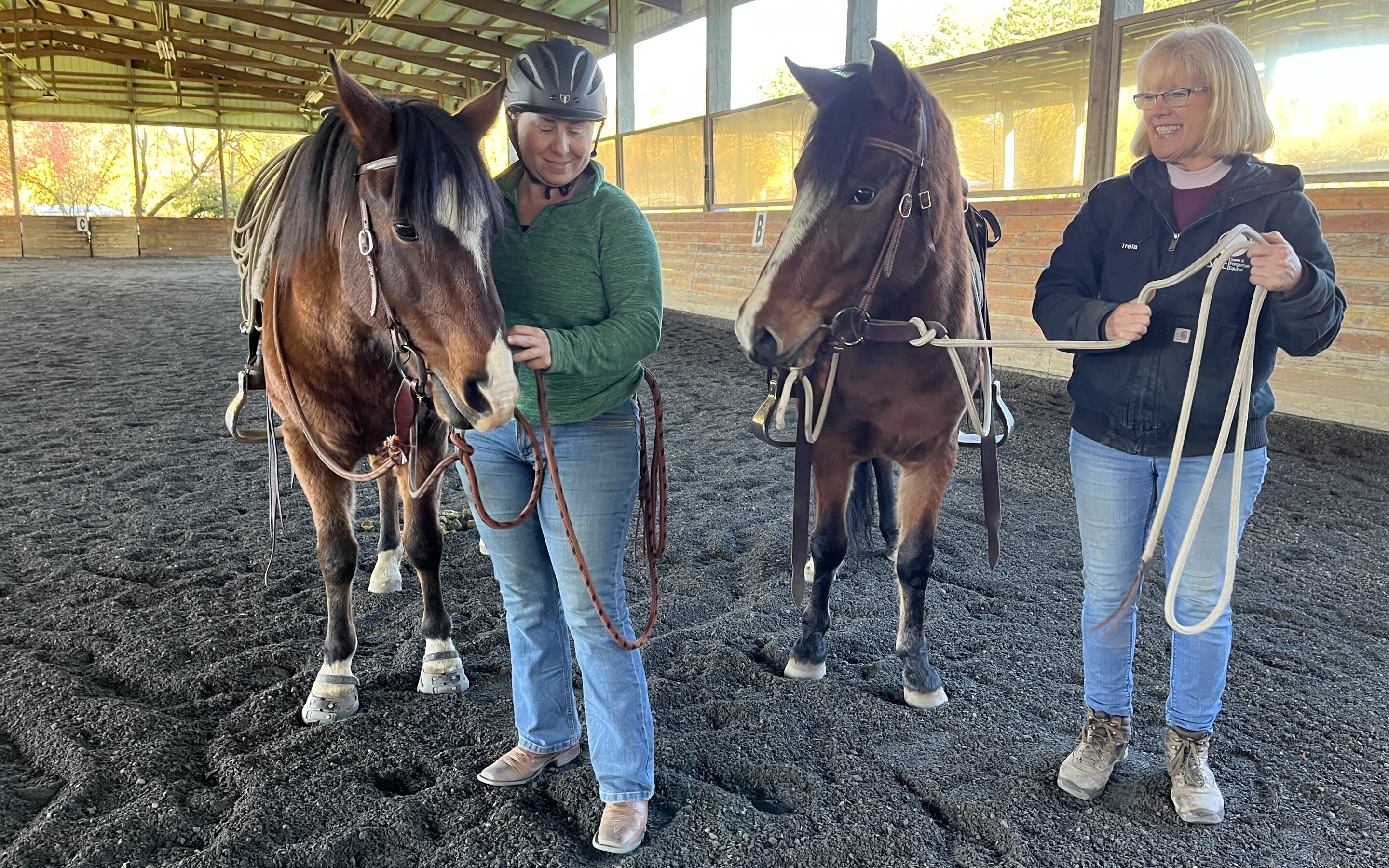
Twinning with Artie and Pepper
Halloween might be over, but it appears that Pepper and Artie are still dressing up as one another! These two are truly doppelgangers, and as they both hail from the Fall City 40 herd, it may be that there is some genetic connection to their similar looks. But regardless of if they are any percent related, they are both 100% cute!
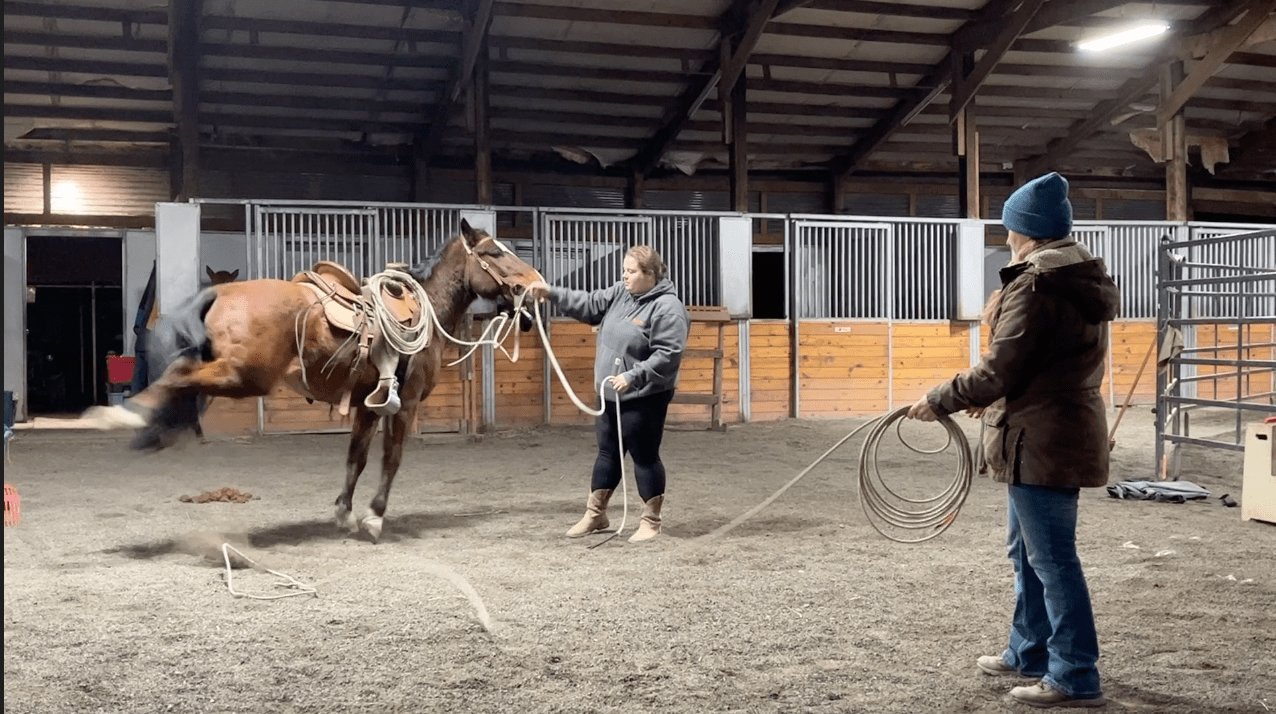
Training Update: Artie Changing Eyes
Much like watching a plant grow, it is difficult sometimes to see the change in something unless you can clearly see from where you began. Sure, you know it’s different, but how different can be hard to quantify without a comparison.
We first met Artie as a untouched stallion, one whose extreme amount of self-preservation came by way of necessity. When you’re defending a band of mares, it works in your favor to always be looking over one shoulder, to react strongly and quickly to something coming over top of you, to kick out at things that have the misfortune of rubbing you the wrong way. But when you’re a horse bound for domesticity, these traits become a bit less desirable. The threat of things above you makes it very difficult to ever wear a rider, and the casual brush of something against your hocks means the farrier needs to consider taking out a more robust life insurance policy before touching your feet.
Artie showed us from very early on that these ingrained traits would not go quietly. His initial reactivity was what had us relegating him to companion status in the first place, feeling that the amount of work it would take to make him a safe riding horse would lead us all down a steep and difficult road. But if horses do anything, they surprise us time and time again. Artie showed us that with a little bit of patience and a lot of time, he could accomplish those things we thought were out of the cards for him, one example being working through things in his blind spots.
In his early days, Artie had an incredibly difficult time changing eyes. Having something behind him in his blind spot, even for a moment, caused him a lot of anxiety. On his better days, this looked like a quick spin. On his not as good days, it looked like a sharp kick in the direction of whatever was behind him. So much time went in to helping Artie through this spot of anxiety — hours upon hours upon hours spent helping him change eyes, showing him that that scary flag or rope or person wasn’t out to get him. And slowly, sometimes nearly imperceptibly so, Artie began to change, to see the light, if you will, even if that light was in his blind spot at first.
This short video shows Artie at a place close to where he began (those earliest days, unfortunately, live only in our memories), fearful and anxious to change eyes. It ends with Artie where he is today, a lot more willing to let people in that blind spot, to change eyes, to have things touch him. Something I didn’t mention was Artie’s other blind spot, under the chin, which is a story for another time. But you can take my word for it in believing that he has come a long way in this department as well.
We knew that Artie has transformed from a seedling into the beginnings of an impressive tree, but it is very fun to be able to watch back and see exactly how far he has come!
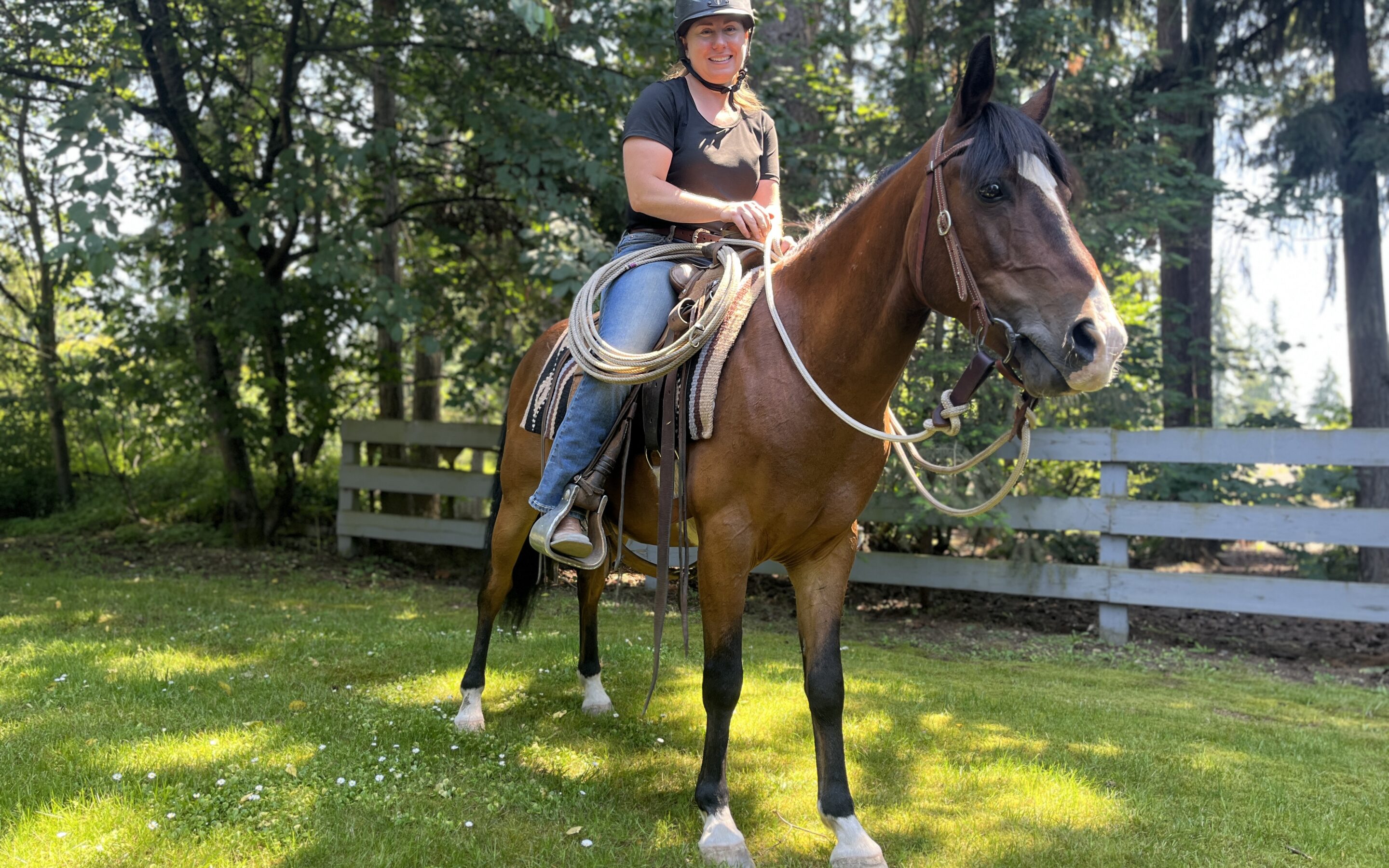
Riding Out with Artie
Artie has spent a great amount of time under saddle recently, and while he has been on the occasional traipse around the property, he had yet to explore the big wide world… until now!
We at SAFE are lucky enough to be situated beside a park, which means we essentially have backyard access to horse trails. With the weather how it is, dry and hot, we do our best to make it out for trail walks as often as our busy days allow for. Some days, this looks like us handwalking our horses through the forested trail, reminiscent of going on a hike with an overlarge dog. But other times, the horse is feeling so good and the timing is right that we can ride out. Everyone has to have their first ride sometimes, and recently, it was Artie’s time to test his mettle out away from the comfort of his familiar round pens and arenas.
As you can see, he did a stellar job. Almost immediately after walking on to the quiet of the trail he let down with several big exhalations. He was comfortable leading the pack, but was equally as relaxed when his temporary herdmates disappeared around a bend and he lost track of them.
Artie is still available for adoption as a riding horse. He is still quite green, so will need more miles under saddle out on the trails with a confident rider, but from what we’ve seen thus far it looks as though Artie could really go places as far as being a little trail pony goes.
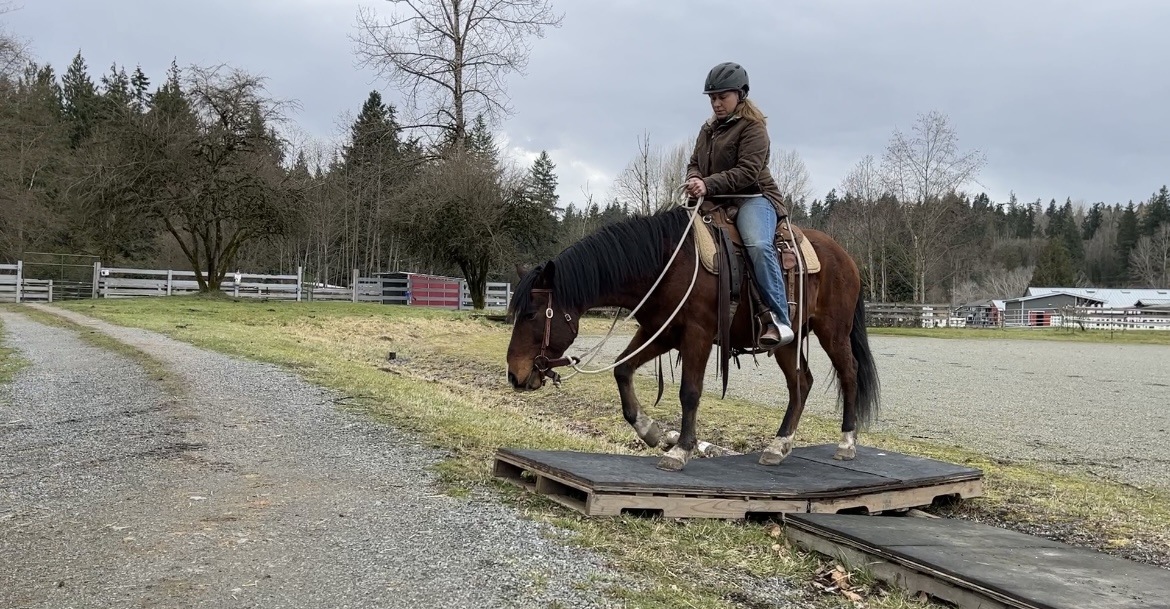
Artie Out on the Town
Given how mellow he has been under saddle thus far, we had no reason to believe that Artie would not be able to find as much comfort in his rider outside the arena as he did within it. And our hypothesis was proved correct when taking him out for the first time for a walk around the property. Artie was a very brave boy, walking over pallet bridges, through puddles, and by all sorts of birds and other creatures. We are excited to get this guy out on the trails for real, but expect him to make someone a stellar companion in all sorts of environments.
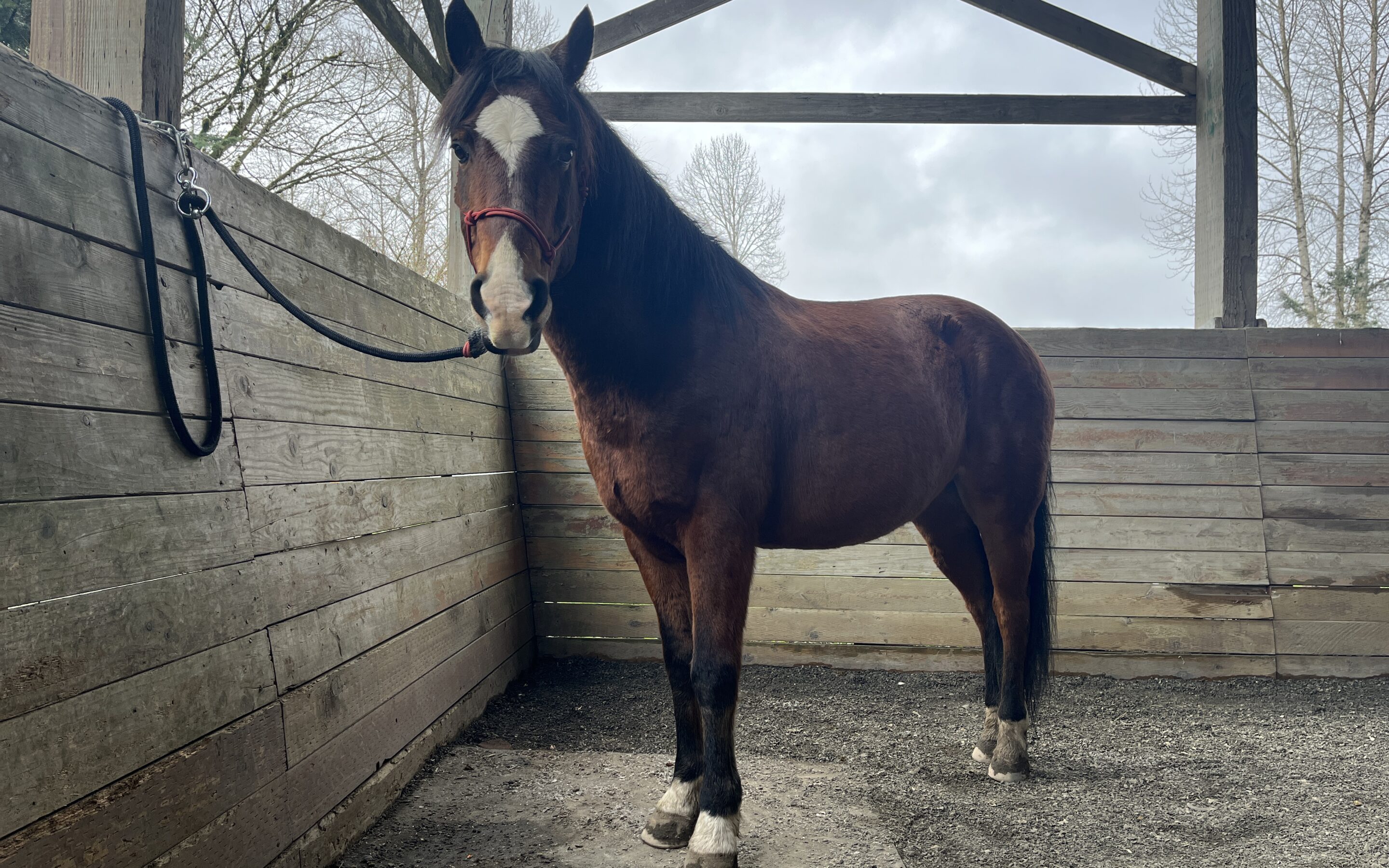
Artie 4 U!
Extra extra, read all about it — Artie Shaw is available for adoption as a riding horse! There was a time, not all that long ago, when we wrote riding out of Artie’s future. His first experiences with the saddle were so dramatic that we felt the time and effort it would take to get him comfortable, not to mention the risk involved for those humans on the ground, seemed to outweigh the potential gain of making him a riding horse. But then a situation arose that alleviated us of having to make a choice, for Artie found a home as a companion horse.
Artie’s return to SAFE a year later was unexpected, but not unwelcome. It gave us another chance to check in with him, and what we found was that Artie was ready for a second try.
So now, going on 4 years after his arrival as a wild stallion, Artie is ready to go to his forever home as a riding horse.
Now for the details: Artie was only started at the tail end of 2022, so he is still considered green, and will need an adopter who is comfortable with putting more miles on a horse and helping support him through new experiences. Artie is also more woah than go at this point, so would do best with a rider who can keep him lively and moving to prevent him from dulling out. However, Artie has so far felt very safe to his riders – he is not spooky, and handles new environments like a champ. He’s spent some time riding in the outdoor arena recently, and even amidst geese honking and the energy of other horses working nearby, Artie kept his cool. Really, not much seems to bother him these days.
The same is true on the ground. Artie is a complete and total puppy dog to handle (his nickname amongst staff and volunteers is, in fact, ‘puppy,’ because of his gentle disposition) and has really transformed into a model horse citizen. He is safe for nearly anyone to halter, lead, groom, and blanket, and he is a horse who I feel confident introducing non-horse people to because of his gentle energy and kind disposition. He does very well in a herd, and tends to get along with all types due to his tendency to stay out of trouble. He is currently good buddies with Otto, and the two play for hours each day. But despite his friendships, he is not herd bound.
Artie is a truly special horse, and we’re so excited to start showing him off to adopters.
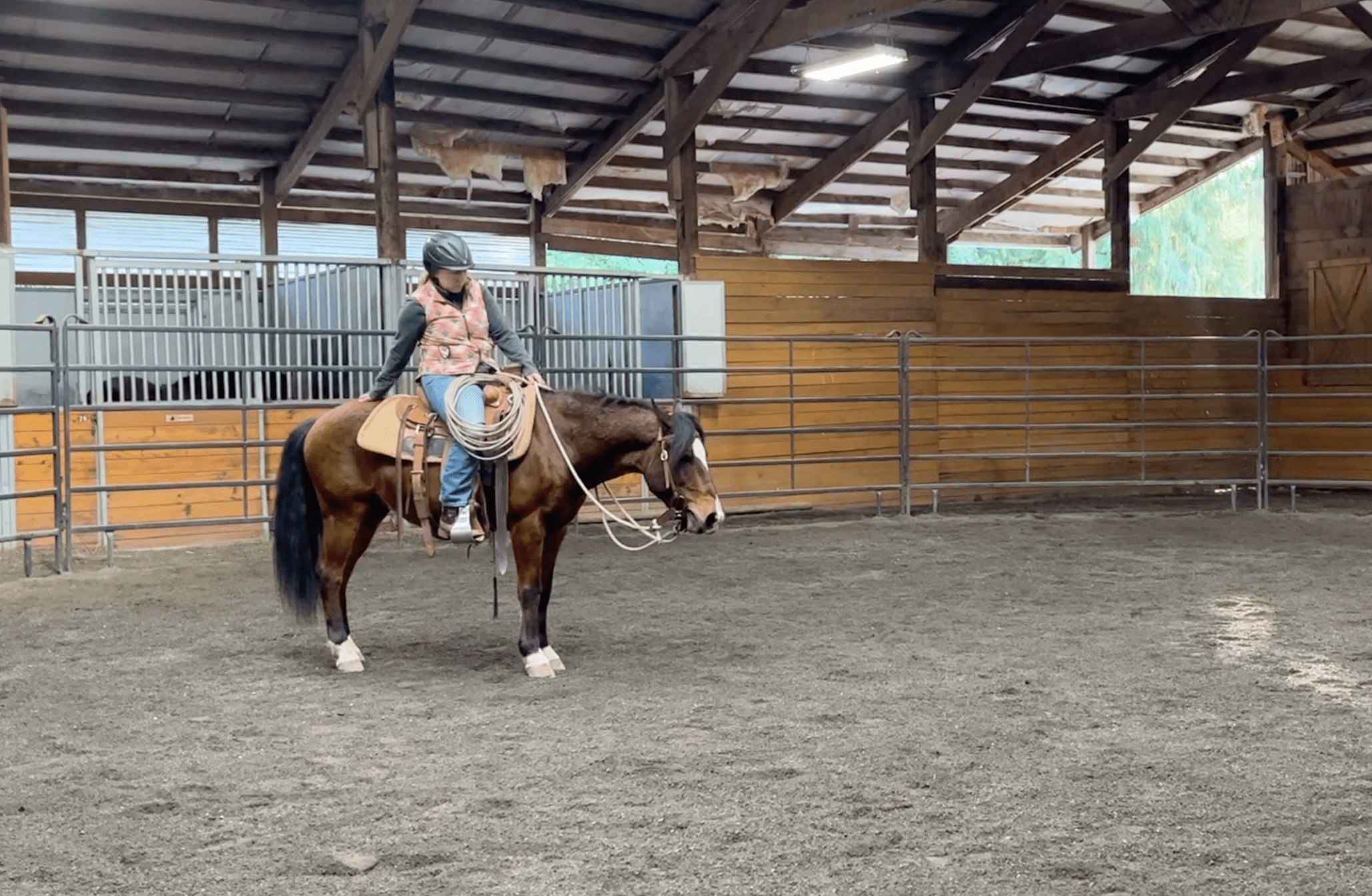
Training Update: Artie
Since his debut as a riding horse at the end of 2022, Artie has really shown he is the little horse who could. From his early days as a literal wild stallion to now, it’s hard to even picture him as the same horse. His nickname around the barn now is ‘puppy’ because of how sweet and docile he has become, and his temperament under saddle is mostly just more of the same. He has a tendency to get dull, and therefore needs a little bit of a kick, literally and figuratively, to get going sometimes, but he has made major improvements in his life since his first rides. He is much more likely these days to take his rider up on the good deal of their first ask, rather than them having to resort to a more firm aid.
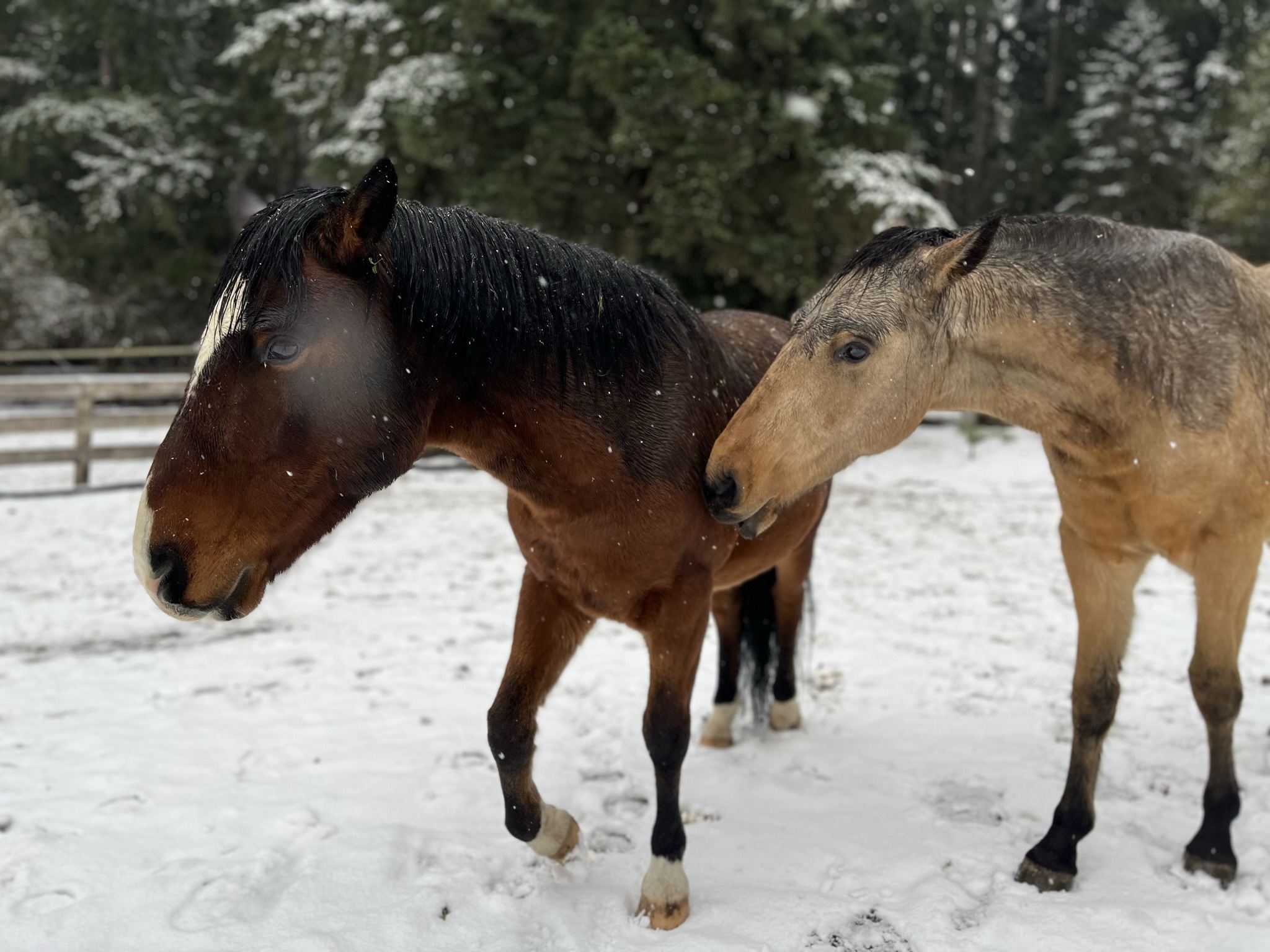
Otto’s Playmate
Though one might say he is mature for his age, based on how well he is going under saddle and his general level-headedness, the fact remains that Otto is still just a young lad, not yet 4. And boys, as they say, will be boys. Otto has been getting into some shenanigans as of late, with none other than his herd mate, Artie.
After they get turned out for breakfast and eat said breakfast (typically, Otto and Cramer share a net, as they have done since they were reunited earlier this year), it is play time. It doesn’t matter what Artie was doing before, or what his plans for the day were, because now, says Otto, it’s time to play. Playing, as it turns out, is a full time job, a real 9–5 activity. Every time you turn your eyes to the paddock where these two live during the day, it’s WWE.
And I say WWE because of its notoriously staged and scripted nature. The fighting that Otto and Artie do is (mostly) all bark and no bite. The majority of the time, it consists of Otto engaged in a slow-mo chase with Artie, nipping at various parts of him, until Artie gets fed up and nips back. Then the two titans clash – sometimes on two legs! – before engaging in a slightly faster chase sequence, separating for a moment, and starting the whole process over again.
While Otto might try to start something with Cramer on occasion, Artie is his go-to sparring partner on the daily. There is no limit to the amount of gelding mouth games they can play in an afternoon, and I’m convinced the only thing keeping them from going at it all night is the fact they come into separate stalls.
So far, any injuries they might deal to one another are minimal (“Tis but a scratch”), and we are sure to monitor their play for any hints of escalation. But for now, the boys seem happy to spend their days goofing around, bein’ boys, bein’ horses.
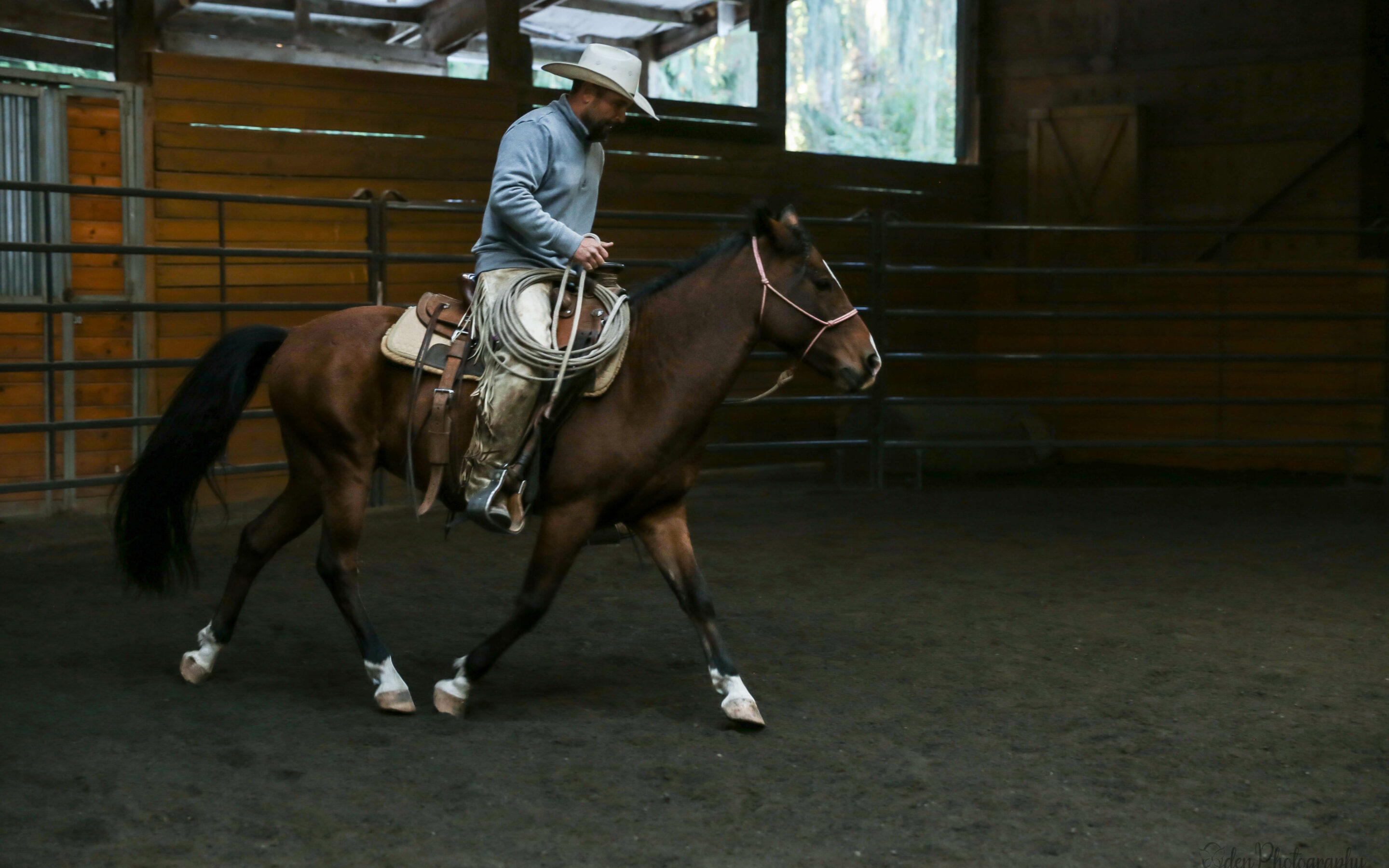
Artie is a Riding Horse
Well, it’s official: our sweet, handsome little Artie is a riding horse, and we couldn’t be more proud of him.
Lexee N has been working with Artie for the last few months, and has been a huge part of this guy’s transformation. She calls him “Artie the wonder pony!” and says his tagline could be something like: “Coming to life under saddle in all the right ways!”
Emphasis on ‘life.’ His first rides would have never indicated that his first saddling went the way it did, with him doing everything in his power to get the saddle off from the moment it was cinched up around him. The preparation leading up to the moment Joel swung his leg over was immense, and it was this same preparation that made that first ride so, dare I say, easy.
Artie does not have much get up and go, however, so getting him to move out was a difficult endeavor. That will definitely be a spot to work on with him going forward (no pun intended) to ensure he stays responsive moving up through the gaits. Having a second person in the arena with a flag to help move a horse like Artie out helps the rider to not have to do as much, and teaches the horse how to come up off the feel of the rider’s seat vs. their legs. After only a few sessions using this method, it was clear that Artie was understanding a bit better, and ‘feeling’ of his rider more. As Lexee put it, “He’s a character that tends to work smarter not harder which can be difficult to convince him the balanced way is the right way. However, that said, his tool box is slowly becoming a tool bench and he knows what to reach for now.”
Artie’s tool bench, as Lexee puts it, will only continue to grow as the pair continue their groundwork together, and those same tools will come in handy for his riders as well. We are so delighted that this amazing guy “made it” under saddle, and can’t wait to see what the future holds for him as his training continues.
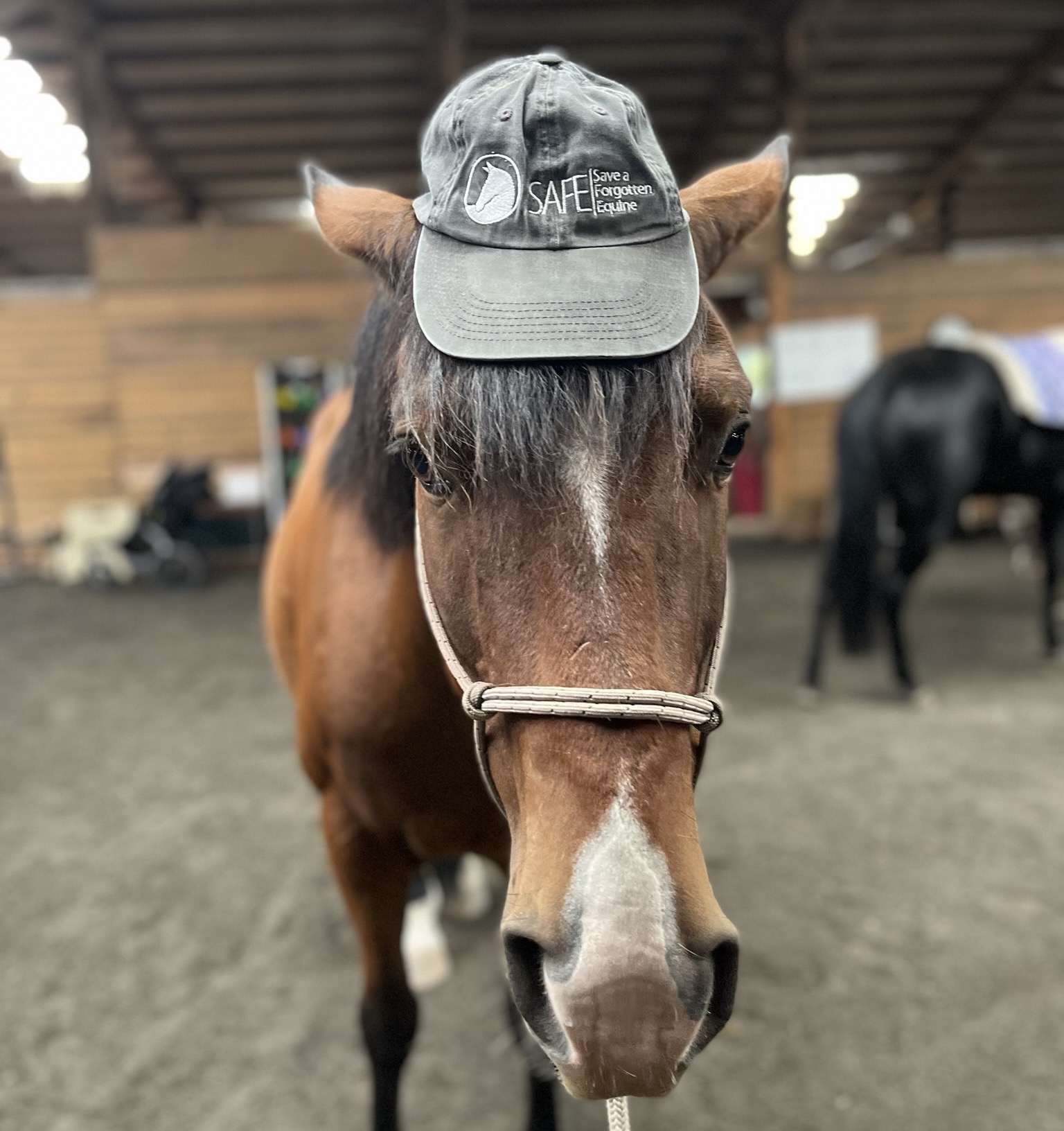
Handsome Horse Modeling School
Horse, or hat model? These days when he’s not wearing a saddle, Artie Shaw entertains with displays of handsome stoicism to rival any fashion week editorial.
I jest, of course – a hat perched atop his head is not a common look for Artie. And while I’ll be the first to admit it’s quite a delight to play dress up with a handsome little horse, the fact that Artie allows such childish displays speaks to just how far he has come. It was not long ago that even the suggestion of something passing over his ears, let alone something perched atop them, was enough to set him off into a nervous spiral. Artie’s growth has been exponential, and this small, silly display speaks to just how astronomical those leaps and bounds have been.
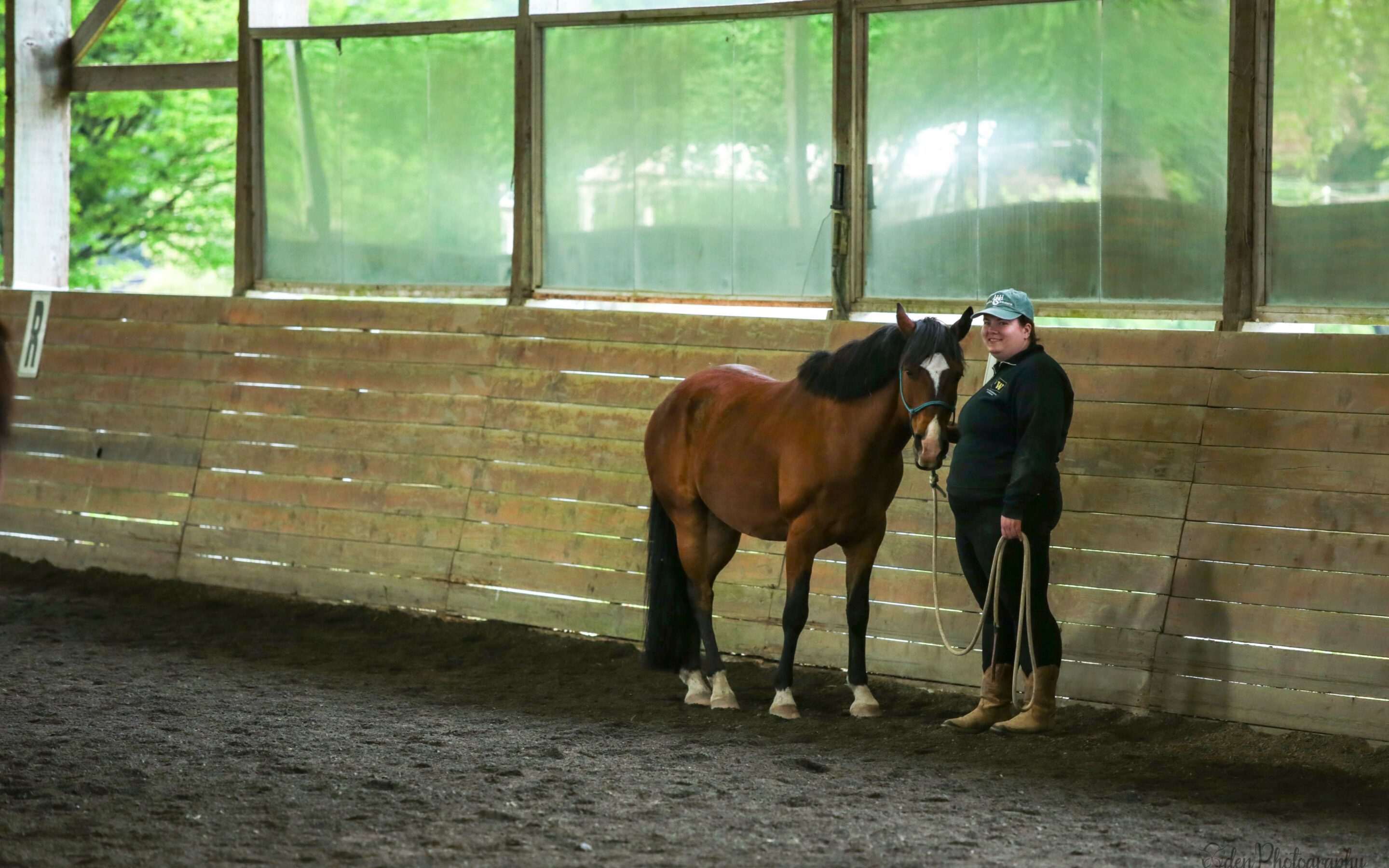
Artie’s Second Chapter
When a horse leaves SAFE for its new home, we hope that there is a ‘forever’ tacked in front, but this is not always the case. But our commitment to a SAFE horse is lifelong, and when Artie needed to return to us, we welcomed him back with open arms.
Artie had left SAFE as a companion. This was not always our intent for him – an able bodied young gelding like Artie was more than capable of becoming a riding horse. But his years spent as a stallion, defending his band and himself in the veritable ‘wild’ he was rescued from had made him cautious, perpetually concerned with the threat of danger descending from overhead. This trait, while very useful for survival outside captivity, is not one very well suited to domestic life. When we first started Artie’s training under saddle and saw immediately how difficult it would be for him to unlearn his ways of self-preservation and be comfortable with a rider on his back. There comes a point in our assessment and work with a horse where we determine that what the horse would have to go through to be a safe riding horse would not be worth it to them, and we are fully under the belief that just because a horse is not a riding horse does not make them any less valuable. So when Artie found a home as a companion, we couldn’t have been happier for him.
And you already know what happens next. Artie returns to SAFE, and to greet him again as a domestic pony while his wild stallion days still remain fresh-ish in our minds is the best kind of shock. Here is an Artie who has learned how to wear a blanket, and who has stood for a fresh cut from a pair of clippers. Artie has grown since his days as a feral thing, confined to a round pen for fear he’d make a break for it. We took Artie’s return to SAFE as a new chapter in his life, to be filled with some new experiences.
After Terry’s initial assessment, Lexee N began groundwork with Artie. After hours in the round pen together, working their way through the Red Book, it was determined that becoming a saddle horse was perhaps not out of the question anymore. But they would have to take things slow, go at Artie’s pace, which was fine by all involved parties. Our horsemanship volunteers are nothing if not patient, and so Artie’s new journey began.
So far, things are going well for these two. There are many steps taken to prepare a horse for being saddled and eventually carrying a rider, but as Lexee assures Artie, they have all the time in the world.
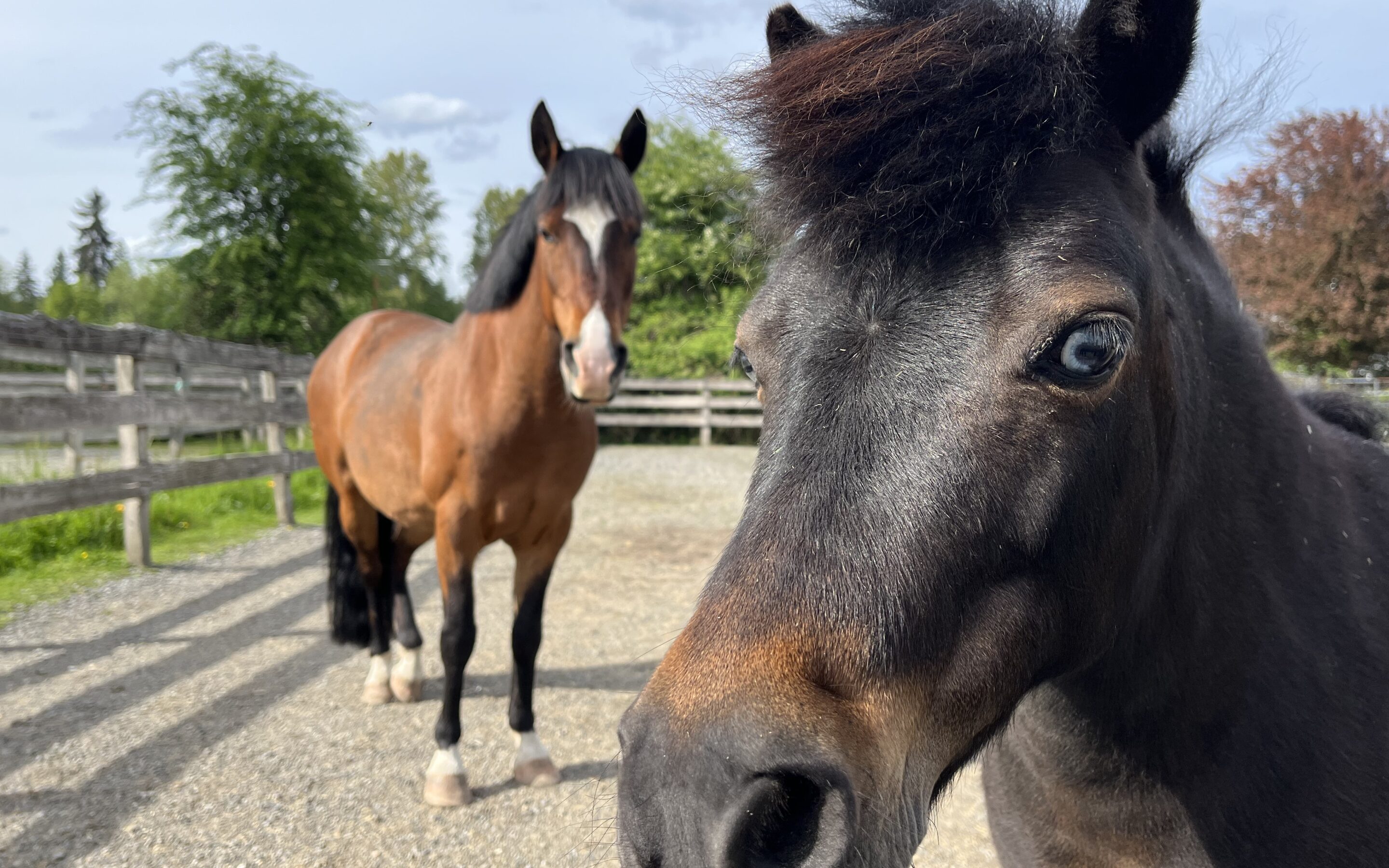
Artie and Ruckus Return
Due to sudden life changes, Artie and Ruckus’ owner needed SAFE’s assistance in rehoming them. We commit a lifetime of safety to each and every horse who passes through our care and we picked them up this week.
Artie had many fans before leaving SAFE last summer, so many of the volunteers will be happy to see him peeking out his former shelter window, where he enjoyed flipping his hay bag out to enjoy dinner with a view. Ruckus, having been adopted in 2017, doesn’t have as many fans… YET! However, when everyone gets a peek at his small stature and adorable blue eyed face, his paddock will be sure to become one of the most visited.
The two are settling in nicely and seem to be the best of friends. When fed, they prefer to share one hay bag, even though there are two options. We look forward to reacquainting ourselves with these two cuties and beginning the search for their next lucky adopter.
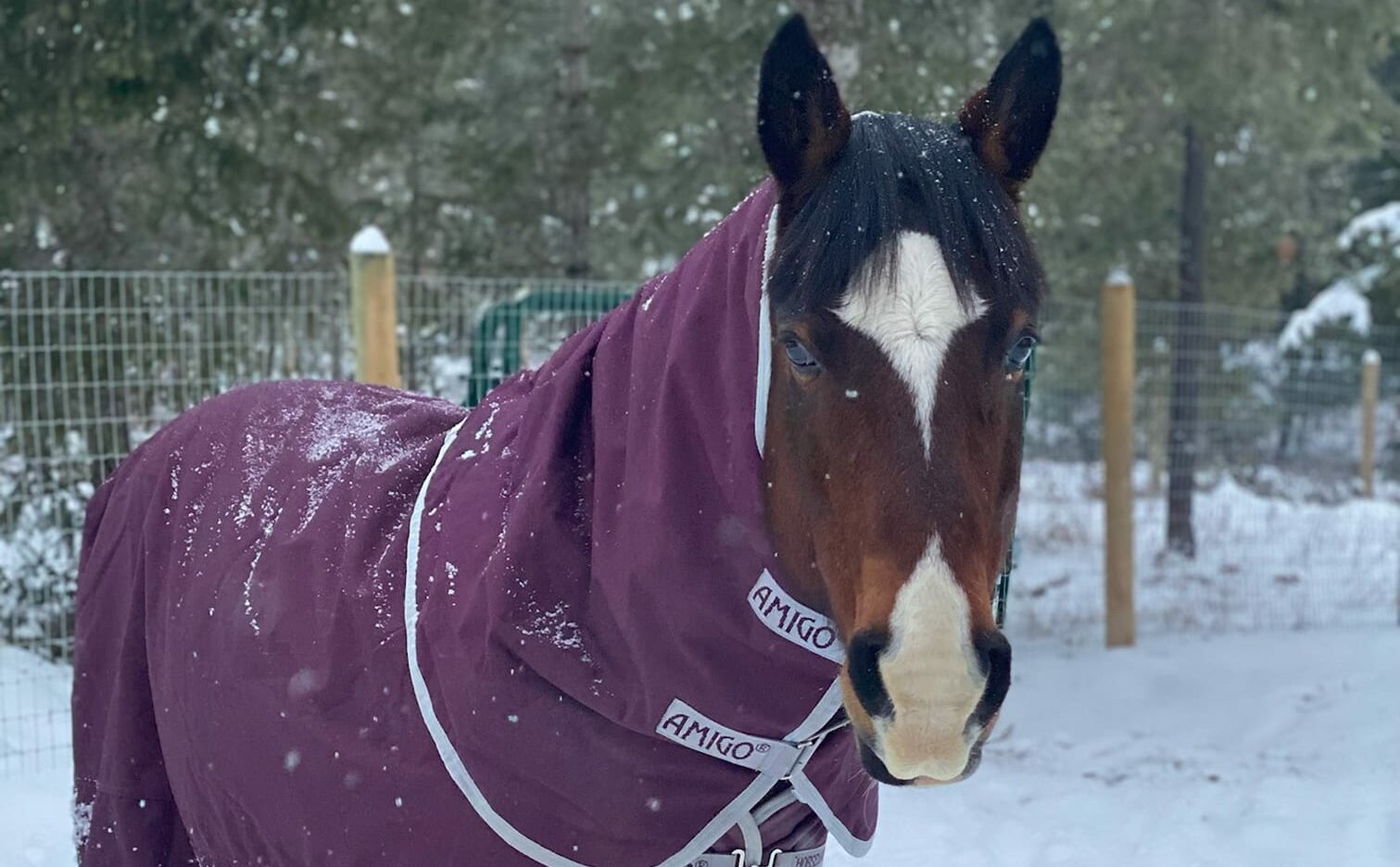
Cold Weather is Coming!
Our Alumni’s get the best treatment! With the cold temperatures going into winter, we’ve had some cute photos sent to us with horses all snug in their mid weight blankets. In their previous lives, many of these horses had to fend for themselves during harsh weather conditions. Now they have wonderful families who add a little coziness to their lives which not only keeps them warm, but warms our hearts.
- Artie, with Ruckus
- Ruckus
- Checkers
- Breve
- Kat
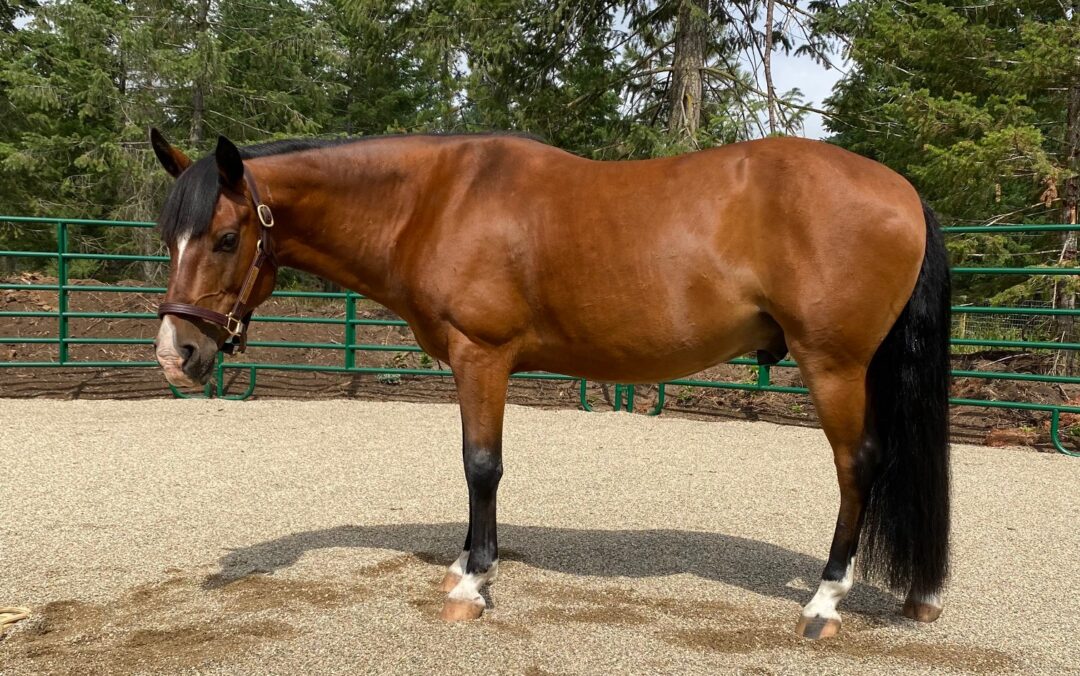
Artie is Adopted!
Artie is adopted and he lives with a SAFE Alumni pony, Ruckus! Jacquie was looking for a companion to live with Ruckus and turned to SAFE searching for a horse buddy.
As the Volunteer Manager, I like to ask volunteers if they have a favorite horse at SAFE. Of course, many reply with “I like them all! BUT if I had to choose, it would be…” There is usually a horse or two that stands out to each one of us. Artie was my standout horse and most recent favorites on the farm. Most people who spend a little time around SAFE talk about the transformations the horses go through. It’s a cool thing to witness a horse with an uncertain future arrive at SAFE fearing people and see them transform into a calm horse who now has a bright future. Spend some time in the barn and you will hear current volunteers telling brand new volunteers stories of how “That horse was so thin,” or “that horse was scared of everything” and “Wait until you see them now, they are a whole new horse.” Artie was one of those horses.
He was part of the Fall City 40 situation two years ago. Many of those horses were adopted out to qualified homes, but those who didn’t find homes, came at SAFE. Artie was still a stallion when he arrived, so he was separated from all other horses and only staff were allowed to clean his paddock. He was always very respectful, standing on the opposite end of his turnout, always calm, but keeping a watchful eye on you. Terry, our Operations Director, spent her time getting him to trust her and slowly introducing the halter and human touch. Artie took longer than most of our horses and Terry spent a lot of time closely working with him. It was a long time before we could walk him outside of his paddock. Artie was once a horse who stayed as far as he could from people and easily spooked and right before he left, he was a horse that walked right up to you to be haltered.
There are many reasons I love being part of SAFE, but one of my favorite reasons is they listen to the horses’ needs. Most of the time if a horse is young and healthy we start them on a path to becoming a riding horse. Most adopters are looking for a riding horse, so it makes sense to make them the most adoptable they can be. Occasionally along the way we learn that a particular horse is not suited for that path. After working with Artie for quite some time, the staff came to the conclusion the nicest thing to do for Artie was to offer him as a companion horse as he struggled with things coming down over him. How would he ever except a saddle and rider and how long would it take? We believe his time as a stallion he was constantly protecting his little herd of mares and babies from other stallions who would come down over him. As a healthy 8‑year-old horse, some might want to keep pushing him, but SAFE made the kindest choice for Artie to live his life free of the stress of something on top of him. This could make it harder to find him a home, but it was the best decision for him. So, you can imagine how overjoyed everyone was when we knew he was being adopted!
When Artie arrived at Jacquie’s place, she took a video of him being walked onto the property. All you can hear is his new buddy, Ruckus, calling repeatedly in the background. You can hear the excitement in Ruckus’ neigh and the giggles from Jacquie as she films his arrival. Shortly after we receive updates that Ruckus and Artie love each other, they are immediately playing, trotting around and insist on eating out of the same hay bag. Jacquie is in love with our handsome man and so is Ruckus.
Jacquie recently sent us this update: “It’s been a month since Artie arrived home and each day I’m more in love with this boy. Not only are him and Ruckus total buddies, but he is so smart and quick to learn. He has learned how to stand tied, be patient for things, get baths that make him feel good, wear blankets of all kinds and relax in his work. He is also learning his body has Dressage gears he didn’t know he was capable of. He is amazing to work with once he finds things are no big deal he moves forward with great confidence. He gets to take tours of the property and has quickly learned the garden rocks will not eat him. He is consistently giving me his eye, checking in and paying attention to what’s next. He likes to check out what we’re doing around the farm and he and Ruckus are both the gate greeters when you go over for a visit. He is an incredibly sweet boy with a wise and silly personality and I absolutely love him.”
The day Artie left to his new home, Terry posted on her Facebook page “You’ve taught me more in a year than any other horse. Our time comes to an end, but I celebrate every single accomplishment and the gravel you put in my guts! Artie, you will never be forgotten. My sweet boy, I will miss you. Thank you for trusting me. I love you.” Artie was very loved at SAFE and we are so happy we found a family who instantly loved him as much as we do.
- Artie and Ruckus meet for the first time
- Sharing is caring
- Brothers from another mother
- Artie wearing his cooler!
- Artie with his adoption card!
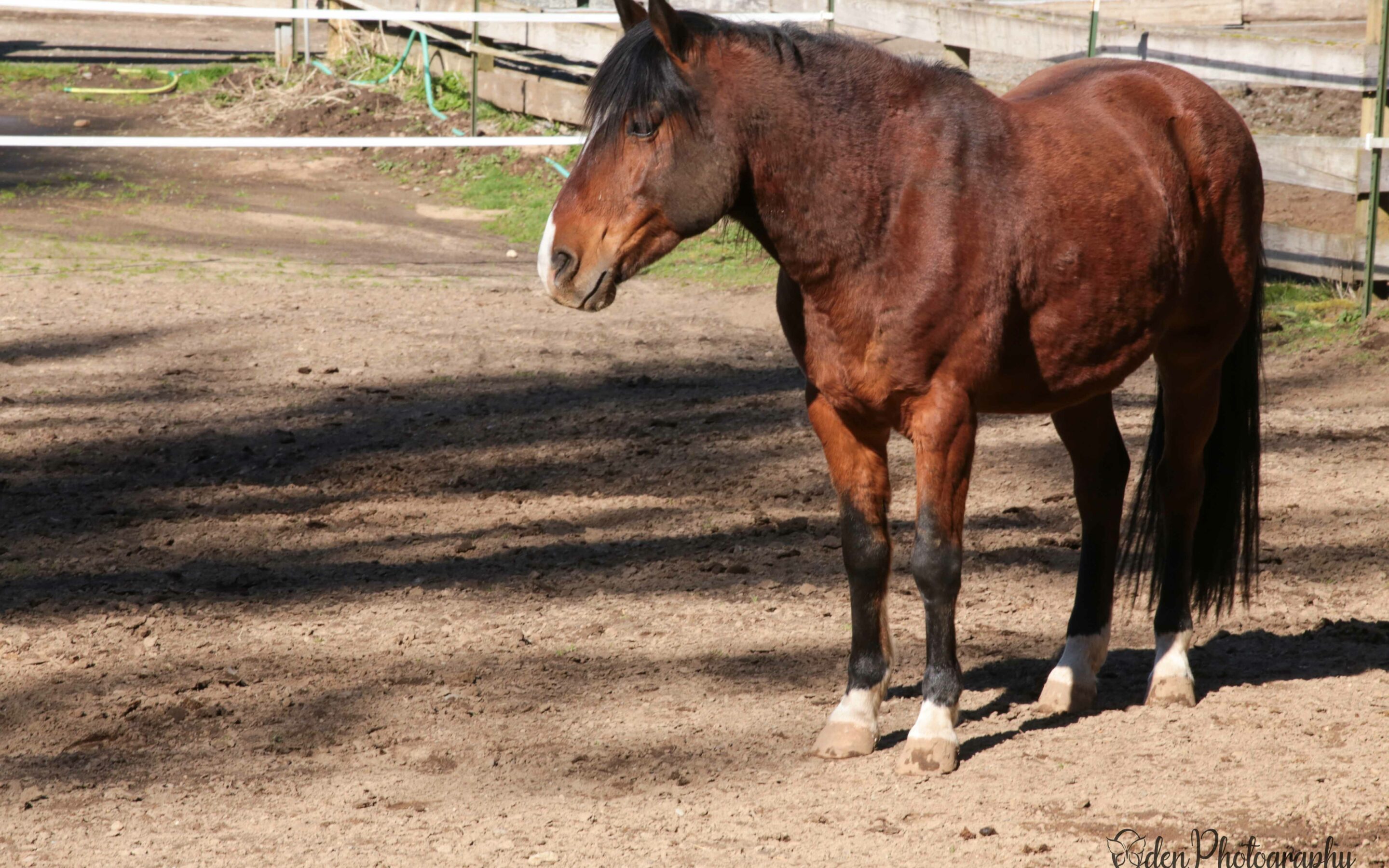
Assessing Artie
Artie’s start to life was different than most horses, even compared to most horses that arrive at SAFE. He was a stallion before his arrival and spent his time in a fairly small space having to protect his little herd of mares and foals. He was most likely constantly defending himself from other stallions. It is no wonder that Artie struggles with having things come from behind him and above his head. This is a conundrum because how will we get Artie used to having a person on top of him, riding when he is used to predators and danger coming down on him. Looking at this through Artie’s eyes, he’s not a bad horse, he has his reasons for his actions and we continue to try and show him he doesn’t need to be protective of himself of those who are not trying to hurt him.
At this time, we continue to help him advance his abilities to possibly be a riding horse through our training program. We have no expectations that he must become a riding horse and will constantly evaluate what is best for him. At some point SAFE may consider discontinuing our attempts to saddle and ride him if the level of risk for those involved is too great or the time, energy and resources to start one horse no longer makes sense.
Artie has come very far in his other areas of training. He now has good ground manners, holds still for the farrier and has worked through his fear of being vaccinated. He has come to a level where he could have a
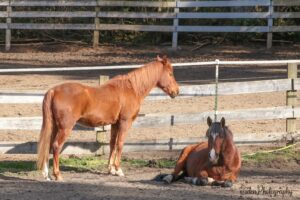
Artie relaxing with his friend Anderson
perfectly happy and healthy life as a companion horse. If we decided to have keep Artie as a companion, that would mean he would not be allowed to be riding horse for the rest of his life, however there are many opportunities to further his abilities through hand lead obstacle trails and groundwork. He is extremely smart and as a gelding he is very gentle with other horses and people. Every horse we add to Artie’s paddock, he welcomes in as a new friend. He truly is an easy-going, gets along with everyone, guy.
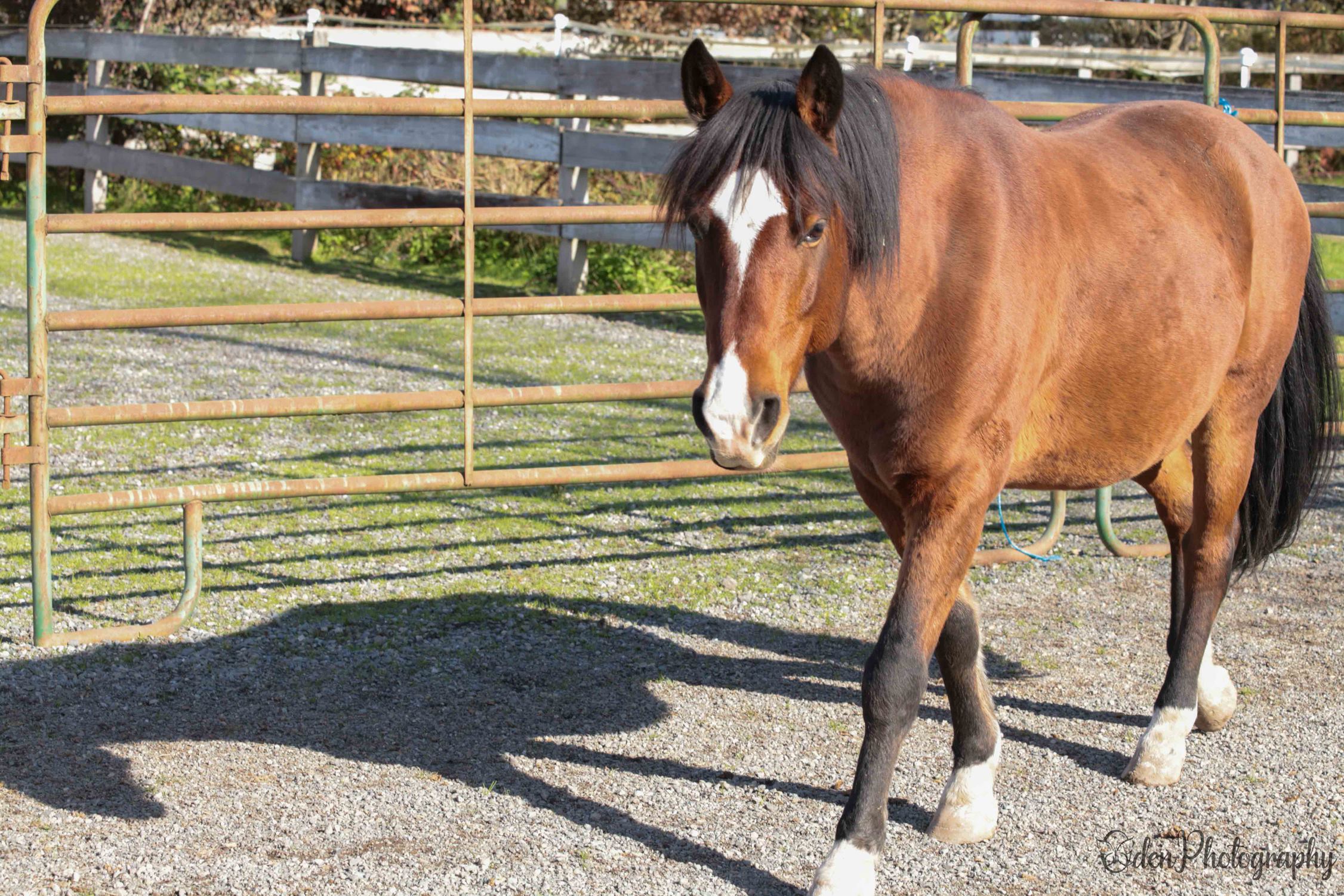
Artie Shaw Crescendos to New Heights
Little mister Artie sure is becoming a gentle little gelding! While he still has quite a ways to go in his training, the amount of improvement that Artie has shown is incredible. It wasn’t that long ago that Artie was the wild stallion kept in the round pen because he couldn’t be led out. Now he comes into a stall for the night! The same horse that couldn’t handle a rope going over his ears is now carrying a rope around his hind end and changing eyes without scrambling. The future is bright for Artie!
Artie Photo
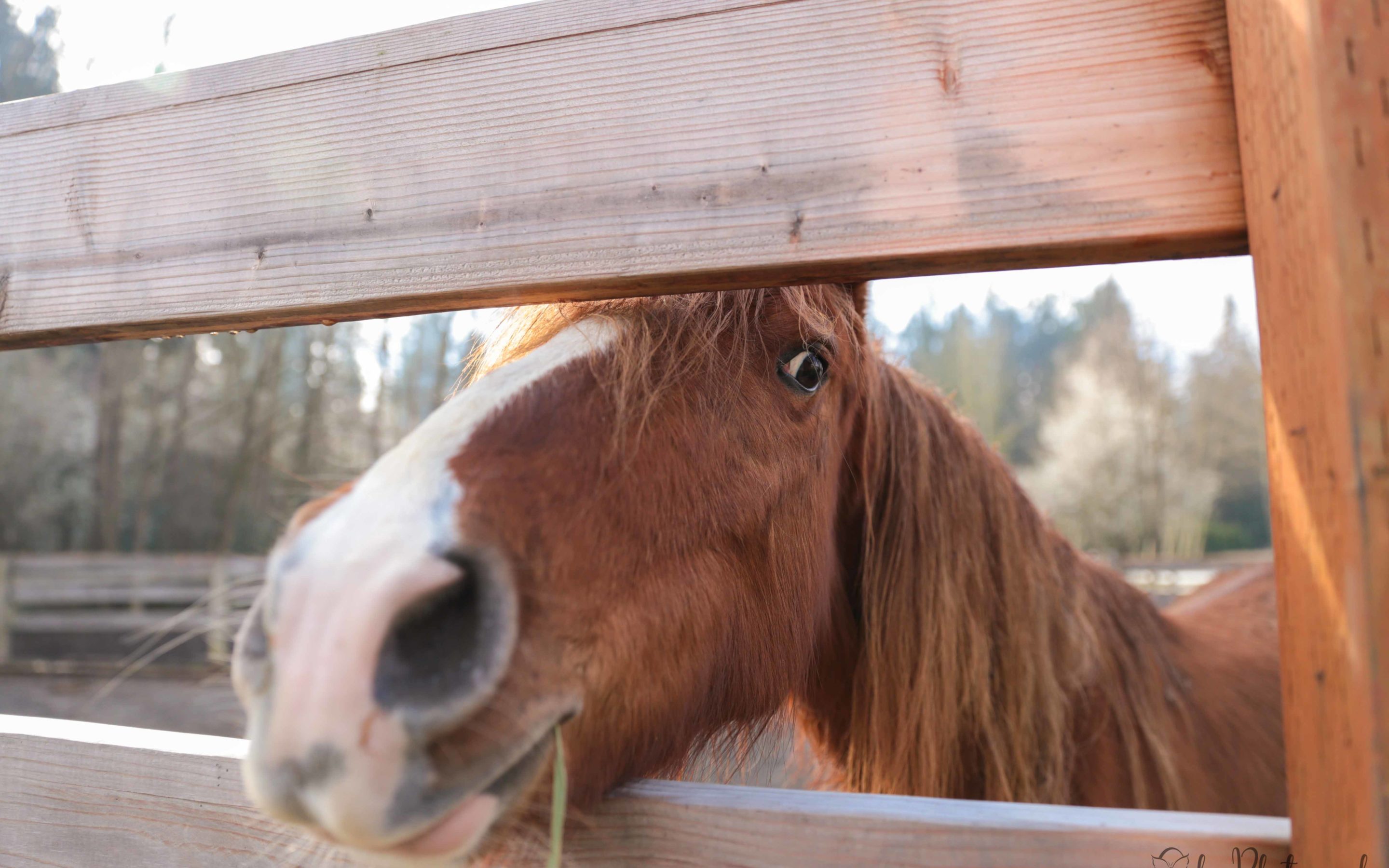
Fall City 40 Update
We started back in June with 40 horses…and we could not be happier that 30 of those horses are now in new homes, getting the care they need and deserve. That leaves ten horses who still need homes. You’ll notice that on the last update, we said that 11 horses are still available…things have REALLY slowed down with placing these horses. A couple adoptions fell through…the weather got ugly…and the public’s attention turned to other matters. Of course we knew we were in this for the long haul, but it’s been a while since we’ve even seen a good application for one of these horses. We’re really hoping that things will start to pick up now that the days are getting longer again. These horses are ready to start their new lives; are you ready to take one on?
For more on the Fall City 40, visit mayday.safehorses.org
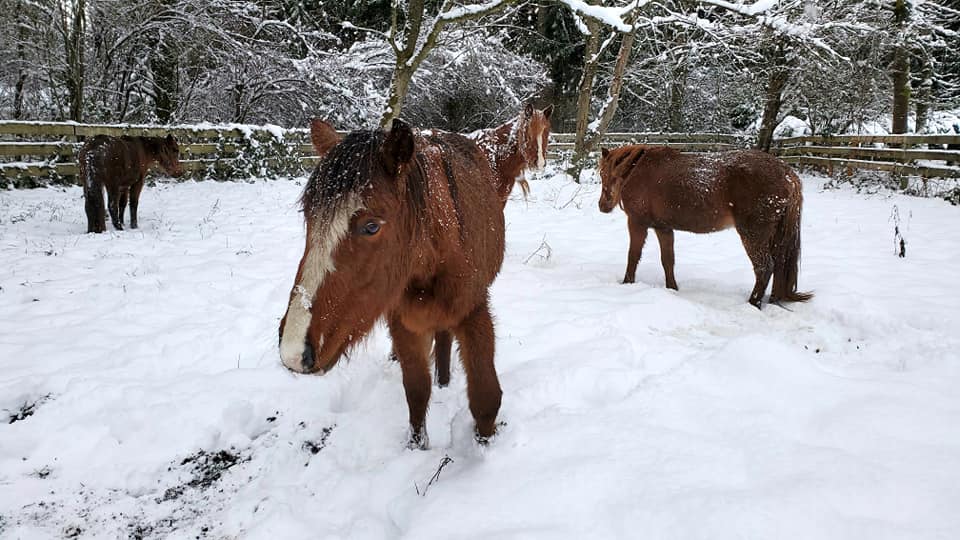
Fall City 40 Horses Update
If we’re being completely honest, taking on 24 wild horses in the dead of winter seemed like an impossible task, even to us. But we have successfully placed 11 of the seized horses into good homes with experiences handlers, and two more leave this week. That leaves 11 horses that are still available for adoption. Six of these horses are in foster homes where they are being handled, gentled, and halter-started. The other five are now at SAFE. We have handsome stallion Arty Shaw, and a group of four fillies. All five are getting accustomed to the presence of humans. They’re shy, but we’re encouraged to see that all of them are curious and interested in interacting with us. We’ve also noticed something wonderful: now that the four young mares do not have to worry about getting enough to eat, they spend time together playing like little kids. Here are some videos we captured during the recent snow:
Homes for the remaining 11 horses are still needed. If you have experience with unhandled, wild horses, please consider giving one of these beauties a home! Submit an adoption application here Adoption Application
Fall City 40 Update
It’s been about a month since the remaining Fall City 40 horses were seized in Enumclaw. These 24 horses have all been signed over to SAFE now, so we have full responsibility for their housing, feeding, and vet care, and we are taking steps to find homes for as many of them as possible. We are so grateful for the support we are receiving from this community to help us manage this huge rescue effort! It’s a lot of work, but with your help, we are making big changes for these horses!
Keep up to date with the horses at their website: http://mayday.safehorses.org
With regular feeding, the horses are starting to look and feel a lot better. There are some really nice looking horses in this group with cute markings and decent conformation. We’ve even discovered some unexpected athletic ability (like jumping!) in one or two of them. Most of them at least seem open to the idea of sharing the world with humans, and are becoming more gentle already. Wild horses are a challenge, to be sure, but most of these horses were born into this herd, not in the wild, but not exactly in captivity either. So we hope the young ones especially will make an easier transition from wild to domesticated.
As of this moment, six of the 24 horses — four mares and two colts — have been moved to new homes. Several of the remaining horses are in the process of being sent to foster care with experienced trainers for gentling, which will make them much easier and safer to place into adopt. All of the stallions will soon be gelded, and we’re finding adopters who can take in mares who are likely to be pregnant. Progress is being made.
But this is a tough time of year to be placing horses, and these are horses who are especially tricky to place. So we still need our community’s help with this rescue effort. Specifically, what we need includes:
• adopters who have experience with wild, unhandled horses
• trainers willing to foster and gentle one of these horses so we can place them more easily
• donations for the considerable cost for care, feeding, housing, vet costs, and transport of these horses
• people keeping an eye out for the missing mare, stolen by the owner, and for other groups of horses possibly owned by the same individual
We’ve also received some questions about the group of horses located in Auburn WA that were owned by the same person who owned the Fall City Forty. Those horses, about 50 in all, now belong to the owner of the Auburn property, and she is offering them for sale at $800 per horse to try to recoup her losses. There are several ponies, mini horses, and foals in this group, several colored horses as well. We believe that these horses came from feedlots and auction houses, so they are not wild horses. But they have not received much handling in the last year, so they will still need gentling and training. If you are interested in buying one of these horses, contact Dee Bowman at BnGRanchLLC@gmail.com SAFE has offered to cover the cost of gelding any of the stallions in this herd on behalf of their new owners.
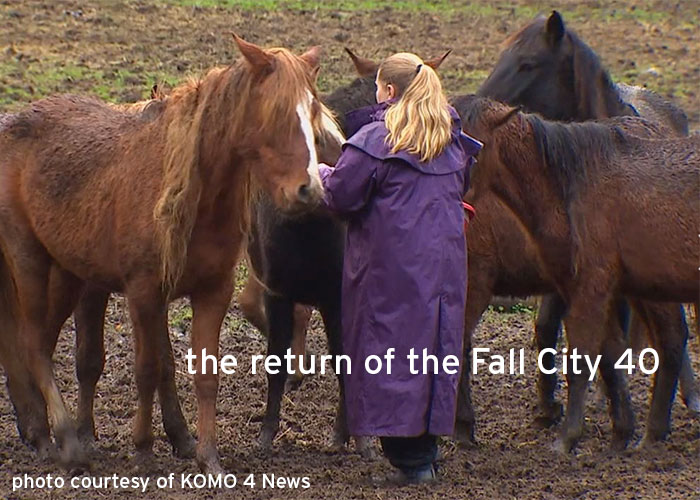
Horses Rescued in Enumclaw
Answers to FAQs
• yes, these are the horses we called the Fall City 40
• these horses are in a secure location, with food, water, and shelter
• these horses are in sheriff’s custody now, but will be signed over to SAFE soon
• SAFE is covering the cost of their board, feed, and vet care with money raised for the Fall City 40
• these horses will be available for adoption to people who have experience with unhandled horses
• stallions will be gelded prior to adoption and adopters will be responsible for after care
• visit http://mayday.safehorses.org for further updates
As was reported on several local news outlets over the weekend, SAFE was involved in a large seizure of horses by the King County Sheriff’s Office. At this time, all we can say is that the horses are in a safe and secure location with food, water, and shelter, and that they will be held there pending this active cruelty investigation. SAFE has taken on responsibility for the cost of their shelter, feeding, and vet needs, and is covering those costs with funds raised during the summer for the rescue of the Fall City Forty. We are accepting donations to our general fund for ongoing needs of all the horses in our care. We thank you sincerely for your support with this operation and your sincere concern about the well-being of these animals.
If you know the location of any other horses belonging to the individual mentioned in the news stories below, please contact us immediately, and we will pass that information on to the King County Sheriff. It’s vitally important that any remaining horses belonging to this person are tracked down and accounted for. Thank you for your help with this effort!
More information on this case:
KIRO TV story: https://www.kiro7.com/video/?id=4802680
KING TV story: https://www.king5.com/article/news/local/king-county-horses-rescued-enumclaw/281-c4c10b75-cdba-4d28-bf0a-db34d75a1176
KOMO TV story: https://komonews.com/news/local/22-horses-seized-as-king-co-investigates-nonprofit-for-animal-cruelty
Q13 TV story: https://q13fox.com/2019/12/09/22-horses-rescued-from-horrid-living-conditions-in-enumclaw/
Redmond Reporter: More than 100 horses are being hoarded by a nonprofit in Puget Sound
Redmond Reporter: More than 100 horses are being hoarded by a nonprofit in Puget Sound
Under guise of nonprofit caring for rescued horses, allegations of animal cruelty arose.
By Aaron Kunkler and Ashley Hiruko
Friday, September 6, 2019 8:30am
No one really knows how many horses Sharon Hunter has. Hunter, who owns and operates the Hunters Wind Wild Horse Rescue, had as many as 120 horses in two separate herds at one time. She stowed them on properties in Puget Sound counties.
Hunter’s Redmond-based nonprofit was founded in 2015, with just more than a dozen rescued horses from the Yakama Nation reservation in Eastern Washington. Since then, several of her horses have been seized by authorities alleging neglect in three counties, and in two counties horses have been euthanized. Horse advocates believe she may have more.
The nonprofit’s impact can be felt beyond the mossy pastures of King, Snohomish and Pierce counties. It stretches across the country to horse rescues in the Louisiana flatlands and in the dusty kill pens of Texas — the last stop for unwanted horses before slaughter.
Whether Hunter’s nonprofit is a net positive depends on who you ask.
(When contacted by phone for this story, Hunter hung up. She did not answer a follow-up phone call and an email received no reply. The civil attorney representing Hunter has not returned a request for comment as of the Reporter’s deadline.)
A Good Start
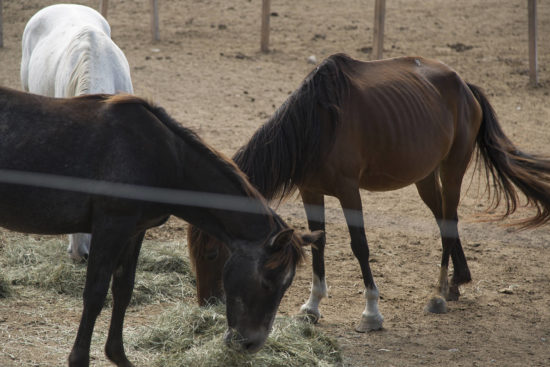
One of Hunter’s herds, located in King County, is fed a batch of hay. Horses, like these, are being housed on properties in numerous counties. Landowners allege that their owner hasn’t provided enough food or medical attention. Ashley Hiruko/staff photo
Hunter originally appeared in pages of the Redmond Reporter in 2015, when she started rescuing horses with her daughter Brandelyn and her son-in-law Joe Tafoya. Hunter’s family had been rescuing horses for about two decades and in 2015, Hunter took in 13 wild horses from the Yakama Nation reservation.
Before they were rescued, the horses were slated to be shipped abroad — either to Canada or Mexico — and slaughtered for their meat, Hunter said. And the conditions the horses faced in the industry’s kill pens were horrific. While Hunter was originally planning to take in two horses, she ended up rescuing 13.
The horses arrived in generally poor shape, and the family said they provided medical care. Two mares arrived pregnant, but one of the colts didn’t survive. It had been born with too many health problems, Hunter said.
“He had lots of love,” she said in 2015. “We named him Black Beauty.”
Hunter’s plan at the time was to rescue, rehabilitate and release the horses. She said she was working on securing a 14,000-acre plot of land in Oregon for a horse sanctuary. Joe Tafoya was trying to get Washington state to permenantly end horse slaughter and close the kill pen industry pipelines.
But at some point in the last four years, the relationship between the Tafoyas and Hunter soured and the herd multiplied. Joe Tafoya said he and his wife no longer have regular contact with Hunter.
“My wife and I continue to rescue horses on our own privately. When [the Reporter published] the article, Sharon had actually just brought those 13 horses on my property and we were trying to get involved to help. Shortly after, we figured out that we wouldn’t be able to help or work with her,” Joe Tafoya said in an email.
By 2019, Hunter’s herd had swelled in size to at least 120, with known herds at a spot in Snohomish County and one in Auburn. Another was in Fall City this summer, before being relocated to Enumclaw. At least one cluster was in Pierce County. Court documents from King and Snohomish counties indicate that several of the horses also were purchased from kill pens before they could be slaughtered abroad.
Kill Pens
Far from the Pacific Northwest, Angels Grove Ranch sits in the wooded southeast of Louisiana — about an hour’s drive north of New Orleans, across the Lake Pontchartrain Causeway. Court documents show that Hunter had boarded 10 horses with Lisa Massimini’s Angels Grove Ranch and Horse Rescue.
Massimini said horses she boarded, belonging to Hunter, were brought over by someone previously boarding them in Texas.
An investigation report from King County stated that a detective contacted Massimini, who said Hunter had made a down payment for boarding and care of the horses in August 2017. Between that time and the end of January 2018, she said she hadn’t received any additional payments during the five months of care. Eventually, Hunter paid the boarding fees and the horses were picked up by a hauler from her Louisiana ranch.
“I don’t really know where they went after me,” Massimini said.
Several of Hunter’s horses originally came from the south, and in particular Louisiana and Texas. Both states have notable horse kill pens that funnel horses to be slaughtered abroad. The U.S. essentially outlawed the practice of slaughtering horses about 12 years ago when the U.S. Department of Agriculture’s annual funding to inspect domestic horse slaughter facilities was cut. The soft ban requires annual approval from Congress, which has been renewed each year except two.
The soft ban basically prohibits the USDA from inspecting horse processing plants, and meat can’t cross state lines without the inspections. But instead of ending horse slaughter, it simply created an industry known as kill buying — where buyers pick up unwanted horses and ship them to either Canada or Mexico. Across the border, they are slaughtered for meat.
Many of Hunter’s horses may have been bought with the intention of saving them from kill buyers, including the ones Hunter seemed to have purchased and then boarded at Massimini’s rescue. Snohomish County court documents list some of Hunter’s horses as coming from Bastrop, Louisiana, home to what Massimini called a notable kill lot.
“Really if you want to dig deep … It’s people like Sharon that are trying to get horses so they don’t cross the border and they don’t die,’” Massimini said.
However, Massimini said she was unaware of what Hunter did with the horses in Washington state, or how the herd Massimini boarded was treated when they left her care.
Craig Downer runs The Wild Horse Conspiracy, a Nevada-based organization focused on preserving wild American horse lineages. Downer wrote a message in support of Hunters Wind Wild Horse Rescue on Facebook, which was shared by the rescue.
When contacted by the Reporter, Downer said he hadn’t seen the herd in person, but was particularly interested in the Yakima horse lineage. Proper breeding, he said, was essential to preserve the herd’s genetics. Downer said he learned of Hunter’s rescue after she reached out to him on social media some years ago.
“I don’t claim to really know for sure,” Downer said. “Her heart seemed to be really for the horses… that was like No. 1, and (she was) willing to sacrifice her own comforts and money and everything to help these horses. I do believe that.”
The Humane Society tracks horses that pass through kill pens to be slaughtered abroad. In 2018, about 80,000 horses met that fate, with most heading to Mexico, said spokesperson Keith Dane. A horse can fetch some money, but mostly nets less than $1,000 a head from a slaughterhouse.
Kill pen operators often market the horses to concerned horse owners and rescues before shipping them off. Kill pen operators give people an ultimatum: buy the horse or let it get packed onto a crowded truck and slaughtered abroad for a profit.
While the low price for a horse sent to slaughter means it’s not a terribly lucrative industry, about a dozen large operations exist, Dane said. Smaller operators are working across the country too.
“The Midwest is sort of like the epicenter of where these kill pens are located,” he said.
The Humane Society supports the Safeguard American Food Exports Act, which if passed by Congress, would permanently outlaw horse slaughter in the United States and prohibit shipping horses abroad to be slaughtered. Dane argued that horses currently slated for slaughter could find homes in the United States. Dane points to the fact that in 2012, about 160,000 horses were being shipped to slaughter, twice as many as last year. If the United States could handle those 80,000 horses, it could provide for the other half, he said.
Other groups, such as the Animal Welfare Council, have penned opinion pieces questioning whether laws like the Safeguard American Food Exports Act would help.
“Surely swift humane euthanasia at a [government] regulated and inspected processing plant is a kinder end than starving to death,” the council wrote on its website.
It’s worth noting, however, that both Massimini and Downer said they were unaware of the felony animal cruelty charges Hunter is facing in King and Snohomish counties (as many as 10 charges). Pierce County also has an active investigation looking into Hunter.
Abuse Allegations
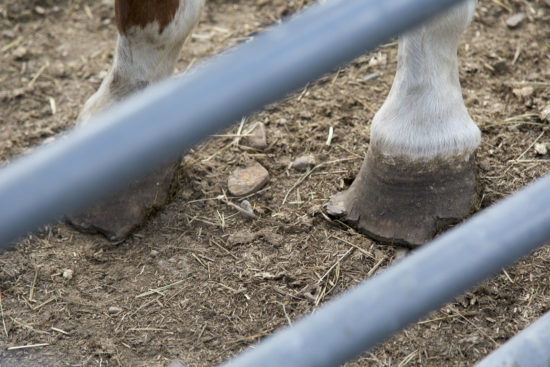
Horse hooves need to be trimmed on a regular basis and is a major task involved with horse management. Improper management of a horse’s hooves can lead to lameness. Ashley Hiruko/staff photo
On Feb. 5, 2018, Snohomish County Animal Services received a complaint about six troubled horses located on a property off of 153rd Avenue Southeast, about halfway between Maltby and Duvall. The report was made by the daughter of landowners who said they were approached by Hunter to board and lease at their pasture and barn. At first, two miniature horses and two full-size horses were brought to the property in January 2018.
The landowner had concerns about the animals’ health and asked Hunter to have a veterinarian visit. Court documents allege Hunter failed to do so. Animal control services obtained a search warrant, which allowed a veterinarian to examine the then six horses alongside law enforcement.
One pony named Lil Patches was found lying in his own feces and urine, unable to stand. The black-and-white pony was severely underweight and had chronic, untreated laminitis (an inflammation of the foot). The pony only stood on his own after receiving pain medicine.
Snohomish County seized Lil Patches, along with Miracle, a quarter horse mare with an untreated old wound that developed excessive tissue and blood vessels. Authorities also took Goldie, a palomino mare who was also severely underweight. It appeared Goldie was anemic and had a skin infection covering her entire body. These horses needed immediate medical attention, according to Snohomish County District Court documents.
The other three horses — Warrior, Willow and Princess — were in somewhat better shape and stayed on the property.
Snohomish County Animal Services manager Debby Zins said one horse was euthanized because of her condition. Another of the seized horses was initially rehabilitated and adopted out, but wound up being euthanized too. Only the third seized horse is still alive.
After the Snohomish County action, Hunter disappeared with her remaining three horses, moving them off the property to an unknown location, Zins said. The Snohomish County horses were originally moved to the 153rd Avenue site to avoid scrutiny from King County law enforcement, following a civil citation for animal cruelty, she added.
“We encourage anyone who knows where she is keeping horses, or if anyone has any of her horses or is concerned for her horses’ care, to please reach out to their local animal control agency,” Zins wrote in an email.
Later that month, Hunter was charged with six counts of second-degree animal cruelty in Snohomish County. If convicted, the felony counts would bar her from owning horses for a length of time determined by a judge. Her trial is scheduled for this month, but a continuance is possible.
Zins said she believes Hunter’s horse-centered nonprofit doesn’t function like others, in which horses are rehabilitated and then adopted out. Zins is only aware of Hunter collecting horses.
“Sharon Hunter is horse hoarding. Hoarding cases are complex and it is very difficult to break that cycle. She appears to be dedicated to her purpose, but is ill equipped to care for the animals and as a result many horses are neglected and suffering,” Zins wrote.
King and Pierce County Horses
Tim Anderson, lead animal control sergeant for Regional Animal Services of King County (RASKC), has been investigating Hunter’s Auburn herd of about 80 animals. The herd is in addition to another, known as the Fall City 40, which was moved to Enumclaw, and the Snohomish herd.
On Aug. 2, King County investigators moved in to inspect the Auburn herd, housed on a roughly 17-acre property. Four horses were ultimately seized.
Following that, Anderson said four civil notices of violation were issued on Aug. 17 for $500 each. The citations acted as the basis of four counts of second-degree animal cruelty charges recommended to the King County Prosecuting Attorney’s office on Sept. 1, Anderson said. However, the Reporter was not able to confirm those charges at the time of publication with the county prosecutor. If the charges are confirmed, it would bring the total number of felony charges Hunter is facing to 10.
In addition, Anderson said, a separate notice King County served Hunter on Aug. 17 would bar her from possessing horses within county lines for four years. She has about a month to comply or appeal. If not, Hunter could be fined $1,000 per day, per horse that is found in King County.
“She certainly has a lot of horses, more horses than she appears to be able to care for,” Anderson said.
The Auburn herd has dwindled to 65 from its peak of 80 after RASKC seized several horses and others were relocated to other properties. One of the horses was euthanized.
The pastures of the Auburn property have turned to dirt, due to the 65 horses housed on about 17 acres. Horses generally require between one to two acres per animal, according to Stable Management, an equine professional resource.
At the Auburn site, the horses are separated by sex and type, and within the last few weeks the property owner has begun supplementing and eventually fully feeding the horses. Many of the horses have cracked or chipped hooves and are in need of farrier services, dental work, de-worming and general vet care.
The Auburn property owner, who asked to remain anonymous due to fears of compromising ongoing legal matters, said Hunter had originally asked to pay rent and board for 12 horses on the property during spring 2018, a number that steadily ballooned to more than 80 by earlier this year. She said Hunter has intermittently provided the horses with food, but not enough to fully feed the large herd. Little headway has been made on relocating the horses, the property owner added.
“She has not adopted one horse out during the whole time,” she said. “When she starts getting in trouble she starts moving them around.”
Bonnie Hammond, executive director of the Redmond-based nonprofit Save A Forgotten Equine (SAFE), said they were willing to step in if the horses were declared abandoned, following a 15-day waiting period. However, on Sept. 3, the property owner said that Hunter was planning on removing the horses over the following days. During a phone interview with the property owner on Sept. 3, more King County animal control officers were onsite inspecting another horse that appeared malnourished.
While they can inspect, there’s little animal control can do under existing state or local laws to prevent someone from owning an abundance of horses. Law enforcement can only get involved when there are reports of animal cruelty or neglect, as animal control agencies in King, Snohomish and Pierce counties allege is the case with Hunter.
Owning too many horses comes with financial and time burdens. For example, SAFE’s program only accepts 30 horses at a time. And to care for that many horses the nonprofit requires 140 volunteers, five paid staff and a budget of about $650,000 each year, Hammond said.
SAFE has been involved in stepping in to care for several of Hunter’s herds, including the one in Auburn.
“Horses are hard to take care of and you need a lot of people, a lot of money, a lot of resources to properly take care of large groups of horses,” Hammond said.
In Pierce County, Animal Control supervisor Brian Boman said four horses were seized. Details are scarce during the ongoing investigation, but they are also Hunter’s horses.
Fall City 40
The Fall City 40 herd grew from the group of 13 wild horses previously housed just east of Redmond in 2015. At some point afterward, the horses relocated to the Johann family property in Fall City, a small town west of Snoqualmie. Jamie Johann-Barney is the daughter of the aging property owners, and said Hunter initially approached them by walking up their driveway and asking if they could board horses there.
Johann-Barney said the horses weren’t properly cared for and says her parents lost significant amounts of money boarding the horses. In June, she and others staged what Johann-Barney called an intervention, asking her father to get rid of the horses.
Law enforcement wouldn’t intervene, she said. Officers told them that since the family initially agreed to board the horses without a contract, it was a civil matter. SAFE, which later got involved, said the horses were allowed to breed freely, were not being fed, not receiving veterinarian or farrier care and not being adopted out.
“It was horrible,” Johann-Barney said.
According to SAFE’s website, the Johanns wanted the horses gone, but Hunter wouldn’t remove them. The Johanns sent a notice to Hunter in June saying she had 15 days to remove the horses or they would be considered abandoned. When the horses weren’t removed, the Johanns contacted SAFE, which helped get the horses healthy and assisted in their adoption.
The nonprofit provided hay, photographed and cataloged the herd, and tried to attract adopters, according to a post on the organization’s website that was also confirmed by Hammond.
Of the 40 horses, 15 were adopted out to new owners. But then an attorney representing Hunter served the Johanns with a cease and desist letter, demanding they stop trying to adopt out the horses. Hunter was also seeking to reclaim the horses in the letter. In the face of a possible lawsuit, the property owners decided to let Hunter remove the remaining 25 horses. Hunter also sent SAFE a similar letter demanding the 15 horses back that had been adopted. SAFE declined.
The remaining 25 from the herd were moved to another location, likely in Enumclaw, Hammond said.
“The truth is that she’s got groups of horses that she’s just shuffling from one place to another. Either she gets thrown off a property, or law enforcement’s getting too close or what have you,” Hammond said. “She’ll tell stories about saving America’s wild horses and all this really romantic stuff. But in truth, she’s just stockpiling them and they sit and they fight with each other and the stallions breed with the mares.”
Hammond was clear in what she would like to see happen.
“I would like her to stop acquiring horses,” Hammond said. “She needs to stop doing this and the scary thing is, there’s still plenty of horses out there. She could get them from the auctions by the truckload.”
A Hard Question
The situation presents a complex question: Is it better to let a horse bound for slaughter to die, or be adopted by individuals or organizations that are not fully equipped to care for the animals?
On the Auction Horses website, a plea is made. The message stands out from the rest of the content. Written in a bold font, in red letters at the top of the website, it reads: “Please NO fundraising for the purchase of horses.”
For Auction Horses, a Washington- and Oregon-based network of people who work to prevent the auction and slaughter of the animals, the message is an important one for the betterment of the animals, advocates say.
“People think, ‘Oh I’d like to give $20 to this good cause’…but if they don’t know where the horse is going and don’t know the person or their resources available to take care of the horses, they have no idea of the kind of situation they’re contributing to,” said Tash Johnson with Auction Horses.
Caring for a horse is a heavy endeavor. Costs are typically in the hundreds per month, and if the animals aren’t fed enough and their feet trimmed every six to eight weeks, horse health can decline.
“If you have 120 horses and you’re trying to feed them and take care of them, it’s an incredibly difficult task,” Johnson said. “Even taking care of them with staff.”
And things can get much worse in the winter, she said, when horses need extra food in order to stay warm and rain turns their pastures into mud pits. Attempting to move large bales of hay — generally 50 and 100 pounds each — becomes difficult in the rain, and hooves not properly cared for can become infected from feces on the ground.
“That’s what happens to neglected horses in Western Washington,” Johnson said.
She learned of Hunter when she relocated some of her horses to Redmond. Johnson’s horses stayed on a property nearby. Johnson said seeing a herd of horses with intact stallions and no separation from mares raised red flags.
When the man whose property Hunter’s horses were staying on started asking for help on the Auction Horses website, the red flags turned into “full-scale alarm,” Johnson said.
But she said having animals shipped off to slaughter is an “absolute failure.”
Johnson has seen every kind of horse end up on feedlots, the final stop before the slaughter: Champion horses sold when the summer ends by owners avoiding financial support during the winter; trail horses; best-of-the-best show horses; brut mares that could no longer get pregnant; ponies and draft horses and even young, healthy horses that went untrained.
She said the best practice for those concerned about the animals’ well being is to prevent them from getting to pens in the first place. Once there, the horses can become injured as they are mingling with dozens of other animals. And illness is brought in from different places. Johnson described the transportation of horses to slaughter, the way they’re handled, loaded into crowded vehicles and the slaughter pipeline as “horrific.”
“Rescue horses from Craigslist or posted on feed boards,” she said. “Save them before the kill pens. Once they’re in the kill pen, if there’s a good home for them, by all means save them. But if there isn’t, honestly, I would rather see them go to slaughter than suffer.”
Link to article online: http://www.redmond-reporter.com/news/more-than-100-horses-are-being-hoarded-by-a-nonprofit-in-puget-sound/
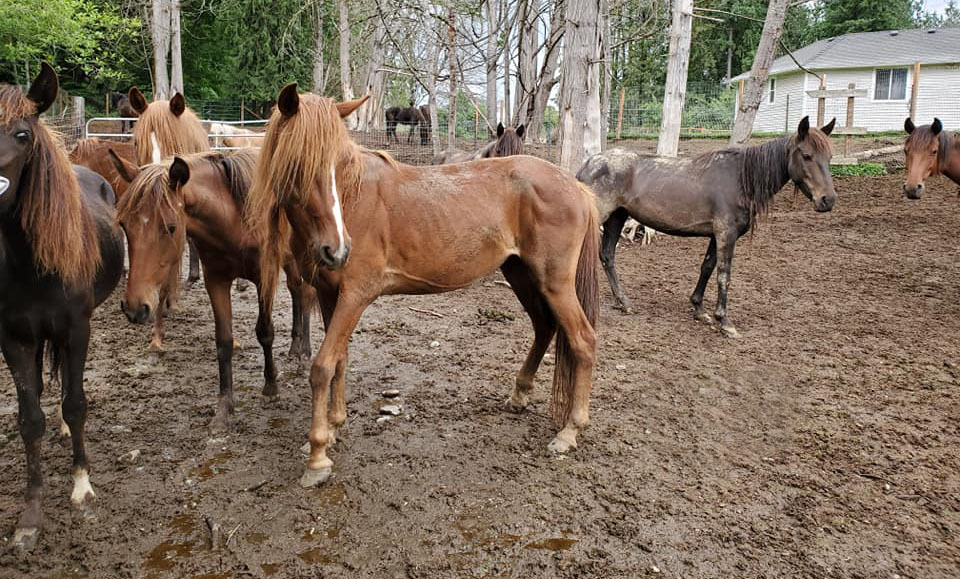
Fall City Forty: the Full Story
We’ve had to stay pretty quiet about the situation with the Fall City Forty for two reasons. One, because we were being threatened with legal action for our involvement in this rescue mission; and two, because we were holding out hope that we would be allowed to return to the Fall City property and continue caring for these horses. We feel it’s time to let our community know what happened, and what is continuing to happen.
First, some background. The horses we called the Fall City Forty were wild horses, originally rescued from Yakima. There were between 14 and 23 horses in the original herd, but because stallions and mares were turned out together and allowed to breed freely, the herd grew in size to the 40 that we encountered last June. While the owners of the Fall City property had originally agreed to let some horses live there temporarily, the situation had grown well out of hand: horses not being fed, not receiving vet or farrier care, not being gentled, handled, or trained, not being adopted to new homes. These horses were just being stockpiled, and all the while their owner was collecting more and more horses from auctions and feedlots.
The property owners wanted the horses gone, but their owner would not remove them. In late June, the property owners had a lawyer send notice to the horses’ owner that they had 15 days for the horses to be removed, after which time they would be considered abandoned under the law. The horses were not removed within the time allowed. The property owners then invited SAFE to come in and assist them in finding new homes for the 40 horses.
On behalf of the property owners, SAFE came in and began working with the horses. We had tons of hay delivered to the property so the horses could be fed 2–3 times per day. We photographed and cataloged the herd, and put the word out that we were looking for people who had experience with unhandled horses who might be willing to adopt them. And we began taking first steps toward gentling these wild animals and helping them become accustomed to being around humans.
Public support for this rescue effort was tremendous. Over 350 people made donations to help these horses and we received adoption applications from more than 40 people. We carefully selected those that that had prior experience working with wild, unhandled horses, and who had the resources necessary to provide regular and sufficient feed, veterinary and farrier care, and training. We conducted phone interviews with candidates to learn more about them and pair them with suitable horses from the herd. We did reference checks with veterinarians, trainers, and personal references. And we evaluated the suitability of new homes with photos and videos taken on site.
One week after we began working with the Fall City horses, a cease and desist letter from an attorney representing the horses’ previous owner was delivered to the property. The letter was addressed to both the property owners and to SAFE, and demanded that we cease our rescue efforts immediately. Because the property owners had taken the necessary steps to establish the herd as abandoned, we were not overly concerned about the cease and desist demands. But for our protection, we hired the same lawyer who drafted the 15 day demand letter for the property owners to represent SAFE, and we continued with our work on their behalf.
The next week, with the help a wonderful group of horsemen and women, we began preparing these horses for the next step in their journey towards better lives. Over the course of two days, 15 of the 40 horses were safely and calmly loaded onto trailers and sent off to new homes. Those who stayed behind continued to be gentled. We began strategizing the best and safest way to geld the many mature stallions who remained. This itself was not an easy problem to solve, but given time, we were confident that these stallions would no longer be capable of bringing more unwanted horses into the world.
It turned out that time was the one thing we no longer had. With the rescue operation in full swing and great progress being made, we were informed that rather than risk a lawsuit, the property owners had decided to try to settle with the horses’ former owner, and allow that individual to take the horses back. Although they were satisfied with the work that SAFE had done and the incredible progress we had made in a very short time, the property owners were no longer willing to fight for the well-being of these horses.
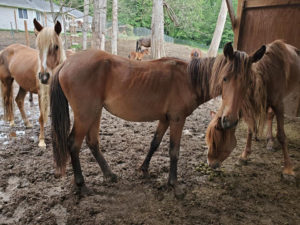 This was a crushing blow. It wasn’t just the work or the money that we put into this rescue effort. We’d come to care a great deal for these horses. We’d gotten to know them, given them names to suit their personalities, and started to earn their trust. We were deeply invested in helping all of them get new homes where they’d no longer go hungry. And we were SO CLOSE. The horses were getting healthy with regular feedings. We were winning the confidence of the shyest among them. We had more approved homes for them to go to, with people who genuinely wanted them. It was all going so well…and then it all came to a crashing halt.
This was a crushing blow. It wasn’t just the work or the money that we put into this rescue effort. We’d come to care a great deal for these horses. We’d gotten to know them, given them names to suit their personalities, and started to earn their trust. We were deeply invested in helping all of them get new homes where they’d no longer go hungry. And we were SO CLOSE. The horses were getting healthy with regular feedings. We were winning the confidence of the shyest among them. We had more approved homes for them to go to, with people who genuinely wanted them. It was all going so well…and then it all came to a crashing halt.
Immediately after the property owners gave up the fight, the attorney representing the horses’ owner came after SAFE, demanding the return of the horses that had been placed on behalf of the property owners and threatening lawsuits against us if we did not comply. We did not comply.
As for the rest of the Fall City horses, we held out hope until the very last minute that somehow we would be allowed back in to help them. But it was not to be. Our attempts to convince the horses’ owner to allow us to find new homes for the Fall City horses were ignored. And last week, their owner was able to move them to a new property. They remain in King County. They’re back to having to rely on their owner for care. Maybe this time things will be different…but based on past history, we remain very concerned about the well-being of these horses, and the many other horses owned by this same individual.
Thanks to the many people who helped with the Fall City Forty, we can take comfort in the fact that 15 of those 40 souls are safe. There is another large group of horses on a property in Auburn belonging to this person and we’re told that they are in the process of being evicted. So if you or someone you know is approached by someone looking for help to quickly move a large group of horses, please feel free to contact us for advice.
Artie’s Friends:
1. Ana Lucia H.
2. Kim D.
3. C.C. Schott
4. Barb L..
5. _____________________
6. _____________________
7. _____________________
8. _____________________
9. _____________________
10._____________________
Every horse deserves at least ten friends! Even a small monthly donation can make a difference.

